“Currency Manipulation” Will Continue, Despite G20



Only two years after the worst financial crisis in decades, the DJIA is now back above 12,000. Yield-hungry investors are pouring record amounts of cash into emerging markets. Commodities and food prices are rising into bubble territory. In fact, not a single meaningful reform has yet to be passed that would prevent such an event from erupting again. The EU, however, is trying to change that, with the proposed introduction of the first-ever Tobin tax on foreign exchange trades.
The campaign is being led by French President Nicolas Sarokozy, who happens to be the current Chairman of both the G8 and G20. Recently, he has used his podium for populist rants against the international financial system. To his credit, Sarkozy has done more than bluster. He is fighting to advance the idea for a minute tax on all financial transactions, with the aim of reducing volatility and raising money for cash-strapped governments.
The so-called Tobin tax was first proposed in 1971 by Nobel Laureate James Tobin. While it has always enjoyed support from a handful of leftist economists, it has never been seriously considered by any western country. In the wake of the financial crisis, however, anger towards speculation seems to be peaking, and some governments might finally have enough political capital to push forward the idea. In fact, France has already obtained the tepid support of other EU members, notably Austria. In addition, the Economic and Monetary Affairs Committee of the European Parliament has backed the idea. The EU is fighting to keep the Euro alive and its member states solvent, and it clearly resents the (perceived) role of speculators in betting on default and breakup.
Proponents of the Tobin tax generally cite the amount of revenue it could raise as its chief benefit. For example, it has been estimated that a .005% on forex transactions could raise $26 Billion worldwide, while a .05% tax on all financial transactions could generate as much as $700 Billion in revenue. Even though studies suggest that it wouldn’t do much to reduce volatility (and perhaps speculation), the fact that it shouldn’t destabilize markets is enough to satisfy some of its naysayers.
Not surprisingly, the US remains opposed to such a policy, on the grounds that it could “send misleading signals that could hamper investment to end extraction and cause production bottlenecks.” This kind of incantation rings hollow, however, and it’s clear that the biggest obstacle to its being implemented is almost certainly the bank lobby, which has insisted that a Tobin tax would “cause serious damage to this highly efficient [forex] market.”
Personally, I’m a cautious advocate of the Tobin tax. At .005%, it would levy $10 on every round-trip lot ($100,000) forex transaction. This would punish those that engage in leveraged account-churning and computerized, rapid-fire trading, without impacting those that take a longer-term approach to forex. In addition, it would impact institutional traders and investment banks (which currently monopolize all financial markets) much more than retail traders. Then again, they would probably just shift more of their trading into unregulated, private markets.
At this point, the Tobin tax is still probably a long-shot. The fact that it’s being seriously considered, however, is nothing short of remarkable.

Last week, the Obama Administration released its fiscal 2012 budget to much fanfare. Unfortunately, the budget makes only a token effort to address the rising National debt, and forecasts a budget deficit of $1.1 Trillion. While the release of the budget failed to make a splash in currency markets, traders would be wise to understand its implications for the future.
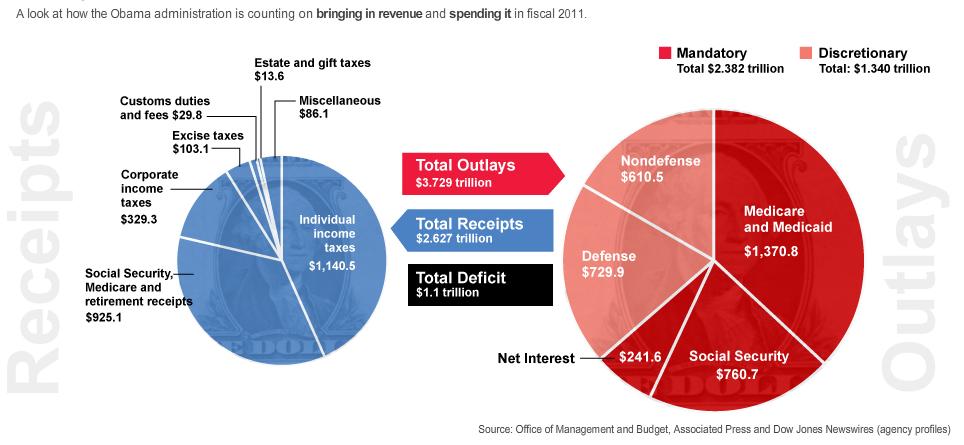
The budget proposes spending of $3.7 Trillion in 2012, and forecasts receipts of only $2.6 Trillion. As usual, entitlements (Social Security, Medicare, and Medicaid: $2 Trillion+), Defense ($760 Billion), and net interest on debt ($250 Billion) are projected to consume the brunt of spending. The Departments of State, Education, Energy, and Veterans Fairs will receive an increased allocation, while almost all other Departments face drastic cuts. (For more comprehensive breakdowns, the WSJ and NY Times offer excellent graphical representations of how the federal budget is funded and disbursed).
The proposed budget allows for a deficit of $1.1 Trillion (7% of GDP), which unbelievably represents a significant decrease from the $1.6 Trillion (11% of GDP) that is projected for fiscal 2011. The Congressional Budget Office (CBO) forecasts the deficit to return to a more “sustainable” level of 3% of GDP beginning in 2014, which should allow the national debt to remain constant in relative terms for the following decade. Beginning in 2021, however, entitlement spending is projected to skyrocket, which would cause debt to rise similarly.
CBO projections are based on a handful of rosy assumptions. First of all, it assumes that the US economy will grow at 3%+ for the indefinite future. Second, it assumes that deficit spending can be financed at reasonable interest rates. Third, it assumes that tax receipts will rise from current lows and revert back to historical levels. Given the ongoing economic uncertainty, high unemployment rates, tax cuts, rising interest rates, the difficulty of cutting spending, etc., there is reason to believe that actual deficits will be even higher.

In fact, net interest payments on national debt will rise 33% over the next year even as Treasury rates remain at record lows. If the economic recovery gathers momentum (something that the budget is counting on), risk appetite and interest rates must rise. In addition, given that the national debt will probably double from 2009 to 2012, it seems likely that investors will demand an increased risk premium for lending to the US. On the other hand, demand for Treasury Securities continues to remain strong: “Net long-term securities transactions showed total buying of $65.9 billion in long-term U.S. securities in December, after purchases of $85.1 billion the month before.” Many Central Banks continue to be net buyers.
In addition, there are some commentators that think the Fed will abet the US government in deflating the real value of its debt. Since the majority of US Treasury Securities are not inflation-protected, 15 years of high inflation (~5%) would be enough to decrease the real debt burden by half. Especially when you account for “contingent obligations,” this might be the only feasible way for the government to deal with its debt burden over the long-term. Then again, higher inflation would probably drive proportional increases in yield, such that the Treasury Department would have a tough time rolling over existing debt (let alone in issuing new debt) at reasonable interest rates.
The main variable in all of this is politics. Specifically, this budget is still only a proposal. The actual budget won’t be ratified for at least another six months, and only after tense negotiations with the Republican Party. (There is also the possibility that it won’t be passed at all, which is what happened with the fiscal 2011 budget). “House Majority Leader Eric Cantor, a Virginia Republican, said his party will propose ‘very bold’ changes to entitlements in their 2012 budget resolution.” Anything short of this wouldn’t dent the projected deficits and would push Social Security / Medicare closer towards the brink of insolvency.
In the end, the deficit merely represents business as usual for the US government. Barring a double-dip recession, it probably won’t be enough to seriously impact the Dollar’s status in the short-term as preeminent global reserve currency. However, that could start to change over the next decade, as the government either takes steps or does nothing to mitigate the looming entitlements crisis. At that time, the long-term viability of the Dollar (and the financial system as we know it) will become clear.

At the very end of 2010, the Chinese Yuan managed to cross the important psychological level of 6.60 USD/CNY, reaching the highest level since 1993. Moreover, analysts are unanimous in their expectation that the Chinese Yuan will continue rising in 2011, disagreeing only on the extent. Since the Yuan’s value is controlled tightly by Chinese policymakers, forecasting the Yuan requires an in-depth look at the surrounding politics.
While American politicians chide it for not doing enough, the Chinese government nonetheless deserves some credit. It has allowed the Yuan to appreciate nearly 25% in total, which should be just enough to satisfy the 25-40% that was initially demanded. Meanwhile, over the last five years, China’s trade surplus has fallen dramatically, to 3.3% of GDP in 2010, compared to a peak of 11% in 2007. In fact, if you don’t include trade with the US, its surplus was basically nil this year.
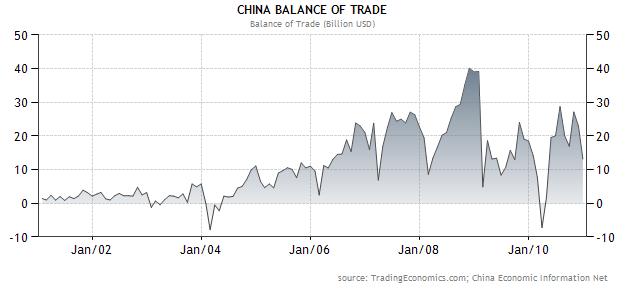 Therein lies the problem. Despite the fact that prices in Chinese exports should have risen 25% (much more if you take inflation and rising wages into account) since 2004, the China/US trade balance has remained virtually unchanged, and its current account surplus has actually widened. As a result, China’s foreign exchange reserves increased by a record amount in 2010, bringing the total to a whopping $2.9 Trillion! (Of course, these reserves should be thought of as a monetary burden rather than pure wealth, to the same extent as the US Federal Reserve Board’s Balance Sheet must one day be wound down. In the context of this discussion, however, that might be a moot point).
Therein lies the problem. Despite the fact that prices in Chinese exports should have risen 25% (much more if you take inflation and rising wages into account) since 2004, the China/US trade balance has remained virtually unchanged, and its current account surplus has actually widened. As a result, China’s foreign exchange reserves increased by a record amount in 2010, bringing the total to a whopping $2.9 Trillion! (Of course, these reserves should be thought of as a monetary burden rather than pure wealth, to the same extent as the US Federal Reserve Board’s Balance Sheet must one day be wound down. In the context of this discussion, however, that might be a moot point).
Meanwhile, China is trying to slowly tilt the structure of its economy towards domestic consumption, which is increasing by almost every measure. Its Central Bank is also slowly hiking interest rates and raising the reserve requirements of banks in order to put the brakes on economic growth and rein in inflation. Finally, it is trying to encourage internationalization of the Yuan. There now 70,000 Chinese trade companies that are permitted to settle trades in Chinese Yuan. In addition, Bank of China just announced that US customers will be able to open up Yuan-denominated accounts, and the World Bank became the latest foreign entity to issue an RMB-denominated “Dim-Sum Bond.”
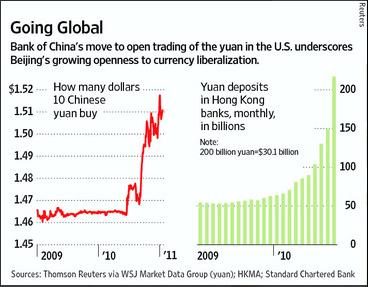
There is also evidence that the Chinese Government’s top leadership – with whom the US government directly negotiates – is actually pushing for a faster appreciation of the RMB but that it faces internal opposition. According to the New York Times, “The debate over revaluing the renminbi… has not advanced much partly because of a fight between central bankers who want the currency to rise and ministers and party bosses who want to protect the vast industrial machine that depends on cheap exports for survival.” In fact, the Bank of China (PBOC) recently warned, “Factors such as the country’s trade surplus, foreign direct investment, China’s interest rate gap with Western countries, yuan appreciation expectations, and rising asset prices are likely to persist, drawing funds into the country,” while a senior Chinese lawmaker pushed back that a “rise in the yuan’s value won’t help the country to curb inflation.”
Some analysts expect a big move in the Yuan that corresponds with this week’s US visit by China’s Prime Minister, Hu Jintao. The average call, however, is for a continued, steady rise. “China’s currency will strengthen 4.9 percent to 6.28 by the end of 2011, according to the median estimate of 19 analysts in a Bloomberg survey. That’s over double the 2 percent gain projected by 12-month non-deliverable forwards.” As I wrote in my previous post on the Chinese Yuan, however, it ultimately depends on inflation – whether it keeps rising and if so, how the government chooses to tackle it.

The “currency war” is heating up, and all parties are pinning their hopes on the G20 summit in South Korea. However, this is reason to believe that the meeting will fail to achieve anything in this regard, and that the cycle of “Beggar-thy-Neighbor” currency devaluations will continue.
There have been a handful of developments since the my last analysis of the currency war. First of all, more Central Banks (and hence, more currencies) are now affected. In the last week, Argentina pledged to continue its interventions into 2011, while Taiwan, and India – among other less prominent countries – have hinted towards imminent involvement.
Of greater significance was the official expansion of the Fed’s Quantitative Easing Program (QE2), which at $600 Billion, will dwarf the efforts of all other Central Banks. In fact, it’s somewhat ironic that the Fed is the only Central Bank that doesn’t see its monetary easing as a form of currency intervention when you consider its impact on the Dollar and its (inadvertent?) role in “intensifying the currency war.” According to Chinese officials, “The continued and drastic U.S. dollar depreciation recently has led countries including Japan, South Korea and Thailand to intervene in the currency market,” while the Japanese Prime Minister recently accused the U.S. of pursuing a “weak-dollar policy.”
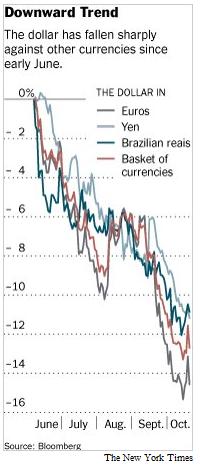
As of now, there is no indication that other industrialized countries will follow suit, though given concerns that QE2 “at the end of the day might be dampening the recovery of the euro area,” I think it’s too early to rule anything out. While the Bank of Japan similarly has stayed out of the market since its massive intervention in October, Finance Minister Yoshihiko Noda recently declared that, “I think the [Yen’s] moves yesterday were a bit one-sided. I will continue to closely monitor these moves with great interest.”
As the war reaches a climax of sorts, everyone is waiting with baited breath to see what will come out of the G20 Summit. Unfortunately, the G20 failed to achieve anything substantive at last month’s Meeting of Finance Ministers and Central Bank Governors, and there is little reason to believe that this month’s meeting will be any different.
In addition, the G20 is not a rule-making body like the WTO or IMF, and it has no intrinsic authority to stop participating nations from devaluing their currencies. Conference host South Korea has lamely pointed out that while ” ‘There aren’t any legal obligations‘…discussion among G20 countries would produce ‘a peer-pressure kind of effect on these countries’ that violated the deal.” Not to mention that the G20 will have no effect on the weak Dollar nor on the undervalued RMB, both of which are at the root of the currency war.
It’s really just wishful thinking that countries will come to their senses and realize that currency devaluation is self-defeating. In the end, the only thing that will stop them from intervening is to accept the futility of it: “The history of capital controls is that they don’t work in controlling foreign exchange rates.” This time around will prove to be no different, “particularly with banks already said to be offering derivatives products to get around the new taxes.” The only exception is China, which is only able to prevent the rise of the RMB because of strict controls for dealing with the inflow of capital.
In short, the “wall of money” that is pouring into emerging market economies represents a force too great to be countered by individual Central Banks. The returns offered by investing in emerging markets (even ignoring currency appreciation) are so much greater than in industrialized countries that investors will not be deterred and will only work harder to find ways around them. Ironically, to the extent that controls limit the supply of capital and boost returns, they will probably drive additional capital inflows. The more successful they are, the more they will fail. And that’s something that no new currency agreement can change.

I read a provocative piece the other day by Michael Hudson (“Why the U.S. Has Launched a New Financial World War — and How the Rest of the World Will Fight Back“), in which he argued that the ongoing currency wars are the fault of the US. Below, I’ll explain why he’s both right and wrong, and why he (and everyone else) should shut up and stop complaining.
It has become almost cliche to argue that the US, as the world’s lone hegemonic power, is also the world’s military bully. Hudson takes this argument one step further by accusing the US of using the Dollar as a basis for conducting “financial warfare.” Basically, the US Federal Reserve Bank’s Quantitative Easing and related monetary expansion programs create massive amounts of currency, the majority of which are exported to emerging market countries in the form of loans and investments. This puts upward pressure on their currencies, and rewards foreign speculators at the expense of domestic exporters.
Hudson is right that the majority of newly printed money has indeed been shifted to emerging markets, where the best returns and greatest potential for appreciation lies. Simply, the current economic and investing climate in the US is not as strong as in emerging markets. Indeed, this is why the (first) Quantitative Easing (QE) program was not very successful, and why the Fed has proposed a second round. While there is a bit of a chicken-and-egg conundrum (does economic growth drive investing, or do investors drive economic growth?) here, current capital flow trends suggest that any additional quantitative easing will also be felt primarily in emerging markets, rather than in the US. Not to mention that the US money supply has expanded at the same pace (or even slower) as the US economy over the long-term.
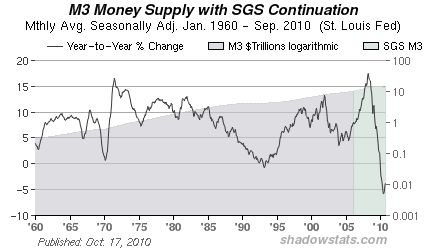
While the point about QE being ineffective is well-taken, Hudson completely ignores the strong case to be made for investing in emerging markets. He dismissively refers to all such investing as “extractive, not productive,” without bothering to contemplate why investors have instinctively started to prefer emerging markets to industrialized markets. As I said, emerging market economies are individually and collectively more robust, with faster growth and lower-debt than their industrialized counterparts. Calling such investing predatory represents a lack of understanding of the forces behind it.
Hudson also overlooks the role that emerging markets play in this system. The fact that speculative capital continues to pour into emerging markets despite the 30% currency appreciation that has already taken place and the asset bubbles that may be forming in their financial markets suggests that their assets and currencies are still undervalued. That’s not to say that the markets are perfect (the financial crisis proved the contrary), but rather that speculators believe that there is still money to be made. On the other side of the table, those that exchange emerging market currency for Dollars (and Euros and Pounds and Yen) must necessarily accept the exchange rate they are offered. In other words, the exchange rate is reasonable because it is palatable to all parties.
You can argue that this system unfairly penalizes emerging market countries, whose economies are dependent on the export sector to drive growth. What this really proves, however, is that these economies actually have no comparative advantage in the production and export of whatever goods they happen to be producing and exporting. If they can offer more than low costs and loose laws, then their export sectors will thrive in spite of currency appreciation. Look at Germany and Japan: both economies have recorded near-continuous trade surpluses for many decades in spite of the rising Euro and Yen.
The problem is that everyone benefits (in the short term) from the fundamental misalignments in currency markets. Traders like to mock purchasing power parity, but over the long-term, this is what drives exchange rates. Adjusting for taxes, laws, and other peculiarities which distinguish one economy from another, prices in countries at comparable stages of development should converge over the long-term. You can see from The Economist’s Big Mac Index that this is largely the case. As emerging market economies develop, their prices will gradually rise both absolutely (due to inflation) and relatively (when measured against other currencies).
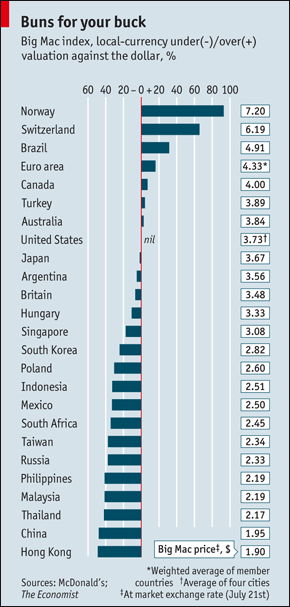
Ultimately, the global economy (of which currency markets and exchange rates represent only one part) always operates in equilibrium. The US imports goods from China, which sterilizes the inflows in order to avoid RMB appreciation by building up a stash of US Dollars, and holding them in US Treasury Bonds. Of course, everything would be easier if China allowed the RMB to appreciate AND the US government stopped running budget deficits, but neither side is willing to make such a change. In reality, the two will probably happen simultaneously: China will gradually let the RMB rise, which will cause US interest rates to rise, which will make it more expensive and less palatable to add $1 Trillion to the National Debt every year, and will simultaneously make it more attractive to produce in the US.
Until then, politicians from every country and hack economists with their napkin drawings will continue to whine about injustice and impending economic doom.

Have you ever heard currency cheerleaders rave about how unique forex is because there is never a bear market? Since all currencies trade relative to each other (when one falls, another must necessarily rise), it couldn’t be possible for the entire market to drop at once, as happens with other financial markets. The ongoing currency war might be turning this logic on its head, as currencies embark on a collective downward spiral. Profiting in this kind of market might involve exiting it altogether, and turning to Gold.
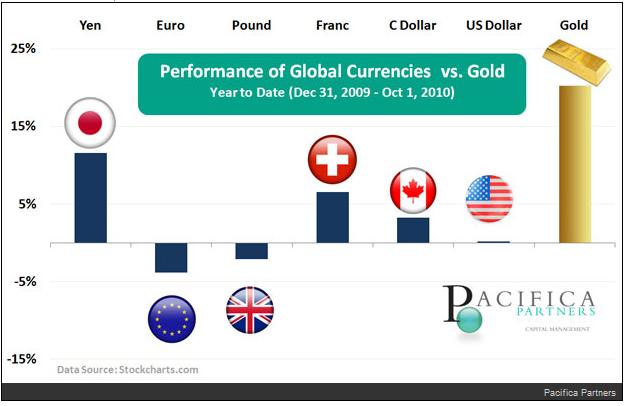
For those of you who haven’t been following this story, a handful of the world’s largest Central Banks are now battling with each to see who can devalue their currency the fastest. [Of course, this war is being couched in euphemistic terms, but make no mistake: it is indeed a form of battle]. The principal participants are emerging market economies, which worry about the impact of rising currencies on their export sectors. However, industrialized countries have also intervened directly (namely Japan) and indirectly (US, UK).
Among the major currencies, there are only a few that continue to sit on the side-lines, including the Euro (to a certain extent), Canadian Dollar, and Australian Dollar. For as long as the currency war continues, these currencies and the handful of emerging market currencies that have forsworn intervention will be the winners (at least from the point of view of speculators that deliberately bet on them).
Then there are those that believe all currencies will suffer, and that even the currencies that are still rising are actually depreciating in real terms (due to inflation). Those who harbor such beliefs will often try to short the entire currency market, usually by betting on commodities or heavy metals, of which Gold is probably the most prominent.
The price of Gold has risen more than 20% this year (in USD terms). Its backers claim that it is the ultimate store of value (where this derives from is unclear), and defend its lack of utility and inability to accrue interest by arguing that its appreciation is more than enough of a reason to own it. When you look at the performance of gold over the last five years, you begin to wonder if maybe they have a point.
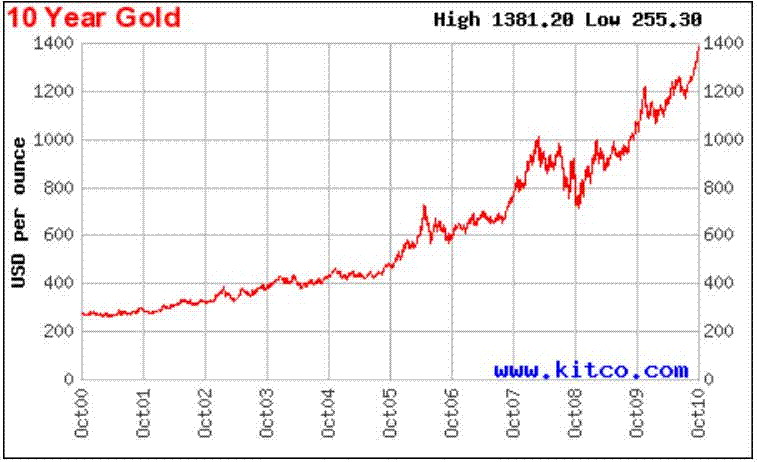
Interest in Gold as an investment has surged in the last couple years (and especially the last few months), as the currency wars have heated up and the Federal Reserve Bank contemplates an expansion of its Quantitative Easing program (dubbed” QE2″). On the one hand, the notion that the only way to defend against real currency devaluation is to own “alternative” currencies is well-founded. On the other hand, regardless of the fact that the Fed has already minted $2 Trillion in cash and that the US national debt is expanding by $1 Trillion per year, inflation in the US is low. In fact, it’s at a 50-year low, and at an annualized .9%, it’s practically non-existent. You would think that with Gold’s unending appreciation, we would be in the midst of hyperinflation, but that’s simply not the case.
In the short-term, then, there’s really not a strong fundamental basis for investing in gold. That’s not to say that it won’t continue to appreciate and that investors will continue to buy into it merely to benefit from what has become self-fulfilling appreciation. From where I’m sitting, though, there’s really no foundation for this appreciation. Consider, for example, that gold investors still have to convert their gold back into paper currency in order for it to to be “used;” otherwise, it offers no benefit to the owner except that it looks pretty (though most investors wouldn’t know, since they buy gold indirectly). Not to mention that if/when the Dollar stops depreciating, there really isn’t really a justification to buy gold as a short-term store of value.
Over the long-term, the picture is certainly more nuanced. I’m not going to explore the viability of fiat currencies here, but suffice it to say that, “Positioning for significantly higher gold prices over the long run demands a very bold strategic bet: that the global monetary system as we know it will completely break down and be replaced with a gold standard.” Regardless of the merits of this point of view, those that invest in Gold should at least understand that this is really the only justifiable reason to hold it. Those who are buying it because of the ongoing currency war will be disappointed.

The Chinese Yuan has touched a new high, at 6.69 USD/CNY. Given that the Yuan has still only risen about 2% since the peg was officially loosened in June – with most of that appreciation taking place in the last couple weeks – there still remains intense pressure on China to do more.
Last week’s intervention by the Bank of Japan diverted a tremendous amount of attention towards the Yuan. In fact, many analysts have argued that it is only because of the Yuan-Dollar peg (itself, as well as the Chinese purchases of Yen assets that it engendered) that Japan was forced to act: ” ‘Countries see that getting involved in currency manipulation is a way to give themselves an advantage’…’China, their actions affected Japan, and Japan is affecting us.’ ” The Yen intervention could also force the G20 to re-focus its attention on the Yuan, and at least devote some discussion to it at the next summit.
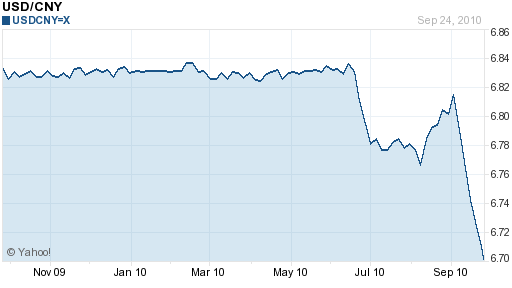
It should be noted that the two soundbites above both emanated from US Congressmen, which is important because the US government is currently mulling action on the Yuan currency peg. Politicians are growing tired by the Treasury Department’s repeated failure to call China a “Currency Manipulator,” which would require diplomatic talks and even trade sanctions. The Treasury will have an opportunity redeem itself in its next report on foreign exchange, due out on October 15, but it is expected that the report will either be delayed or released without adequately addressing the undervalued Yuan.
In fact, Treasury Secretary Geithner testified before Congress last week, and at least admitted that something needed to be done: “The pace of appreciation has been too slow and the extent of appreciation too limited. We have to figure out ways to change behavior.” However, this was only in response to acerbic criticism – (Senator Schumer told him, “I’m increasingly coming to the view that the only person in this room who believes China is not manipulating its currency is you.”) – and he ultimately failed to outline a timetable/blueprint for action. Despite the consensus among politicians (and President Obama) that the currency peg is harmful to the US economy, Geithner made it clear that the Treasury Department continues to favor unilateral action towards dealing with problem, without Congressional intervention. For now, then, politicians are probably relegated to saber-rattling and name-calling.
China’s response to this charade has been predictable. Trade representatives hinted that China wouldn’t bow to external pressure, and that any attempt at “punishment” would be met with countervailing actions. China also questioned the economics between arguments that the Dollar peg contributes to trade imbalance, calling such claims “groundless.” This position is actually supported by the notion that while the Yuan appreciated by 20% against the Dollar from 2005-2008, the US/China trade deficit actually widened.
In practice, China is likely to stick to its policy of gradual Yuan appreciation, or a few reasons. First of all, while Chinese policymakers know that they don’t need to wholly appease US politicians, they at least need to pretend that they are listening. It’s true that the US is dependent on Chinese products and its purchases of Treasury Bonds. However, it is arguably just as dependent on the US to buy its exports, which promotes employment and social stability, and it is keen to avoid a trade war if possible.
Second, a long-term appreciation of the RMB is actually in China’s best interest. If it wants to spur domestic consumption and promote more value-added manufacturing, it will need a more valuable currency. Outbound M&A, especially involving natural resource companies, will also be more economical if the Yuan is worth more. Also, if China has any serious ambitions of turning the Yuan into a global reserve currency, it will need to create capital markets that are deeper and more liquid, which it is currently unmotivated to do, lest it spur demand for Yuan by foreign institutional investors.
Finally, China should let the Yuan appreciate because it is financially gainful to do so. As I mentioned above, its trade surplus with the US has widened over the last few years as prices for its exports grow along with quantity. Meanwhile, prices for imports and prices paid for commodities and other natural resources have declined in Yuan-terms. For that reason, I think China will probably continue to stick its current policy, and allow the RMB to continue to slowly inch up.

It was only last week that I mused about “Further Delays in RMB Revaluation.” Lo and behold, over the weekend, the Central Bank finally budged, by pledging to the members of the G20 that it would ” ‘proceed further with reform‘ of the exchange rate and ‘enhance’ flexibility.” Upon reading this, I suppose I should have felt stupid.
Still, I wondered whether the move was aimed as a political sop designed to appease Western countries, rather than a meaningful change in China’s forex policy. My suspicions were confirmed on Monday, when the markets opened, and the RMB jumped by a pathetic .4%. All of those who had been hoping for an expecting an instant revaluation a la the 5% jump in 2005 were sadly disappointed.
Most commentators shared my cynicism about the move. According to Goldman Sachs Group Chief Global Economist Jim O’Neill, ” ‘It’s pretty astute timing. The timing of it is clearly aimed at the G-20 meeting, which indirectly links to the whole renewed thrust in Congress with protectionist steps against China.’ ” If this was in fact China’s intention, it backfired, since it only succeeding only in bringing increased attention to the still-undervalued Yuan. Senator Sherrod Brown called the appreciation ” ‘a drop in a huge bucket….We’ve seen China take actions like this before when the spotlight is on, and then revert back to old tricks.” Thus, he and Senator Charles Schumer have announced that they will move forward with a bill to punish China, unless the RMB is allowed to significantly appreciate.
By the Central Bank of China’s own admission, this is unlikely. Instead, it will continue to “keep the renminbi exchange rate at a reasonable and balanced level of basic stability.” In other words, the RMB is still pegged squarely to the US Dollar. It is neither freely floating nor is it pegged to a basket of currencies (in which case it could conceivably appreciate faster against the Dollar, due to the weak Euro). It is technically allowed to rise and fall on a daily basis within a .5% ban, but even this is controlled tightly by the Central Bank, via the so-called Central Parity Rate. If the rate fluctuates too much, state-owned companies often intervene in the markets at the behest of the Central Bank. Legitimate market participants are heavily constrained by a rule that requires them to square all of their positions at the end of every trading session, such that making long-term bets on the RMB’s appreciation would be impossible.
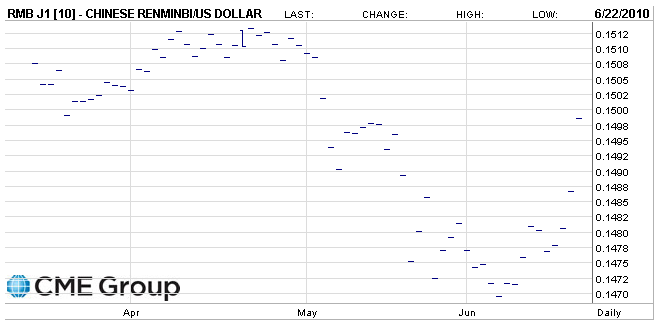
Not that it matters. In the US, where it is legal to make long-term bets on the RMB (via futures contracts), investors are still only projecting a 1.8% appreciation (2.2% relative to the RMB’s pre-revaluation level) over the next year, and a 2.9% appreciation by the end of 2011. In the end, there just isn’t a lot of confidence that China will voluntarily act in a way that is contrary to its own short-term economic interests.
To be sure, there is a possibility that the RMB will be allowed to steadily appreciate, in which case there would be real implications for other financial markets. If the past is any consideration, however, the RMB will rise only modestly against the Dollar, and even more modestly on a trade-weighted basis. Its economy will remain overheated and imbalanced, and if it was headed towards collapse prior to this latest change, it certainly still is.

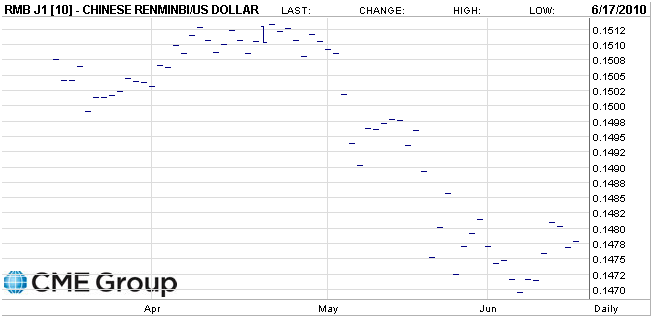

Compared to the Euro, the Pound is Gold (figuratively speaking). Compared to everything else, well, the Pound is probably closer to linoleum. Bad geology metaphors notwithstanding, there really isn’t much to get excited about when looking at the Pound.
Let’s take the election, for example. Originally billed as a chance for a fresh start, politically, for the UK, the election has turned out to be nothing short of disastrous. Rather than producing a clear-cut victory, it has resulted in a hung Parliament. The way talks are currently shaping up, it looks like power will be shared by the Liberal Democrats and Conservatives. This is problematic,because neither party has a clear vision for dealing with the skyrocketing UK national debt; with the two parties working together, meanwhile, a compromise seems even more unlikely. “Investors are worried that a hung parliament will result in a weak government that will be unable to force through measures to reduce the UK’s high borrowing levels.”
As a result, many analysts now believe that the UK could lose its coveted AAA credit rating: “We believe that a downgrade…is more than likely since both parties agree that early expenditure cuts could harm the economy. The alternative could be that both parties agree on tax hikes to be implemented with the next budget. Both outcomes would be equally bearish for sterling.’ ”
Even aside from the imminent UK fiscal crisis, there is the fact that its economy continues to stagnate, its capital markets remain languid, and its balance of trade remains perennially mired in deficit. “Figures from the Office for National Statistics (ONS) showed that gap between the UK’s imports and exports hit a massive £7.5bn in March. The deficit — well ahead of an upwardly revised £6.3bn for |February — came as total imports surged £1.4bn over the month compared with a meagre £200m rise in exports.” From a fundamental standpoint, then, there is very little reason to own the Pound.
The picture is slightly more nuanced, when viewed through the lens of technical analysis. The most recent Commitment of Traders report, meanwhile, has showed short interest in the Pound building to record levels. In addition, the ratio of long/short positions is approaching 5:1. Some analysts believe this is inherently unsustainable, and that as net positions become more lopsided, a sharp reversal becomes even more likely. Then again, some analysts had the same theory about the Euro, which was solidly disproved after the short-squeeze rally was soon followed by a steady decline and a re-accumulation of short positions.
Other technical analysts are waiting to see where the Pound moves in the near-term before placing their bets. ” ‘Last week the market eroded the 15-month uptrend from the January 2009 low at $1.3500’…the $1.4255 Fibonacci level is the last defence for the pound ahead of the $1.3500 2009 low. For the downside pressure to be taken off, key resistance at $1.5055, the May 10 high, would need to break.’ ” The Pound is hovering dangerously close to a number of psychologically important levels. If it breaches $1.40, it would signal a 5-year low. Consider also that the Pound last touched $1.38 in 2001 and $1.35 in 1987.
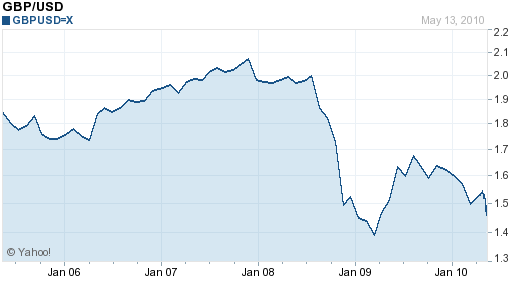
To be fair, the Pound has hovered around $1.50 for most of the last 20 years, so its current level against the Dollar is not that low, relatively speaking. If investors come to their senses, and realize that the likelihood of UK sovereign default is probably not any higher than the US, and the coalition government is able to produce a convincing plan for reducing the deficit, then the Pound could bounce back. If the safe-haven mentality remains in force, however, the Pound will continue to be one of the big losers.

In my last post, I reported that the markets were incredibly bearish on the Euro, due to concerns that the Greek debt crisis could neither be mitigated nor contained. By following up on this report with another incantation of Euro bearishness, I certainly run the risk of belaboring the point. Still, the fact that since then, a $1 Trillion bailout was announced means that at the very least, I need to offer an update!
Anyway, in case you have been living in a cave, the EU finally put its money where its mouth was by forming a €750 Billion Special Purpose Vehicle (SPV) to address the fiscal problems of currently-ailing and potentially-ailing economies. The brunt of financing the SPV will fall on individual Eurozone countries, though the European Commission and the International Monetary Fund (IMF) will also make sizable contributions. In addition, the European Central Bank (ECB) has agreed to purchase an indeterminate amount of government and corporate bonds, while other Central Banks will use currency swaps to ease pressure on the Euro.
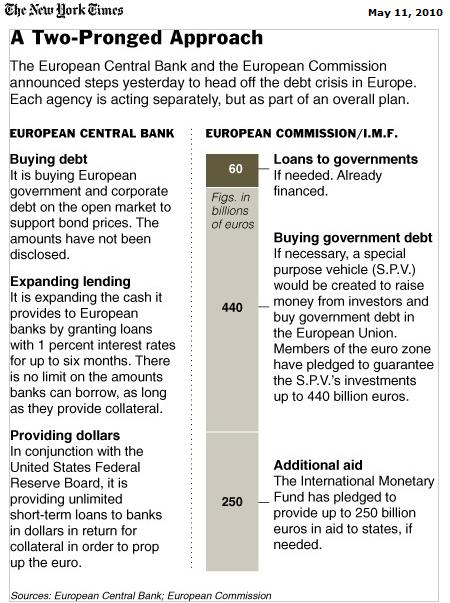
The reaction to the news was quite positive, with the Euro reversing its 6-month slump and rallying 2.7% against the Dollar. Equity shares surged on the news: “A a 50-stock mix of European stocks jumped 10.4 percent, Spain’s market soared 14.4 percent, France’s rose 9.7 percent and Germany’s gained 5.3 percent.” Sovereign debt and credit default swap prices also rose as investors moved to price in a decreased likelihood of default.
The celebration was short-lived, and by Tuesday (yesterday), the Euro had already returned to its pre-bailout level against the Dollar. In hindsight, it looks like the rally was the result of a classic short-squeeze. On Sunday, the Financial Times reported that “Positioning data from the Chicago Mercantile Exchange, often used as a proxy for hedge fund activity, showed speculato,rs increased their short positions in the euro to a record 103,400 contracts, or $16.8bn in the week ending May 4.” After the most exposed short positions were covered, however, the rally quickly came to an end: “By the time markets opened in the United States, and American hedge funds entered the market, the euro’s rally began to flag.”
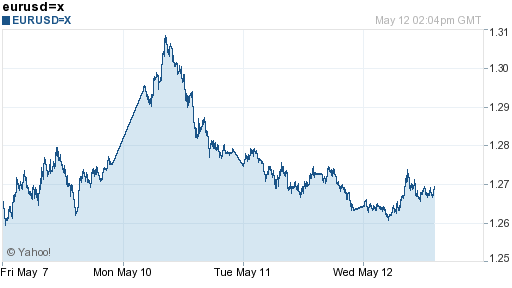
Indeed, it’s hard to find anyone that has anything positive to say about the bailout, even among the bureaucrats and politicians that contrived it. Here’s a smattering of soundbites:
There are a few specific concerns about the bailout. First of all, it’s still unclear how it will be paid for and how it will be implemented. How will specific loans be issued, and what will be the accompanying terms? Second, it does nothing to address the underlying fiscal problems that precipitated the crisis, and may in fact exacerbate them since countries have less of an incentive to rein in spending. As one analyst summarized, “Bailing out economies creates moral hazard. Other countries may continue to skirt the kinds of actions that would lower their budget deficits and debt loads…because they too can expect to be rescued.” Finally, the bailout does nothing to mitigate credit risk for private lenders; it merely transfers and expands it, since money that would have been lent to Greece (and other problem countries) anyway, will still be lent to them, after first being funneled through the SPV. In short, “Once market participants look at the actual details of this plan, they are not going to want to buy the euro either.”
As everyone has been quick to point out, the bailout probably makes a (partial) dissolution of the Euro even more likely, because it is tantamount to deflating the currency. As one economist opined, “The euro zone does not look viable in its current form. The basic premise…to unify monetary policy….while keeping fiscal policy completely separate…has completely broken down.” The only solution which will leave the Euro intact is for the weakest members to leave, and for a solid core of economically and fiscally sound economies to remain behind.
To be fair, the EU has certainly bought itself some time. Given that the amount of money pledged to fight the debt crisis well exceeds Greece’s public debt, it won’t be Greece that brings down the Euro. If/when the debt problems of Spain, Portugal, and Ireland become insoluble, however, the futility of the bailout will become abundantly clear.

Forget about Greece: What about the US, Japan, and the UK? Almost 75% of trading in the forex markets involves some combination of the US Dollar, Euro, Japanese Yen, and British Pound. This figure rises to more than 95% when you include trading in which at least one of the currencies (as opposed to both) is one of the aforementioned. In short, these four currencies are by far the most important in forex markets, and most patterns/narratives in forex markets tend to involve them.
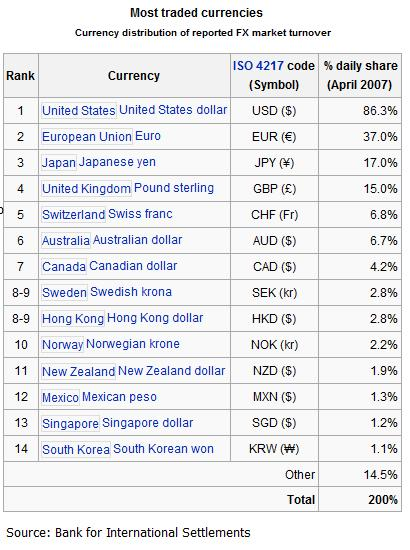
It’s simple supply and demand, really. These currencies are the most heavily traded because their economies are the largest and their capital markets are the deepest and most liquid. [The absence of the Chinese Yuan from this list can be explained by the lack of flexibility in its capital controls and exchange rate regime]. When investors flee one of these major currencies, they tend towards one of the others, and vice versa.
This phenomenon has especial relevance in the realm of sovereign debt. While some investors would love no more than to move their capital from the four debt-ridden currencies above, there just isn’t enough supply of alternative currencies to absorb the outflow. The Swiss Franc, Australian Dollar, and Canadian Dollar (#5, 6, & 7 on the list of most traded currencies), for example, have all surged over the last year as investors have looked for stable and liquid alternatives to what can be dubbed the Big-4 currencies. While these currencies still have some room for appreciation, they can’t continue to rise forever. For better or worse, then, the most useful comparison when it comes to to sovereign debt is not between the Big-4 and everything else (aka the major currencies and the emerging market currencies), but rather between the Big-4 themselves.
Forgive me for this long-winded introduction, but I think it’s important to understand the usefulness of comparing Japan with the US with the EU with the UK when all of these economies have terrible fiscal problems, and why we can’t just compare them to fiscally sound economies. With that being said, let the comparison commence!
Most of the fallout from the sovereign debt crisis has affected the EU and the Euro. This is for good reason, since the focal point of the crisis is a member of the Euro (Greece), and several other Eurozone countries are on the periphery. I addressed the EU in a previous post (EU Debt Crisis: Perception is Reality), so I think it makes sense to focus on the others here.
In terms of debt sustainability, the UK is not far behind Greece. “The flood of British debt is likely to ‘lead to inflationary conditions and a depreciating currency,’ lowering the return on bonds. ‘If that view becomes consensus, then at some point the UK may fail to attain escape velocity from its debt trap,’ ” explained one analyst. With high budget deficits projected for at least the next five years, the Bank of England no longer buying UK bonds, and the possibility that the ucoming elections could produce political stalemate, the fiscal position of the UK can only deteriorate. On the plus side, the average maturity for UK bonds is 13.7 years, twice the OECD average, which means that it could be more than a decade, before Britain really begins to feel the squeeze.
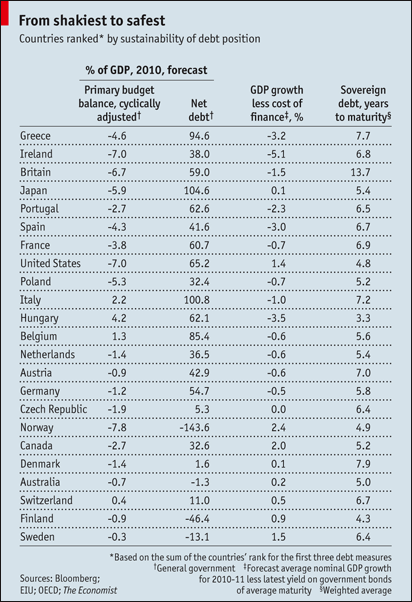
Japan might not be so lucky. Its net debt already exceeds 100% of GDP and its gross debt is approximately 200% of GDP; both are the highest in the OECD. Meanwhile, the average maturity of its debt is only five years, so there isn’t a lot of time to act. According to analysts, the crisis would most likely assume the following form: “ ‘A surge in yields would lead to a combination of extreme fiscal contraction, through tax increases and welfare cuts’…as well as to even more monetary expansion, perhaps less central bank independence and ‘presumably a much weaker exchange rate.’ ” In the case of Japan, the mitigating factor is that 90% of government debt is held domestically. Therefore, Japan isn’t vulnerable to the whims of foreign creditors, and an outright default is unlikely.
Then, there is the US. Its Trillion Dollar budget deficits, and multi-Trillion Dollar national debt and entitlement obligations are the highest in the world in nominal terms. On the other hand, the US government has not really encountered any difficulty in financing its spending. Political opposition is fierce, but investors have lined up to buy Treasury bonds and record low yields. This will likely change as the Fed curtails its purchases, and the economic recovery gives rise to higher interest rates. Analysts expect that borrowing costs (i.e. Treasury yields) could rise more than 1.5% by the end of 2010.
From the standpoint of markets, its impossible to say which economy’s fiscal problems are the most serious, since sovereign debt yields have declined across-the-board over the last 20 years. One Professor of Finance explains this trend as follows: “Behavioral factors keep many bond traders and investors from recognizing the reality of the situation…since there is no well-defined crisis point.” In other words, the crisis in Greece is only a test run. The real one could come in a few years, and involve a much larger economy. At that point, currency traders will have to decide who to back.
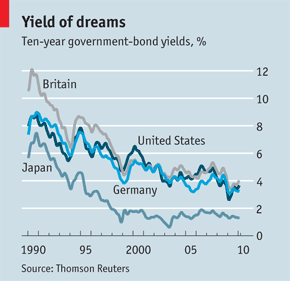

One of the pitfalls of forex blogging (or all financial reporting for that matter) is that it’s inherently after-the fact. In other words, any information about the past – while relevant – is inherently useless, since it has theoretically already been priced into the asset (or currency in this case). Before I begin my post on the Pound’s recent decline and the factors that wrought it, then, I wanted to offer the caveat that in analyzing past events, we must simultaneously look to the future.
Anyway, for anyone watching the Pound Sterling over the last month, its performance has been startling. It is down 7.5% for the year already (we’re only in March!), and has fallen 12% from its August peak of 1.70 USD/GBP. This represents an unbelievable about-face, as the Pound spent much of 2009 floating upwards following its lows from the credit crisis.
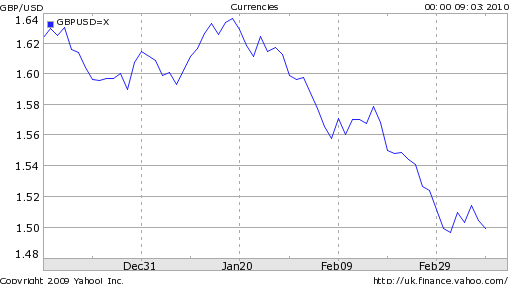
What’s behind the decline? In short, economics and politics, or more precisely, the junction of economics and politics. As the British economy began its recovery from recession, analysts began to turn their attention to UK government finances. Another way of looking at this would be to say that analysts have shifted their gaze from the positive effect of government intervention (i.e. economic recovery) to the many lasting negative effects. Inflation and government solvency, of course, are the two most pernicious of the bunch.
The Bank of England’s quantitative easing program was comparable to the Fed’s program in relative terms, and in the aftermath of all of that money creation, inflation is slowly creeping up. The government’s free spending also contributed, and now, so is the sinking Pound, as prices for commodities and other imports are rising fast in local currency terms. Speaking of government spending, the UK government budget deficit is projected at 12% for 2010, slightly higher than 2009. You can see from the chart below that budget deficits are forecast to remain large for the next few years. Expectations are so low, in fact, that a reduction in the deficit to 3% of GDP by 2014-2015 would be viewed as a victory.
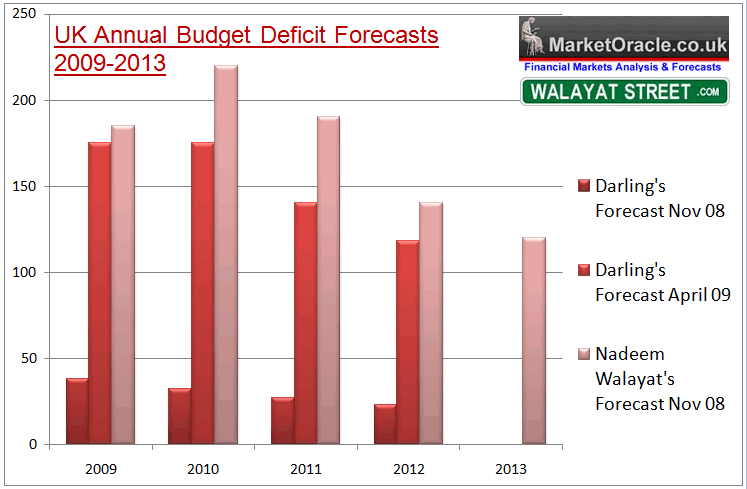
Naturally, the UK government feels some pressure to reduce its deficit, both for the sake of financial solvency and to control inflation. The problem is that an election must be called before June, and until then, there is natural pressure to continue operating the money printing presses 24/7 in order to appease the voting public. The same goes for the Bank of England; it can’t be expected to tighten monetary policy and/or reverse quantitative easing until after the election.
I’m not going to pretend that I understand British politics, but from what I’m hearing, it seems the problem is that the election polls are now very close. Previously, a major victory by the Conservative Party was seen as inevitable, and this was viewed positively by financial markets because of the expectation that they would rein in spending. Recently, the incumbent Labour Party has closed the gap, to the extent that a hung Parliament is now a likely outcome. This would be even less desirable than an outright Labour victory, because the sharing of power would make it unlikely that reforms of any kind would be enacted. With regard to forex, some have posited an inverse correlation between the rising popularity of Labour and the falling Pound.
With the crisis in Greece still unresolved, analysts are also making comparisons to the UK. Some have suggested that if Greece were to receive a bailout, then, investors would turn their attention to the UK, whose finances are in equally bad shape. Without the protection of the Euro, the Pound would be open to speculative attack. On the other hand, that the (declining) Pound is independent from the Euro could become in advantage, if it boosts exports.
Going forward, it’s difficult to make any predictions until after the elections and/or the government makes a firm commitment to reduce spending and lower its deficit. Some analysts think that regardless, the Pound is doomed to continue falling, perhaps all the way to the $1.40 mark. Others see the current decline as the “darkness before the dawn.” As I noted in the introduction to this post, the latter could certainly be right. Besides, most of the uncertainty has probably already priced in. While most of the factors currently weighing on the Pound are bearish, some contrarian investors might see this as a good opportunity to buy. And who’s to say they’re wrong?

With this post, I want to try to clarify the Greek fiscal crisis. The problem is that it’s not clear exactly how serious the problem is, because most of the media coverage of the crisis has been directed towards the financial markets’ perception of it, rather than its underlying fundamentals. In the end, I think it’s important to understand both.
The Financial Times published a great timeline that shows perception and reality side-by-side. While there were certainly other important developments that bear in Greece’s fiscal position (in addition to those listed below), you can see that financial markets are basically making their own reality. For example, there was hardly a response to the October announcement that Greece’s budget deficit would be 12.7%, which was 5% higher than earlier estimates. In fact, the markets only became bearish on Greek debt after it the government announced that it would try to bring the debt down to 9.4% through various measures.
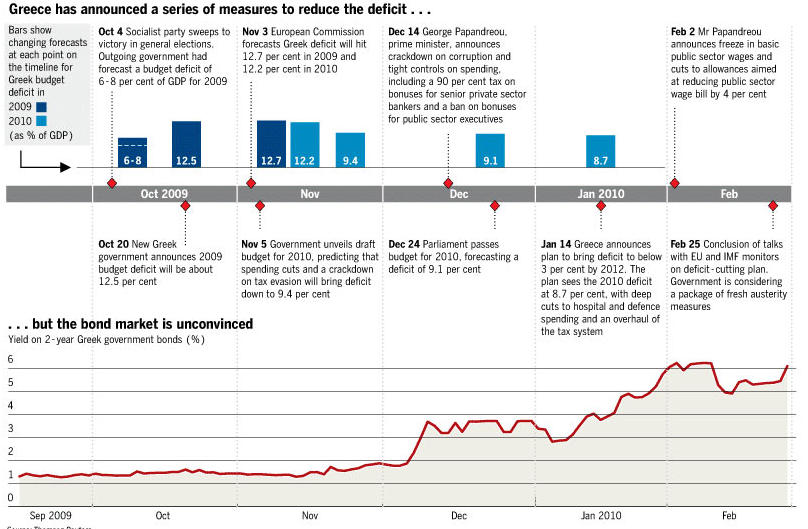
Apologists for the markets would be right to wonder why investors should be inclined to believe the government of Greece when it said it could control the budget deficit. Fair enough. Still, one has to wonder why the markets suddenly started worrying about Greece’s fiscal problems, when only a couple months ago, the possibility of a whopping 12.7% budget deficit barely caused investors to blink. Besides, the credit crisis has been raging since 2008, which means the markets have had plenty of time to digest the implications of recession for Greece’s fiscal position.
These days, where is a financial crisis, chances are derivatives are not far removed. As credit default swap spreads (i.e. the cost of insuring against default by Greece on its loan obligations) have risen, so have concerns that this is a bona fide crisis. “It’s like the tail wagging the dog…There is a knock-on effect, as underlying positions begin to seem riskier, triggering risk models and forcing portfolio managers to sell Greek bonds,” said one portfolio manager. From this perspective, it almost looks like this “crisis” is being completely manufactured by speculators for the sake of profit. Summarized another analyst, “It’s like buying fire insurance on your neighbor’s house — you create an incentive to burn down the house.”
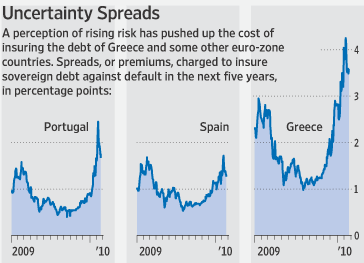
To be fair, Greece also played a role in derivatives speculation, and on some level, it was even more nefarious than the speculators. Assisted by Goldman Sachs (who is now betting on Greek default [how un-ironic that is!]), Greece entered into a series of swap agreements last decade, which it used to conceal its true debt burden. “By using an historical exchange rate that didn’t accurately denote the market value of the euro, Goldman effectively advanced Greece a €2.8 billion loan. Under EU accounting rules—which were tightened in 2008—Greece wasn’t obliged to include the loan in overall public debt on its books.” Now that those transactions have been uncovered and the truth is coming to light, financial markets are rightly re-evaluating the risk of further lending to Greece.
There is no question that Greece’s debt problems are serious. As to whether labeling it a crisis is necessary, that depends on your standards. Greece ranks near the top of the list on a variety of individual “debt sustainability” criteria. At 94.6% of GDP, it’s net debt is among the highest in the world. Its projected 2010 budget deficit is also high, though not the highest. Its cost of borrowing is also significantly higher than projected GDP growth, which means that net debt will continue to grow until a budget surplus can be produced. When you average these measures together, it appears that Greece’s debt problems are the most unsustainable of any country in the world. But this is hardly news.
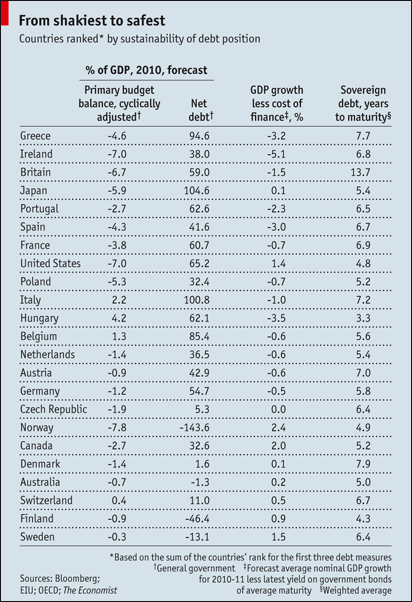
On the other hand, the weighted average of the maturity of Greek debt is 7.7 years, well above average, and plenty of time (relatively) for Greek to sort through this mess and secure new lenders. Towards the latter end, it has hired a former bond trader to head its debt management agency. In order to improve its fiscal position, it has announced a series of austerity measures, including budget cuts, tax increases, wage cuts for public-sector employees, and stricter laws against tax evasion.
At this point, a ratings downgrade looks inevitable, and some analysts think the crisis has already become self-fulfilling. As borrowing costs rise, it only makes it more likely that Greek will default, which causes rates to rise further, and so on. On the other hand, Greek politicians are being forthright about their position (“Greece’s finance minister, George Papaconstantinou, remarked this week: ‘People think we are in a terrible mess. And we are.’ “) and have a plan for rectifying the situation. There is cause for skepticism here, but also for hope. And that goes not just for Greece, but also for the Euro.

Currency markets operate in funny ways. Greece’s fiscal problems are hardly a new development. During years of boom and bust alike, it ran unsustainable budget deficits. Why investors have decided to fret now – as opposed to last year or next year, for example – on the distant possibility of default, is somewhat mysterious.
After all, the credit crisis exploded in 2008, and conditions now are inarguably more stable than they were at this time last year, when volatility and credit default spreads (insurance against bond default) – two of the best measures of investor risk sensitivity – were still hovering around record highs. On the other hand, the unveiling of Dubai’s hidden debt problems, has certainly provided impetus to investors to re-evaluate the fiscal situations in other highly leveraged economies. In addition, Greece just estimated that its budget deficit for 2010 at 12.7%, 4% higher than earlier estimates, which were also shockingly high. Regardless of 1, the markets are now focused firmly on Greece – and by extension, the Euro.
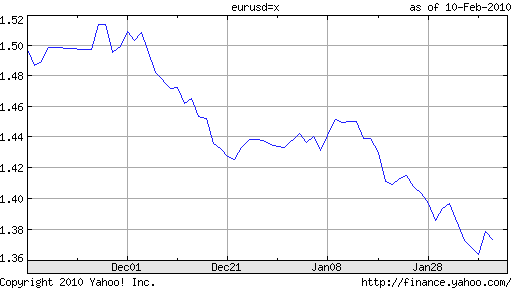
How serious are Greece’s fiscal problems? Serious, but not insurmountable. Its sovereign debt recently surpassed 125% of GDP, higher than the US, but lower than Japan, for the sake of comparison. Of course, the Greek economy is hardly a picture of robustness. Neither is the US, these days, for that matter, but its size means that it is pretty much immune from speculative attacks on its credit and capital markets. Greece, on the other hand, remains extremely vulnerable to the whims of international investors.
On the whole, these investors still remain willing to finance Greece’s budget deficits; the last bond issue was five times oversubscribed, which means that demand exceeded supply by a healthy margin. Still, interest rates are rising quickly, and spreads on credit default spreads have risen above 400 basis points, suggesting that nervousness is growing and Greece cannot take for granted that future bond issues will be met with such healthy demand.
In this context, in stepped the European Union. In fact, it isn’t even clear if Greece asked for help. As I pointed out above, the Greek debt “crisis” is largely playing out in capital markets, and doesn’t necessarily reflect a change in the fiscal reality of Greece. Still, leaders of the EU were alarmed enough to convene a meeting between the finance ministers of member states, to discuss their options.
After weeks of denial that any kind of aid to Greece was being considered, EU political leaders announced that they were prepared to step in to help after all, but they were vague on the details. There were no ledges of specifc dollar amounts, only hazy promises of support should conditions warrant it. In the end, what was clearly intended to comfort the markets achieved the opposite effect, as investors took no comfort in the “moral support” and worried about the new uncertainty.
It’s premature to say whether this whole episode will threaten the viability of the Euro. Much depends on whether Greece (Portugal and Spain, too, for that matter) can get its fiscal house in order (Among other things, it has promised to reduce its 2010 budget deficit by 4%). More importantly, it depends how, and to what extent, the EU responds to this crisis as a community. The Euro is already 10 years old, and you would think that it would have been accepted already within the EU, as it has by the rest of the world. On the contrary, it remains deeply divisive and fraught with politics. Many of its critics have seized on this opportunity to challenge to raise fresh calls for its abolishment. If the problems of Greece deteriorate to the point that other EU members are actually required to intervene, you can expect these calls to crescendo.

Last month, I reported on how anticipation is (was) building towards a revaluation of the Chinese Yuan (RMB), confidently stating that “The only questions are when, how and to what extent.” While I’m not ready to recant that prediction just yet, I may have to temper it somewhat.
On the one hand, the case for RMB revaluation is stronger than ever. Among large economies, China’s economy is by far the strongest in the world, clocking in GDP of close to 2009% while most other economies were lucky to “break even.” Meanwhile, its export sector – supporting which is the primary purpose of the RMB peg – is once again robust, having recovered almost completely from a drop-off in demand in 2008 and the first half of 2009. In fact, exports grew by 30% in January, on a year-over-year basis. China’s share of global exports is now an impressive 9%, up from only 7% in 2006. From an economic standpoint, then, the case for an artificially cheap currency is no longer easy to make.
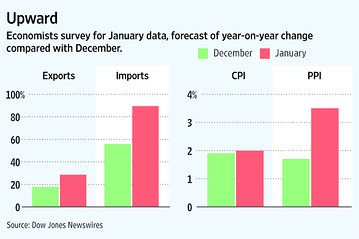
At the same time, the RMB peg is contributing to bubbles in property and other asset markets. That’s because the Central Bank of China has been forced to mirror the monetary policy of the Fed, as a significant interest rate differential would stimulate uncontrollable capital inflows from yield-hungry investors. While the US can still handle interest rates of close to 0%, China’s economy clearly can not. Thus, consumer prices are slowly creeping up, and property prices are soaring. The most effective (and perhaps the only) way for China to contain both consumer price and asset price inflation is to hike interest rates, which which in turn, would necessitate a rise in the RMB.
There is also the notion that the peg is becoming increasingly costly to maintain. China’s forex reserves already total $2.4 Trillion, and each Dollar that it adds will be worth less if/when it ultimately allows the RMB to appreciate further. In addition, China’s economic policymakers continue to fret about its exposure to the fiscal problems of the US, with one pointing out that, “China has effectively been kidnapped by U.S. debt.” Of course, they no doubt realize that there isn’t a better option at this point; its attempt to diversify its reserves into other assets proved disastrous. The solution to both of these problems, of course, would simply be to allow the Yuan to fluctuate based on market forces, or at least for it to resume its upward path of appreciation.
Political pressure on China to revalue, meanwhile, is even stronger than it was last month. While not invoking China by name, President Obama has been increasingly blunt about the need to pressure it on the RMB: “One of the challenges that we’ve got to address internationally is currency rates and how they match up to make sure that our goods are not artificially inflated in price and their goods are artificially deflated in price.” In addition, rumor has it that the Treasury Department could finally label China as a “currency manipulator” in its next report, which would allow Congress to impose punitive trade sanctions.
Developing countries, which now account for a majority of China’s exports, are also increasingly unhappy with the status quo. The peg to the Dollar caused many emerging market currencies to appreciate rapidly against the Yuan in 2009, and there is evidence that many of their trade imbalances with China are rapidly worsening, “with exports to India, Brazil, Indonesia and Mexico growing by 30% to 50% in recent months.” As one analyst pointed out, however, the potential backlash from this development could be massive: “It’s one thing to produce job losses in the U.S., but it’s another to produce job losses in Pakistan,’ with which China has close military ties.”
On the other hand, however, is China’s massive reluctance to allow the Yuan to appreciate. Part of this is related to face; with the US and other countries stepping up pressure on a number of fronts, China’s leaders don’t want to be seen as weak, and could act contrary to their own interests if it thinks it can earn political points in the process. “China is unlikely to make significant concessions to U.S. pressure on the yuan, particularly now when the two countries are involved in a range of disputes, including U.S. arms sales to Taiwan,” explained one analyst. More importantly, the leadership is nervous that the nascent economic recovery is not sufficiently grounded for the peg to be loosened. While 9% growth in most other economies would be cause for celebration, in China, it is being interpreted as evidence of fragility.
There you have it. Reason on one side, and politics on the other. Unfortunately, it seems that politics always triumphs in the end. Despite Treasury Secretary Geithner’s recent assertions that the RMB will rise soon, investors know that China ultimately calls the shots: “When it comes to the exchange rate, China’s main consideration is China’s own stable economic growth and the structural adjustment of its economy. Foreign pressure is only a secondary consideration.” In short, the RMB is now projected to appreciate only 2% in 2010, according to currency futures, compared to 3.5% last month.
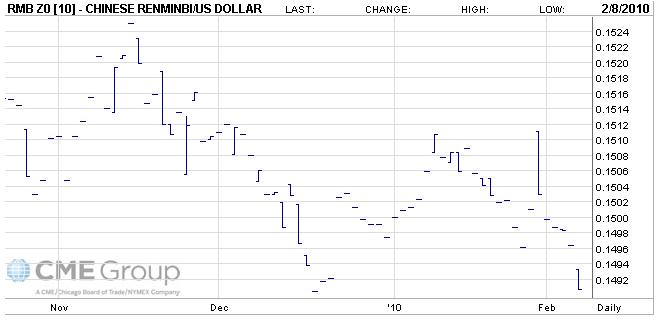

As if forex traders didn’t have enough to worry about these days, now there is a new concern- that of sovereign debt default. The last couple months have witnessed a spate of minor episodes, all of which paint a picture of frightening cohesiveness about the state of sovereign finances, and the ability of countries to continue to finance and service their debt. As the economic recession moves into recovery (or at least, permanently distances itself from the prospect of depression), the markets will likely turn their gaze towards the long-term, with this issue looming large.
It’s difficult to know where to begin, since people have been talking about the perennial budget deficits of the US for many years. As a result of the economic downturn (stimulus programs and falling tax revenues), these budget deficits have taken on truly awesome proportions. The 2009 deficit came in at a record $1.4 Trillion, and the deficit in the fiscal year-to-date 2010 is close to $300 Billion.
The US, of course is far from alone, with virtually every nation (industrialized and developing, alike) operating in the red. Canada, Britain, Japan…even China – known for its fiscal prudence – are setting records with their budget shortfalls.
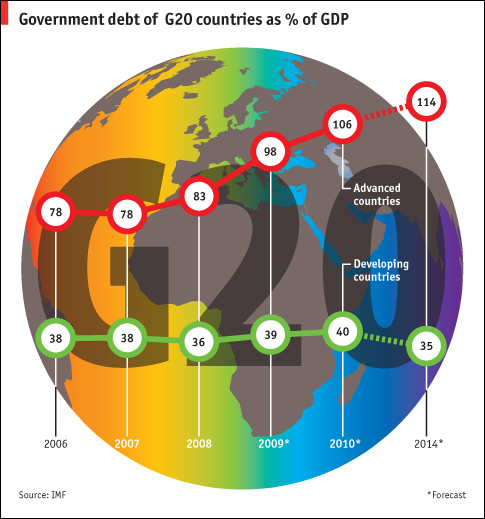
As a result, “Moody’s…suggested that the countries’ triple-A ratings could face downgrades in coming years.” Greece’s sovereign debt was already downgraded, from AAA- to BBB+, while Spain has received a warning. Dubai is in technical default, but this is old news.
It’s not as if any of this is surprising, or even new. Greece, for example, was running 10% budget deficits during the height of the credit bubble. With the bursting of the bubble, however, sovereign fiscal problems have both been both exposed and exacerbated. If ever there was a time when national governments could be expected to get their fiscal houses in order, this is not it.
At this point, the markets appear to have resigned themselves to sky-high deficits for the immediate future, and have now begun to assess the implications rather than try to encourage governments to straighten out. Even though the US budget deficits and national debt are the highest in nominal terms, its Treasury bonds still remain the standard-bearer for global capital markets. Proving that point is that new Treasury issues are repeatedly oversubscribed, despite rock-bottom rates. “For every $1 of debt sold by the Treasury this year, investors put in bids for $2.59, up from $2.19 at this point in 2008.” Most importantly, the largest creditor – China – is headlining demand. Granted, the costs of insuring US debt (via credit default swaps) is rising, but investors generally remain cautiously optimistic about US finances.
The story on the other side of the Atlantic is not nearly as upbeat. Investors responded to the downgrade of Greece’s credit rating, by pushing up the yield on its debt by 50 basis points, raising the spread to 2.5% over comparable German sovereign bonds. Ireland, meanwhile, is projecting a budget deficit of 13.2% this year, and Austria is receiving scrutiny for its banks’ risky lending practices in Eastern Europe. “The question for Europe now is how much more solvent are countries like Italy, Portugal and Spain…Could it be that these are the regions where the next financial shoe is going to drop?” Asked one analyst.
The more important question is what would happen in the event of default, or even a spike in bond yields by a member of the EU. Technically, the treaty behind the European Monetary Union “contains a ‘no bail-out’ clause that prohibits one country from assuming the debts of another.” It seems hard to believe – from where I’m sitting at least – that other countries would sit by idly if one member began moving inexorably towards bankruptcy. Investors are certainly not blind to the notion of an implicit guarantee, which helps the weak at the expense of the whole. That could explain why Greek and Spanish bonds remain comparatively buoyant, while the Euro has suffered in recent sessions.
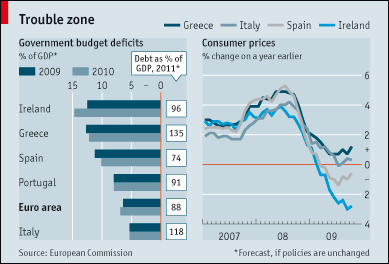 Then, there is the UK. Of all of the world’s major economies, the UK is arguably in the most precarious financial position, especially relative to its size. As one commentator lamented, “Indeed, the cost of our [UK] government borrowing – as measured by the interest rate – is rising so quickly that within a month it could be higher than Italy’s.” He goes on to discuss how inflating away the debt would be pointless, given the sophistication of investors and the fact that government liabilities are indexed to inflation, and hence would offset any gains from debt devaluation. He concludes: “The solution to today’s fiscal crisis is the same as it has always been: to cut spending, reduce the deficit and learn to live within our means.” Based on modern history, that seems pretty unlikely. Could Britain, then, become the first industrialized country to default on its debt? Forex markets: take note.
Then, there is the UK. Of all of the world’s major economies, the UK is arguably in the most precarious financial position, especially relative to its size. As one commentator lamented, “Indeed, the cost of our [UK] government borrowing – as measured by the interest rate – is rising so quickly that within a month it could be higher than Italy’s.” He goes on to discuss how inflating away the debt would be pointless, given the sophistication of investors and the fact that government liabilities are indexed to inflation, and hence would offset any gains from debt devaluation. He concludes: “The solution to today’s fiscal crisis is the same as it has always been: to cut spending, reduce the deficit and learn to live within our means.” Based on modern history, that seems pretty unlikely. Could Britain, then, become the first industrialized country to default on its debt? Forex markets: take note.

In my report on last month’s Japanese election, I noted that the newly-appointed Japanese finance minister, Hirohisa Fujii, had spoken out against forex intervention. With that, it seemed the matter was closed.
But not so fast! Over the following few weeks, Fujii (as well other members of the new administration) moved to clarify his position, backtracking, sidestepping, contradicting, but never going forward. The following is a summary of selected remarks, beginning with the original statement against intervention and ending in what seems like a promise to intervene:
September 15: “I basically believe that, in principle, it’s not right for the government to intervene in the free-market economy using its money, either in stock or foreign-exchange markets.”
September 27: [The Yen’s rise is] “not abnormal…in terms of trends.”
September 28: “That’s not to say I approve of the yen’s rise.”
September 28: “I don’t think it is proper for the government to intervene in the markets arbitrarily.”
September 29: “If the currency market moves abnormally, we may take necessary steps in the national interest.”
October 3: “As I have said in Tokyo, we will take appropriate steps if one-sided movements become excessive.”
October 5: “If currencies show some excessive moves in a biased direction, we will take action.”
Confused? I know I am. Is it possible to glean any semblance of meaning from these remarks? Summarized one columnist, “Hirohisa Fujii has gone through several cycles of remarks that first appeared to favor a strong yen and then seemed to backpedal after markets took him at his word and sent the Japanese currency soaring.”
I think this encapsulates the regret that Minister Fujii must have felt, after his original comments were taken a little too seriously. In hindsight, it appears that Fujii attempted to convey the new administration’s stance on forex, in a nutshell, and certainly didn’t expect that investors would run wild and send the Yen up another 4%, bringing the year-to-date appreciation against the Dollar to 15%. In the words of the same columnist cited above, “Japan’s finance minister has been rudely reminded of the cardinal rule when speaking to markets — less is more.”
So where does Fujii actually stand? I would personally hazard to guess that his original explication is still the most accurate portrayal of how he will tend to the Yen while in office. The former Liberal Democratic Party (LDP) administration intervened several times while in office (once under the direction of Fujii himself!) and most recently in 1994. Despite spending trillions of Yen, the campaign only marginally stemmed the rise of the Yen.
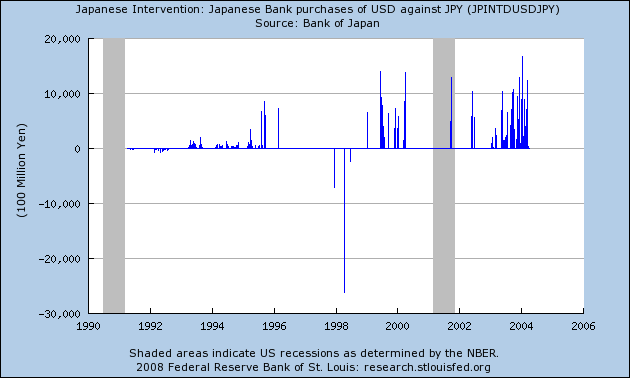
Meanwhile, the Japanese economy has been mired in what could be termed the “world’s longest recession, dating back to the 1980’s. It’s clear that the cheap-Yen policy, designed to promote exports, hasn’t benefited the Japanese economy. The new administration, hence, has indicated a shift in strategy, away from export dependence and towards domestic consumption.
Ironically, the nascent Japanese economic turnaround is once again being driven by exports. Fujii is no doubt cognizant of this, and doesn’t want to jeopardize the recovery for the sake of ideology. For example, Toyota Corporation has indicated that a 1% appreciation in the Yen against the Dollar costs the company $400 million in operating income. In addition, while a strong Yen increases the purchasing power of Japanese consumers, an overly strong Yen can lead to deflation, as consumers forestall spending in anticipation of lower prices down the road.
In other words, Fujii is certainly not a proponent of Japan’s recent runup, but his stance is more nuanced than initially understood. “Fujii is basically saying currencies should reflect economic fundamentals and that it is wrong to manipulate their moves to lower the yen for the sake of exporters,” offered one strategist. This, the markets finally seem to understand, and the Yen has actually reversed course over the last week. After all, “A yen in the 80s is excessive,” given the context of record low interest rates and a economy that is still contracting.
In the near-term, then, it doesn’t even make sense to talk about intervention. It seems the markets were getting ahead of themselves in this regard. It doesn’t make sense to price out the possibility of intervention when interevention shouldn’t be a factor in the first place. If on the other hand, the Yen continues to appreciate, then Fujii may have consider how fixed his principles really are.
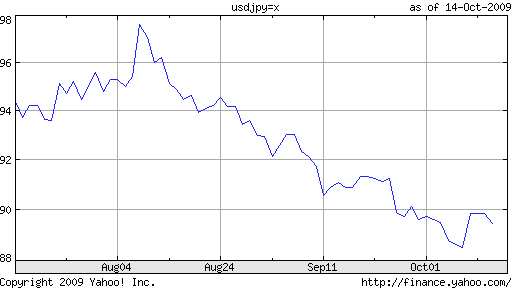

The semiannual meetings of the “G” countries – whether the G7, G8, G20, etc. – are always closely monitored by currency analysts. Especially close attention is paid to the official communique, which often includes an assessment of current exchange rates.
The communique is rarely so straightforward as to indicate if, when, and where the Gs will intervene. Nonetheless, it is often full of intimations, and analysts often spend days parsing its rhetoric for clues. During this period, it’s not uncommon for the forex markets to witness increased volatility, as investors try to come to consensus about what to expect in the months following the meeting. This is because unlike Central Banks, which often face difficulties in unilaterally trying to influence their currencies, the G7 is usually able to achieve its desired goal: “A study last year by ECB economist Marcel Fratzcher found the G7 was successful in moving within a year currencies on 80 per cent of the 29 occasions it tried to do so since 1975.”
However, the current meeting, which is being held in Instanbul, Turkey,may break from this tradition. It’s not clear exactly what motivated the (potential) decision not to release a communique, which has been an important policy tool for the last three decades. Perhaps, policymakers have realized that their are other, better forums to discuss currency issues, namely the G20, which met last week in Pittsburgh, USA.
The timing of the decision is somewhat odd, given that exchange rate and other economic imbalances are proliferating. In fact, in press conferences held before and after the official G7 meetings, policymakers and Central Bankers have been forthcoming about such imbalances. Jim Flaherty, Finance Minister of Canada, sounded off on the RMB, which has stalled in its appreciation for over a year: “They (China) have a position that they are relaxing their currency, relaxing the restrictions on their currency gradually over time,” he said. Meanwhile, ECB Governor Jean-Claude Trichet voiced concerns about the Dollar, which has slide 15% against the Euro so far this year.
Ironically given the G7’s refusal to act, there is actually a strong conensus that the Dollar’s slide is generally bad for the global economy, especially in the context of the nascent recovery. A cheaper Dollar not only affects the export competitiveness of countries in Asia, but is also partially responsible for surging commodity prices. There is also a general belief that volatile (perhaps unstable is a better word) exchange rates are not conducive to economic and financial stability.
At this point, it doesn’t seem likely that either the G7 or the G20 will take the extreme step of intervening on behalf of the Dollar, which remains well below the record lows of 2008. If the Buck continues to slide, however, especially to the point where its role as global reserve currency is in jeopardy…well…that is a different story, and fodder for next year’s meetings, which will be held in Canada. Then again, it may be taken up by the G4, a still-hypothetical group which would consist of the US, China, Japan, and a representative from the EU. It is alos the intended subject of my next post…stay tuned!

In what could be be called an “earth-shattering” election, Japan’s incumbent Liberal Democratic Party (LDP) was finally unseated, after a 50-year stretch in power (excluding an 11-month “hiatus” in 1993). Given both the historic nature of the defeat and the margin of victory, it’s surprising that the election took place with so little fanfare. This is perhaps because the defeat was grounded more in opposition to the LDP than in support for the victorious Democratic Party of Japan (DPJ), of which little is surprisingly known. For that reason, it’s extremely difficult to assess/predict the implications of the election, and I should preface this post by noting how speculative its conclusions are. Still, a few meaningful observations can be made.
First, the DPJ appears to be somewhat liberal when it comes to economic policy. “Yukio Hatoyama, who is poised to be named prime minister, has railed against ‘unrestrained market fundamentalism and financial capitalism.’ ” It’s not clear exactly what was meant by this pronouncement, although it’s certainly connected with the LDP’s pledge to increase spending on social programs: “It says it will improve health care, expand payments for the unemployed and provide a minimum monthly pension…and remove the tuition fees for public high schools of around ¥120,000 a year.”
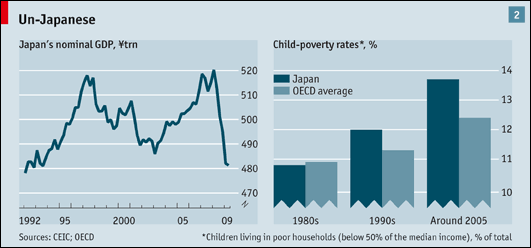
It also aims to spearhead a change in the structure in Japan’s economy, away from big government projects and export-dependent industries, in favor of consumers and small businesses. Through a combination of tax cuts, transfer payments, and certain spending initiatives, it is intended that consumers will feel a greater sense of financial security, and open up their wallets. “If they succeed, firms that cater to domestic consumers, from clothing retailers to restaurants, are expected to prosper.” Given that the unemployment rate just touched a record low and that deflation has now set in, it certainly has its work cut out for it in this regard.
Second, a crisis is looming in Japan’s public debt, and it’s not clear if/how the DPJ can solve it. The spending measures approved by the LDP while its leaders were still in power are projected to bring Japan’s national debt to 200% of GDP, by far the highest in the industrialized world. Some analysts have ascribed a fiscal hawkishness to the DPJ, and believe that despite its campaign promises, it will actually move to rein in spending.
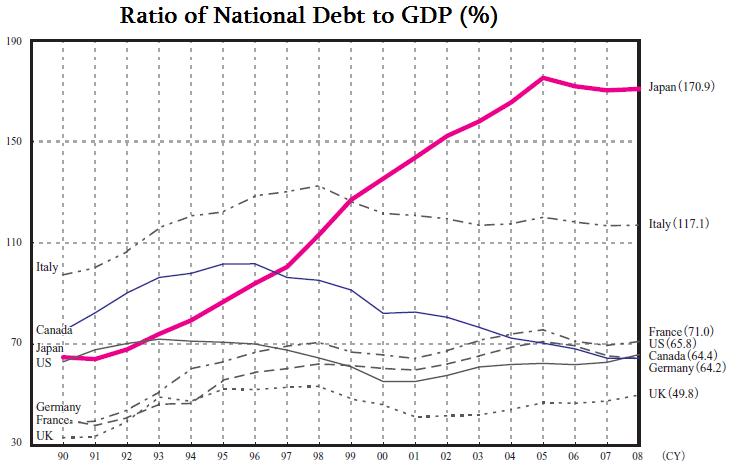
Other analysts are skeptical, and have argued that unless (consumption) taxes are raised, Japan will soon face a crisis of epic proportions. “We have a government coming in that’s committed to spend even more than the previous government at a time when increased borrowing to spend is just not a plausible option…A catastrophic breakdown of Japan’s public-sector finances will be the biggest story ever to hit the world economy in our times, eclipsing the current financial crisis,” said one economist. Given that the the DPJ has promised not to touch the consumption tax rate for at least four years, such a crisis could come sooner rather than later.
Third, DPJ leadership has pledged not to intervene on behalf of the Japanese Yen, as part of its program to re-structure the economy away from exports. This marks a huge shift from the previous LDP administration, whose policies and rhetoric were consistently geared towards helping exporters and holding down the Yen. “I basically believe that, in principle, it’s not right for the government to intervene in the free-market economy using its money, either in stock or foreign-exchange markets,” declared Hirohisa Fujii, Japan’s soon-to-be-appointed finance minster, who has voiced support for a strong Yen policy on the grounds that it will boost Japanese purchasing power. This contradicts his exchange rate policy during his first stint as finance minister, during which he managed repeated interventions on behalf of the Yen. Still, it should be noted that during his tenure, the Japanese Yen rose against the Dollar.
What do the markets think? The Japanese Yen rose on the news of the DPJ victory, which suggests that investors are inclined to give the new administration the benefit of the doubt when it comes to its pledge not to intervene in forex markets. At the same time, Japanese equities sank, consistent with expectations that the DPJ will be less supportive of big business then its predecessors. In the end, nothing is written in stone, and if the Japanese economy fails to revive, don’t be surprised if the DPJ does an about-face and decides that maybe a weak Yen isn’t so bad after all.
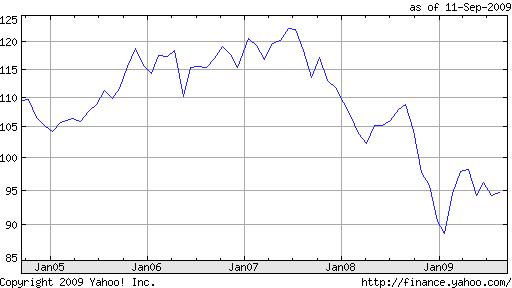

Just when it looked like the carry trade was back for good and all signs pointed to a Yen depreciation, out of nowhere came a series of surprise developments, propping the Yen back up. Spanning finance, economics, and politics – a Forex Trifecta – these developments moved swiftly through the markets, creating optimism for the Yen where before there was only pessimism. Of course, it’s possible that this bump will prove temporary, and a reversal could transpire just as quickly.
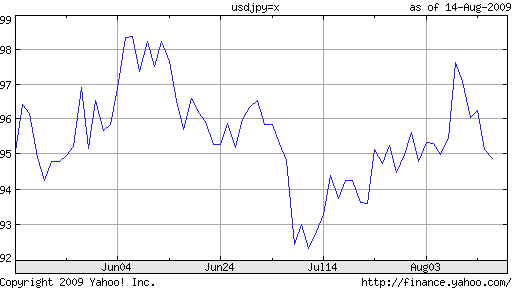
The biggest news, by a large margin, was a report that the Japanese economy had returned to growth. Similar in scale and in tenor to stories coming out of other countries, the data showed that Japan grew at an annualized rate of 3.6% in the second quarter of 2009, a sharp reversal from the 11.7% contraction in the previous quarter (which was itself revised upward from -14%).
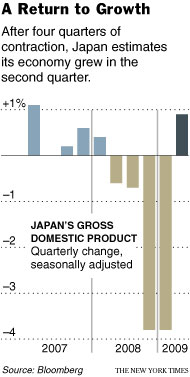
The sudden sea change was brought about by a combination of government spending and export growth. “New tax breaks and incentives to help sales of energy-efficient cars and household appliances, coupled with lower gas prices and a rebound in share prices, spurred consumer spending. Prime Minister Taro Aso has pledged 25 trillion yen (about $263 billion) in stimulus money, including a cash handout plan and more public spending on programs like quake-proofing the country’s public schools, to revive the economy.” Meanwhile exports grew by a healthy 6.3% from the previous quarter, while imports fell, causing the trade surplus to widen.
The announcement of economic recovery was accompanied by a noteworthy reversal in capital flows, such that Japan’s capital account swung into surprise weekly surplus: “Foreign investors bought 292.9 billion yen ($3.1 billion) more Japanese stocks than they sold during the week ended Aug. 8 and domestic investors were net buyers of 125 billion yen in overseas bonds and notes.” Meanwhile, speculation is mounting that Japanese investors will move to repatriate some of the coupon and redemption payments they receive on their US Treasury investments.
While seemingly unrelated to the economic turnaround (it’s important not to read too much into weekly data), this could be a sign that Japanese investors are growing more optimistic about domestic economic prospects and are moving to invest more at home. It’s worth noting that such a shift could actually be necessary if the recovery is to be sustained, in order to increase the role of (capital) investment, relative to exports and government spending. Ironically, it could instead be a sign of excessive pessimism, if Japanese believe that prospects for US/global growth have been overestimated, in which case risk appetite and the carry trade would be due for a combined correction.
Domestic consumption could also play an increasing role in Japan’s economy going forward, as a result of imminent political changes. “To stimulate consumption at home, the Democrats have pledged to put more money in the hands of consumers by providing child allowances, eliminating highway tolls and making fuel cheaper. That marks a shift away from the long-ruling LDP’s emphasis on steps to help companies.”
Along similar lines, the Democratic Party (which has a wide lead over the incumbent Liberal Democratic Party), has also conveyed its opposition to currency intervention, since such tactics inherently prioritize export growth over domestic consumption. “Japan’s export-led growth is reaching its limits and Tokyo should not intervene in markets to weaken the yen as long as currency moves match fundamentals, the No.2 executive in the main opposition party said on Monday.” Could the carry trade be in trouble?

Most of the recent discussion surrounding foreign exchange reserves has focused on the allocation of those reserves; specifically, whether or not these reserves will be invested in Dollar-denominated assets to the same extent as before. But what if this discussion fails to see the forest through the trees? In other words, this issue is built on the implicit premise that Central Banks will continue to build their forex reserves, and hence they need a place to invest them. With this post, I will examine whether this is indeed the case.
Since the start of the credit crisis, forex reserve growth has slowed as Central Banks (mainly in emerging markets) began to deploy some of their cash: “In the first quarter of 2009, foreign reserves were at 80% of their June 2008 levels in Korea and India, around 75% in Poland and 65% in Russia.” Most of the spending was used for direct intervention in currency markets and to finance capital outflows, as risk-averse investors moved funds out of emerging markets. Russia, alone, spent nearly $200 Billion trying to prevent a complete collapse in confidence in the Ruble.
Thanks to their prudence following the 1997 Southeast Asian economic crisis, however, reserves are still more than adequate based on most measures: “A well known rule of thumb (the so-called Guidotti-Greenspan rule) is that foreign reserves should cover 100% of external debt coming due within one year. In 2008, almost all EMEs far exceeded this threshold – coverage was more than 400% in Asia and Russia and around 300% in Latin America. Another rule of thumb, that foreign reserves should cover three to six months of imports (ie 25–50% of annual imports) was also typically exceeded at the end of 2008.” Even despite the recent declines, coverage remains strong enough to meet financing requirements for the immediate future. China, whose cache of forex is by far the world’s largest, boasts a coverage ratio of nearly 2,000%!
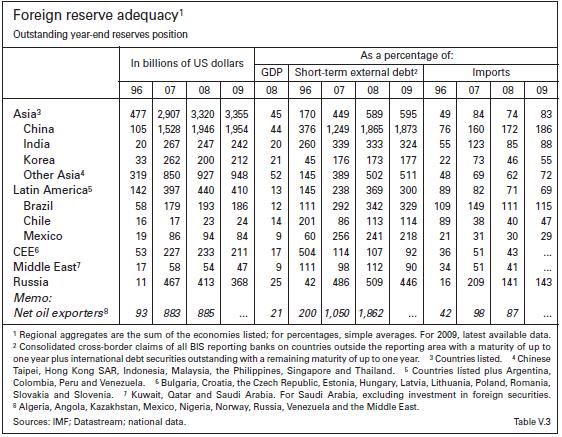 Given such robustness, it’s clear that the impetus to continue accumulating reserves has eroded slightly. Central Banks have also come to realize how vulnerable they are to credit and currency risk, vis-a-vis the allocation of their reserves, which means that the best alternative going forward is probably to start investing in commodities and/or domestic economic initiatives. China has already begun to move in this direction.
Given such robustness, it’s clear that the impetus to continue accumulating reserves has eroded slightly. Central Banks have also come to realize how vulnerable they are to credit and currency risk, vis-a-vis the allocation of their reserves, which means that the best alternative going forward is probably to start investing in commodities and/or domestic economic initiatives. China has already begun to move in this direction.
There are several alternatives that are less risky/expensive than directly holding foreign exchange reserves. “First, in October 2008 four EME central banks each entered into a $30 billion reciprocal currency arrangement with the US Federal Reserve. Second, a $120 billion multilateral facility, drawing on international reserves, was recently established in East Asia…Third, recent G20 initiatives have called for large increases in resources for international financial institutions…[such as the] IMF’s recently created Flexible Credit Line.” Such programs provide countries in crisis with the cash to draw from without forcing them to build up reserves in advance.
To be fair, not all Central Banks are prepared to break from the current system. “In spite of significant interventions in the fourth quarter of 2008, many EMEs still had larger foreign reserves at the end of 2008 than they did in 2007.” Reports are coming in that Indian and Korean reserves, for example, have reached their highest levels since the collapse of Lehman Brothers last fall. This is sounding alarm bells for economic officials: “There is a hope the lesson taken away from the current experience is not that these countries need even larger foreign exchange reserves. These things are not terribly efficient. Our concern is that these things are going to be built up even further as a consequence.”

The Euro has always had a marginal group of naysayers; there were always those who insisted that a common currency didn’t make sense for a region as diverse as the EU. As a result of the credit crisis, a bevy of critics have come out of the woodwork and declared that the Euro will not survive its first official crisis. Are they right?
According to a Special Report on the Euro Area published in the Economist (which inspired this post), the Euro has been a modest success by most measures. “The ECB has fulfilled its remit to maintain the purchasing power of the euro. Since the currency’s creation the average inflation rate in the euro area has been just over 2%. Fears that the euro would be a “soft” currency have proved unfounded. It is unquestioningly accepted at home and widely used beyond the euro area’s borders.” While the Euro hasn’t facilitated meaningful gains in productivity or GDP, it has unquestionably engendered greater stability.
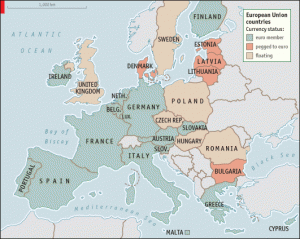
Ironically, the countries that are now complaining the loudest about the Euro are mainly those that benefited the most from its membership. The economy of Spain, for example, “grew at an average annual rate of 3.9% between 1999 and 2007, almost twice the euro-zone average and much faster than in any of the currency area’s other big countries…Unemployment fell from close to 20% in the mid-1990s to just 7.9% in 2007.”
Unfortunately, the economic boom also corresponded with a rise in prices and unit wage costs, both of which are now proving to be particularly painful in the context of recession. Aided by a strong currency, its current account deficit has risen to 10% of GDP. Meanwhile, the same problems are affecting Portugal, Ireland, Italy, and Greece. As the report explains, “The main hazard for investors in high-inflation countries—that a steady loss of domestic purchasing power will drag the currency down—is eliminated in a fixed-exchange-rate zone.”
A country with an independent monetary authority would normally deal with these problems by raising interest rates and/or devaluing the currency. Actually, given how extreme the imbalances are in some of these countries, the markets probably would have accomplished this for them. In this case, however, their membership in the EU and their deference of monetary power to the European Central Bank precludes such possibilities. As a result, the main solutions will have to be originate in the political arena. Wages will have to become more flexible, and labor market controls will have to be loosened, in order to increase productivity.
The alternative – leaving the Euro zone- is unthinkable. “The costs of backing out of the euro are hard to calculate but would certainly be heavy. The mere whiff of devaluation would cause a bank run: people would scramble to deposit their euros with foreign banks to avoid forced conversion to the new, weaker currency. Bondholders would shun the debt of the departing country, and funding of budget deficits and maturing debt would be suspended.” As a result, borrowing costs would increase drastically, which could induce a wage-price spiral. Inflation and currency stability would be tenuous, at best. As a result, it’s not surprising that in most Euro member states, polled citizens remain strongly in favor of the Euro.
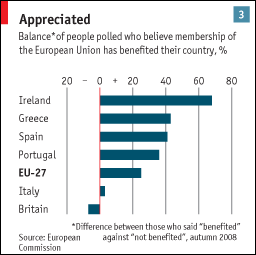
In addition, those on the cusp of joining remain firmly committed to doing so. For such economies, the economic crisis has actually strengthened the case for Euro membership. “As emerging economies they are prone to sudden shifts in foreign-investor sentiment, which makes for volatile currencies, so exchange-rate stability holds considerable appeal for them.” Romania and several baltic states have already had to go hat-in-hands to the EU and IMF to ask for assistance in order to stave off a complete loss of investor confidence. Poland is also vulnerable to currency decline, since many of its loans are denominated in foreign currency; it is currently aiming for Euro membership in 2012.
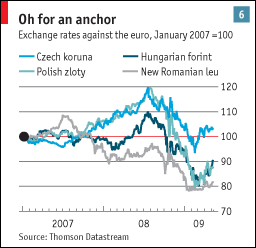
Concludes the Economist, “For all its shortcomings, the euro zone is far more likely to expand than shrink over the next decade. Most EU countries that remain outside, bar Britain and Sweden, are eager to join.” This is certainly a bit glib, and ignores the imbalances that the currency is at least partially responsible for. Still, the tentative consensus is accepting of the Euro. It’s like the old joke about capitalism – “it’s the worst system– except for all of the others…”

The Dollar’s status as global reserve currency was a subject of discussion at two multilateral meetings this week: G8/G20 and BRIC. At the first ever BRIC meeting of the four largest developing economies (Brazil, India, Russia, China) the result was a consensus decision to explore reserve diversification further, while “developments at the Group of Eight meeting of finance ministers helped reinforce the currency’s status as global reserve currency. The statement that emerged from the meeting in Lecce, Italy did not specifically mention currency markets.”
One of the motivations for convening the meeting between the BRIC companies may have been to convey the growing opposition to the Dollar. “The June 16 gathering of the BRICs is the biggest show of unity yet in their bid to win more financial influence — while they take jabs at the U.S. Russian President Dmitry Medvedev said on June 5 that using a mix of regional currencies as a global reserve rather than the dollar would help stabilize the world economy.”
While much of this represents posturing as part of the global power game, there is a certain amount of pragmatism reflected in this attitude. After all, the U.S. is projected to run a $1.85 trillion deficit in 2009, bringing the total debt held by the public close to $10 Trillion. Meanwhile, the Fed – through its quantitative easing plan – is both facilitating this debt and potentially stoking inflation.
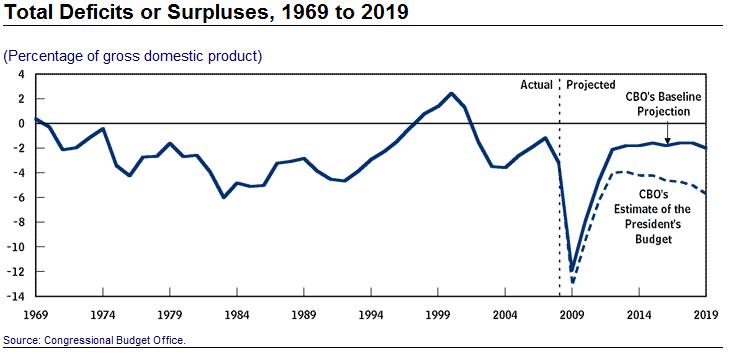
As a result, “The BRICs are putting the U.S. on notice that there has to be a cutback on spending and get their house in order.” The BRIC meeting yielded $70 Billion in commitments to enhanced IMF bonds- commitments that would presumable be funded/collateralized with sales of US Treasury bonds. “The debt will pay a yield similar to Treasuries and will be denominated in the fund’s basket of currencies, known as Special Drawing Rights…The IMF calculates the value of SDRs daily, with 44 percent weighted toward the dollar, 34 percent to the euro and the remainder split between the yen and the pound.”
At the G8, however, participating countries were practically competing with each other to voice their support for the Dollar. “Japanese Finance Minister Kaoru Yosano said his nation’s confidence in U.S. debt is ‘unshakable‘ and that the currency’s global status is safe.” Then, “Officials at Asia’s richest central banks said they would shrug off a U.S. sovereign credit rating downgrade — a topic of speculation recently in markets — and continue to buy Treasuries to keep markets stable.” Even Russia, which was simultaneously denigrating the Dollar to its fellow BRIC members, “said the dollar’s role as the world’s main reserve currency is unlikely to change in the near future.”
For several reasons then, many analysts view the diversification talk as a distraction, especially as it bears on the forex markets: “The raging debate about the future of the U.S. dollar’s reserve currency status may be masking the real drivers of its near-term direction.” First of all, contradictory and ambiguous statements reveal a complete lack of consensus, not only about whether the current system should be abandoned but also with regard to what form an alternative system would assume. For example, neither the Euro nor the Chinese Yuan represent viable alternatives, since the former is too new and the latter is still not fully exchangeable.
Thus, their threats to dump the Dollar have actually been accompanied by an increase in Dollar purchasing, which is required to maintain their currency pegs. “Periods of dollar weakness are therefore met with official dollar purchases…global reserve accumulation, which peaked about $7 trillion last summer, has resumed as the dollar has weakened since March.”
Second, even if Central banks and governments decided to make change, it would take years to implement. “The evolution of a reserve currency would be exactly that, an evolution, not an overnight change,” said one analyst. Another added, “The choice of a reserve currency is not made by central bankers; it chooses itself.” In other words, investors will flock towards currencies that are characterized by liquidity and openness and backed by strong capital markets, not on the basis of politics.
This leads to the third and perhaps most important point, which is that capital flows by private investors dwarf movements by Central Banks, especially in the short-term. While Central Banks are and should be taken seriously by forex markets because of their size, they still account for only one portion of global (Dollar-denominated) foreign exchange holdings. In the short term, investors will continue to move capital around in accordance with their risk/reward profiles. Barring a sudden shift by Central Banks away from the Dollar (which would be counter-productive and a losing proposition), then, it is these private capital flows which will shape the Dollar’s future in the near-term.
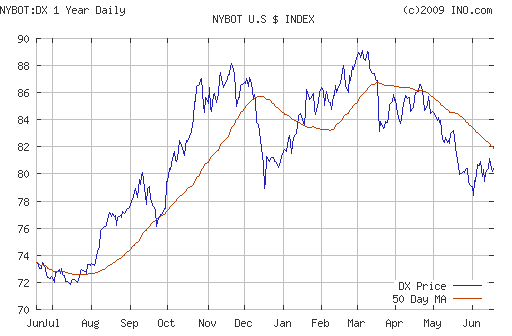

With interest rate differentials, growth trajectories, and risk aversion weighing on (forex) markets, there’s no room in the picture for politics. I preface this post accordingly because current market dynamics are such that even the most dramatic political developments (short of the breakup of the EU) would probably be brushed aside. The long-term, however, is a different story, and investors ignore politics at their peril.
By its very nature, the Euro is perhaps most vulnerable to the vicissitudes of politics. The last week alone brought two significant developments: the downgrading of Ireland’s debt, and a crisis in Latvia. The former weighed directly in the Euro, while the latter probably didn’t have much of an effect. The reason being is that investors viewed the Irish downgrade as a possible precursor to downgrades in other EU economies. Spain and Italy, for example, are in equally precarious positions, and a 6% decline in GDP means German probably isn’t that far behind. In other words, investors may have to rethink their implicit assumption that the EU is currently less risky than the US.
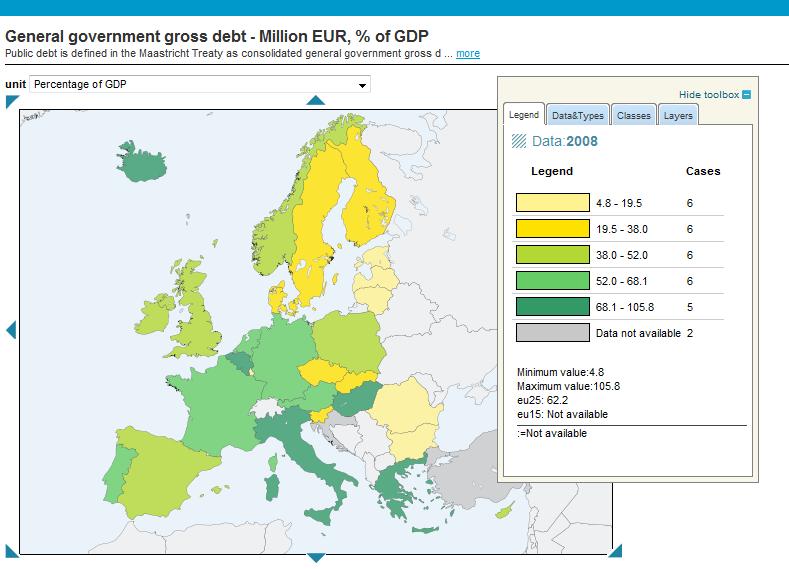
But how do you square fiscal instability against monetary instability? The US is printing money, but EU member states are (marginally) more likely to go broke. Is inflation more conducive to currency devaluation that sovereign bankruptcy? Perhaps the logic is that inflation is acceptable (albeit undesirable) whereas a large-scale default would shake the global financial system to its core; this being the case, it’s probably more practical to bet on the former.
The crisis in Latvia, meanwhile, came in the form of sudden pressure on currency to devalue its currency (known as the Lats), which is pegged to the Euro. The crisis only affects the Euro indirectly vis-a-vis the currency peg and any exposure that European investors have to Latvia. Thus, the Euro wouldn’t drop much as a result of a Latvian currency devaluation, even though the consensus is that such would be “bad” for everyone. For example, it would “trigger a wave of bankruptcies because 80 percent of private borrowing is in euros.”
The crisis is mainly relevant in that it has turned into a framing point for the future of the Euro, which Latvia is slated to join in 2012. “Euro zone entry would recede since the country would have to restart from scratch in the EU’s Exchange Rate Mechanism (ERM) with higher inflation and a bigger budget deficit.” Given that the EU is already slightly unstable (see above for example), why would it want to bring even more unstable economies into the fold of the Euro?
“There is some suspicion that Germany, the EU’s central economy, may want to slow down euro zone enlargement to preserve stability for existing members and perpetuate its orthodox influence over European Central Bank decision-making.” Still, “The EU is a community of law. Treaty rules for joining the single currency cannot simply be torn up in a crisis to admit countries in distress.” In short, there are compelling arguments for both sides. Analysts should watch closely, as the treatment of Latvia (i.e. whether the ECB bends over backwards to help it stay on track) will show how serious the EU is about spreading membership to the rest of Europe.

On June 1, the Forex Blog reported that Brazil is considering a forex tax on capital inflows as a way of discourage the inflow of speculative capital that is causing the Real to appreciate. It turns out that Brazil is not alone; England and France, among others, are also mulling taxes on forex transactions. Their goal is not necessarily to discourage capital inflows, but rather to raise money to fund projects that would otherwise not be viable under current budgetary conditions. The UK “levy would raise $30bn-$50bn a year – enough to double spending on health in low-income countries.” The French plan, meanwhile, would “involve taking 0.005% of the proceeds of currency transactions, perhaps on a voluntary basis, to benefit global aid projects.”
While Brazil and England/France appear to be pursuing different ends, together their plans capture the idea behind the “Tobin Tax.” Originally proposed by Nobel Laureate James Tobin after President Nixon declared the end of the gold standard, the tax would be levied on all forex transactions with the proceeds deposited in forex stability funds. One of the most popular versions would only impose the tax during periods of volatility (i.e. speculation) so as not to punish those exchanging currency for “mundane” reasons.
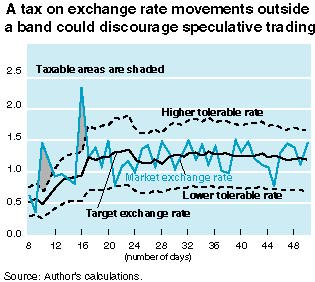 While still a fringe idea, the tax initially gained momentum following the 1997 Southeast Asian economic crisis, and has found new followers in the wake of the ongoing credit crisis. Consider the unprecedented volatility in currency markets of late, manifested in wild daily fluctuations.
While still a fringe idea, the tax initially gained momentum following the 1997 Southeast Asian economic crisis, and has found new followers in the wake of the ongoing credit crisis. Consider the unprecedented volatility in currency markets of late, manifested in wild daily fluctuations.
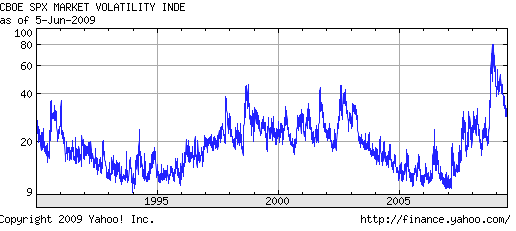 Even the US Dollar, the world’s reserve currency, has been on a veritable roller coaster of late, rising and falling by 10% in a matter of months. Prior to the rise of forex speculation (already a $1 Quadrillion/year market!), it was rare for a currency to move that much in a year. Given that such speculation probably accounts for 90% of daily turnover, it seems obvious as to who is causing this volatility.
Even the US Dollar, the world’s reserve currency, has been on a veritable roller coaster of late, rising and falling by 10% in a matter of months. Prior to the rise of forex speculation (already a $1 Quadrillion/year market!), it was rare for a currency to move that much in a year. Given that such speculation probably accounts for 90% of daily turnover, it seems obvious as to who is causing this volatility.
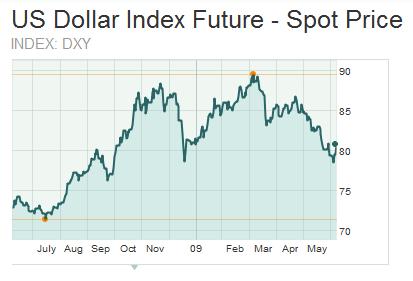 Don’t get me wrong; there’s a role for speculation in the forex markets, just like there’s a role for speculation in all securities markets. When markets function efficiently and players act rationally, currences should and will reflect economic fundamentals and act to minimize global imbalances. Due to the rise of the carry trade and the herd mentality, however, the oppose often obtains in practice. This can cause currency runs and or artificially inflated currencies that compel Central Banks to act counter to the way they otherwise would (i.e. by raising interest rates rapidly to deter capital flight, crimping economic growth.)
Don’t get me wrong; there’s a role for speculation in the forex markets, just like there’s a role for speculation in all securities markets. When markets function efficiently and players act rationally, currences should and will reflect economic fundamentals and act to minimize global imbalances. Due to the rise of the carry trade and the herd mentality, however, the oppose often obtains in practice. This can cause currency runs and or artificially inflated currencies that compel Central Banks to act counter to the way they otherwise would (i.e. by raising interest rates rapidly to deter capital flight, crimping economic growth.)
A Tobin tax would work both to minimize speculation in the short-term (by taxing trades) and promote stability in the long-term (by providing Central Banks with funds that they can use to fight speculative “attacks.” Besides, given that forex traders already enjoy favorable tax treatment – i.e. taxed below the short-term speculative rate – it wouldn’t be the end of forex trading as we know it.

The value of the Thai Baht continues to erode, and the currency has now fallen 10% in the last year. It recently touched a two-year low against the Dollar. Weighing primarily on the Baht is the global economic crisis, so it is hardly unique in this regard. “The government has forecast the economy will contract by 3% this year, which would be the first time it has shrunk in more than a decade.”
Thailand’s economy is heavily reliant on exports, a category which also includes tourism. “The tourism council forecast revenue for the industry this year could drop 35 percent to only 350 billion baht in 2008,” and “The commerce ministry announced that Thai exports fell by 23.1 percent in March year-on-year, the fifth consecutive month of decline.” This is certainly the worst economic crisis to hit since the 1997 Southeast Asian economic crisis, but the country is in much stronger shape this time around. ” ‘Both at the national government level and in the private sector, the balance sheets are much stronger.’ ” As a result, Thailand has thus far managed to stave off a run on its currency, even despite a decline in investment- both direct and speculative. The Thai stock market is sagging; according to one commentator, “Fund flows could continue to drag the market down as we see profit-taking in this region.”
The government and the Central Bank are working in tandem to relieve the situation, but there isn’t much optimism surrounding their efforts. The Minister of Finance recently announced an (attempted) expansion of Thailand’s own version of an economic stimulus plan, to $40 Billion. Funding will be provided for “investment projects in a wide range of industries such as logistics, agriculture and energy. The Bank of Thailand recently slashes rates to 1.25%, tying a record low that was set in 2003.
However, “The decision to cut the rate by a quarter percentage point to 1.25 percent came as more than 40,000 protesters seeking to oust the government were massed in the capital Bangkok.” The political unrest in Thailand is old news at this point. It began over a year ago when then-Prime Minister Thaksin Shinawatra was ousted in a military coup. Since then, there have been an unending series of protests and counter-protests aimed at keeping him out or bringing him back. Basically, no one is happy with the current situation, but still there are no signs of political change. The Prime Minister has refused requests to resign, and Thaksin remains in exile outside the country.
The political uncertainty isn’t really weighing on the Baht, but one analyst warns this could change: “The baht is likely to underperform in the near term due to political tensions, which have prevented the government from undertaking aggressive fiscal stimulus.” In other words, while tourism has been impacted by the protests, the biggest problem is that the government is being hamstrung in its efforts to forge a strong response to the economic crisis.
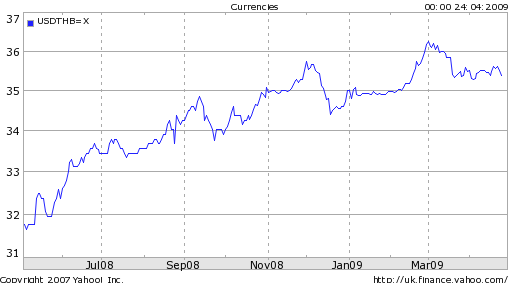

Last week, SDR became the latest addition to the growing list of forex acronyms. So-called Special Drawing Rights are a unit of account used by the IMF, “defined as the value of a fixed amount of yen, dollars, pounds and euros, expressed in dollars at the current exchange rate. The composition of the basket is altered every five years to reflect changes in the importance of different currencies in the world’s trading system.”
The sudden rise to popularity of SDRs (in spite of their 40 year history) can be attributed both to developing countries’ growing unease about the status of the Dollar, as well as to their perceived usefulness as a tool in fending off economic depression. Ignoring the latter- for the purpose of this post- let’s look, at how SDRs will impact the role of the Dollar as the world’s reserve currency.
First of all, as I noted in Tuesday’s post, the success/scope of the SDR program depends on the positions of the US and EU, the largest and most important members. In the case of the US, the most recent SDR expansion (1997) was never implemented because the US blocked it. Neither can the support of the EU be taken for granted. According to one member of the European Central Bank, “There was no examination of whether there is a global need for additional liquidity at all… One used to take a lot of time to examine something like this.”
In addition, it’s not clear what benefits the synthetic currency would yield. Asks one commentator: “What is one to tie it to?…in a world of depleting resources it is difficult to fathom how to create a list of constituents which would not constrain global growth and tie us into many years of deflation.” In other words, given that the SDRs will derive their value from underlying currencies, it doesn’t seem like the end result would be anymore stable than the current system.
China, meanwhile, has showed fervent support for the expansion in the form of a $40 Billion pledge, which is not surprising since a report issued by the head of its Central Bank provided some of the impetus. This $40 Billion is tantamount to an exchange of Dollars for a basket of currencies. The benefit to China is articulated by one analyst as follows: “ ‘We could see the IMF being put in a position where it could raise in the capital markets funds in SDR-denominated debt….The debt could be used ‘by China and other central banks to be put into their currency reserves, at the expense of the U.S. dollar.’ “

The period leading up to the G20 meeting was generally marked by optimism and hopefulness. One commentator urged his readers: “Don’t write off the London G20 meeting. It could lay the foundations for fundamental global change, impacting currencies, gold and bond markets.”
On some level, the meeting probably did fulfill expectations. After only a few hours of discussions, the G20 agreed to “stricter limits on hedge funds, executive pay, credit-rating companies and risk-taking by banks. The summit also committed more than $US1 trillion to boost the resources of the International Monetary Fund and provide emergency cash to help distressed countries.”
Investors rejoiced and the markets rallied, with the Dow rising above 8000 points and capping “the best four-week rally since the week ending May 12, 1933.” Bulls can now retort that the stock market bust of 1929 took four years to recover, while the recession of 2008-2009 required less than one year. Forex markets also reacted “positively” to the G20 summit, lifting the Dollar above the important psychological barrier of 100 Yen/USD, and causing emerging market currencies to rise across the board.
Monday, however marked a return to business as usual: “Post-G20 euphoria, which had helped to boost market confidence about a global recovery, proved short-lived as investors once again focused on the continued risks to the banking system.” It was probably only a matter of time before investors drilled beneath the surface of the impressive-sounding G20 rhetoric and large numbers, into the nuts and bolts of the summit’s policy prescriptions. [The chart below comes courtesy of the New York Times].
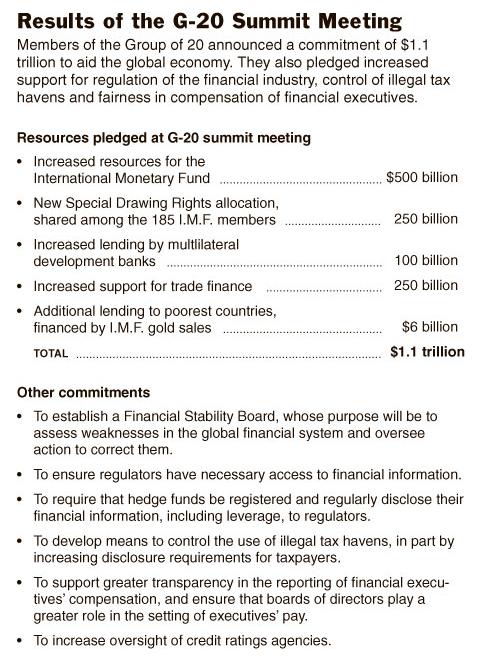
The headline-grabbing $1.1 Trillion figure, for example, is somewhat misleading. Over half of the $500 Billion “pledged” to the International Monetary Fund has either not been raised or not been explicitly authorized. Then, there is $350 Billion in trade credit, most of which is either redundant or double-counted, since “trade financing is rolled over every six months as exporters get paid for their goods and repay the agencies that lent them the money.” The remaining $250 Billion is accounted for in the issuance of IMF synthetic currency to member nations. However, given that the synthetic currency derives a significant portion of its value from the Dollar and Euro, this program cannot be effective if the US and EU opt out, of which there is a real possibility.
The summit also failed to meaningfully address concerns of the continued ole of the USD as the world’s de facto reserve currency. The expansion of the IMF synthetic currency program represents an important starting point, but at this point, it looks like China and the other supporters of an alternative system will have to wait for the next G20 meeting, to be held in September.
One commentator captured this frustration quite well: “The G20 Plan…tries very hard to preserve and perpetuate the existing US helmed global financial and economic order. An act of commission, on the one hand— buttressing the IMF— and an act of omission, on the other— remaining silent on the position of the US dollar— bear testimony to this.”

“China is a hostage. China is America’s bank and America basically says there’s nothing you can do to me. If I go down you don’t get paid.”
While the Obama administration has pledged the kind of fiscal responsibility that would secure its government obligations, its actions haven’t been so responsible. The Fed recently announced purchases of $1 Trillion in government debt, while the government is set to rack up Trillion-Dollar deficits over the next decade, even by the most conservative estimates.
In other words, China is in a quandary; stop lending to the US, and you might see the value of your existing reserves plummet. Continue lending, and you risk the same result. Tired of participating in this apparent no-win situation, China is finally taking action.
First, it will petition the G20 at its upcoming meeting for some level of protection on its $1 Trillion+ “investment” in the US. Meanwhile, Zhou XiaoChuan, governor of the Central Bank of China, has authored a paper calling for a decline in the role that individual currencies play in international trade and finance. According to Mr. Zhou, “Most nations concentrate their assets in those reserve currencies [Dollar, Euro, Yen], which exaggerates the size of flows and makes financial systems overall more volatile.” His point is well-taken, since of the $4.5 Trillion in global foreign exchange reserves that can be identified, perhaps 85% are accounted for by Euros and Dollars alone. When crises occur, everyone flocks to these currencies.
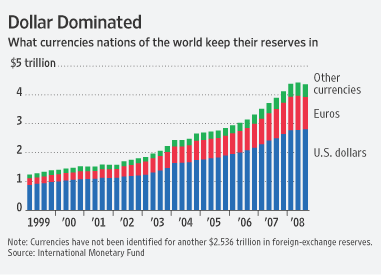
Mr. Zhou’s proposal is not without precedent. “His idea is to expand the use of ‘special drawing rights,’ or SDRs — a kind of synthetic currency created by the IMF in the 1960s. Its value is determined by a basket of major currencies. Originally, the SDR was intended to serve as a shared currency for international reserves, though that aspect never really got off the ground.” It’s not clear exactly how such a system would work, but the idea is straightforward enough; instead of holding individual currencies, which are inherently volatile, Central Banks would be able to denominate reserves in a sort of universal currency. Instead of parking money in US Treasury securities, they would hold IMF bonds, or some equivalent.
Even before China starting becoming more vocal about its concerns, analysts had begun questioning the role of the US as reserve currency. I’m not just talking about the perennial pessimists. Within the context of the current credit crisis, a bubble may be forming in the market for Treasury bonds. “Foreign buying of American financial assets by both private investors and governments averaged $141 billion from September to December, Treasury data show…Demand was so strong that, for the first time, investors accepted rates below 0 percent on three-month Treasury bills to safeguard their capital.”
There is concern that a slight recovery in risk appetite (of which there is already evidence) could ignite a massive sell-off: “People are sitting there holding massive amounts of zero- yielding dollar assets. If there is any sort of good news, demand for dollars can drop off very, very quickly.”

In the wake of the Swiss National Bank intervening to hold down the value of the Franc, everyone is wondering whether the Bank of Japan (and perhaps other Central Banks) will follow suit. Asks one market commentator rhetorically: “How long do you think it will be until Japan tries once again to push the yen lower, with its export industries in tatters?” Given that the Japanese economy is forecast to contract for at least the next two quarters, and also that its trade balance recently slipped into deficit, this is an eminently reasonable question.
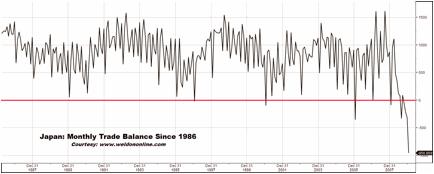
Even prior to the surprise SNB announcement, it was widely speculated that the Bank of Japan would intervene on behalf of the Yen. After all, the BOJ was the most recent Central Bank to have waded into forex markets; it unsuccessfully spent $350 Billion in 2003-2004 to hold down the Yen. Since the inception of the credit crisis, however, it has passed on several golden opportunities. “It declined to intervene in October when the Group of Seven industrial powers issued a rare inter-meeting statement singling out yen volatility, giving Japanese authorities the green light to stem its surge. Even when the yen hit a 13 1/2-year high of 87.10 per dollar in January and exports demand collapsed, the BOJ held back.”
Since the beginning of 2009, the Yen has fallen 8% against the Dollar, and has fallen to a 3-month low against the Euro. Now, the “pendulum is swinging the other way” as risk aversion eases up and investors turn their attention to macroeconomic fundamentals. “The yen’s safe-haven appeal has, however, lost some of its lustre due to a rapid deterioration in Japan’s economy…and political uncertainty with an unpopular government facing an election that must be held by October.”
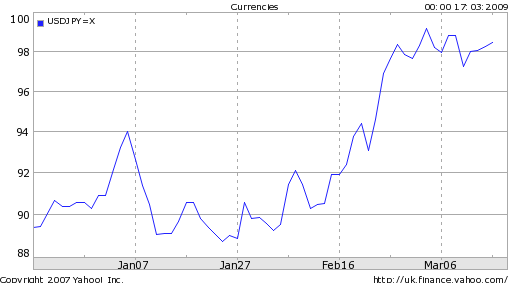
Nonetheless, the Yen has not yet slipped below the psychologically important 100 Yen/Dollar barrier. Analysts speculate that this is due to capital repatriation by Japanese investors, for hedging and accounting purposes. In order to minimize forex conversion losses, Japanese retail investors are taking advantage of the relatively weak Yen by shifting funds into domestic value stocks. Japanese companies, meanwhile, are ” ‘dressing up’ their balance sheets ahead of their fiscal year-end, by liquidating foreign holdings and bringing home the profits from overseas subsidiaries, to raise their bottom lines.”
The likelihood of BOJ intervention is paradoxical. If investors fear intervention, they will sell the Yen, and in turn, minimize the need for intervention. On the other hand, if investors remain skeptical of intervention, they may buy the Yen, which could actually impel the BOJ to intervene. But putting game theory aside, most analysts remain convinced that economic and political circumstances point away from intervention as a real possibility.

Most of the “safe haven” talk in forex circles has focused on Japan and the US. Switzerland, meanwhile, has also attracted is fair share of risk-averse investors, who are piling into Franc-denominated assets, despite the deteriorating Swiss economic situation. In fact, February witnessed an inflow of $4 Billion, most of which was targeted towards gold and money-market funds. The Swiss Franc, as a result, has appreciated by 9% (on a trade-weighted basis), since the summer.
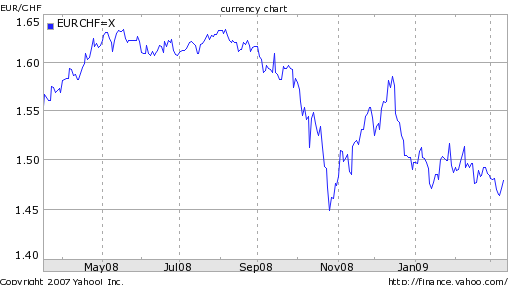
The Swiss National Bank (SNB), meanwhile, has cut interest rates by 225 basis points over the last six months. If it delivers on a unanimously-anticipated 25 basis point cut at its meeting tomorrow, its benchmark lending rate will stand at a paltry .25%. To the frustration of the SNB, the “deflation trade” is still in vogue, as traders have counter-intuitively taken to betting on the countries and currencies that offer the lowest interest rates. From an economic standpoint, this trend is eroding the effectiveness of an easy monetary policy, such that the SNB has been forced to consider less conventional approaches.
This would probably take the form of quantitative easing, in the same vein as that which the US and UK are currently pursuing. Under such a policy, the SNB would buy credit instruments on the open market, and pay for them by printing money. This would have the dual effect of devaluing the Franc and easing liquidity problems in Swiss securities markets. While normally a country in Switzerland’s position (especially one whose banks have recently come under fire for secret bank accounts would take flak for such a policy, Swiss (economic) neutrality largely eliminates this burden. Another alternative, which has been proposed by the heir-apparent for SNB chief, is to create a ceiling on the value of the Franc.
Either way, a lower Franc looks like a real possibility. Says one analyst, “Switzerland is likely to…cut interest rates and intervened [sic] verbally to weaken the Swiss franc, threatening unsterilised intervention. If this does not work, and we are sceptical that it will, actual intervention may be required and we suspect this will have some impact. The bottom line is that the franc looks vulnerable.”

Growth in Poland, the biggest eastern European economy, will slow to 2 percent, the slackest pace since 2002, the European Commission forecasts. Latvia, a former Soviet republic, will contract 6.9 percent.

The credit crisis continues to exact a devastating toll on the economies of Eastern Europe, and capital flight has caused the region’s currencies to plummet precipitously. This has prompted internal debate in countries such as Poland, Czech Republic, and Latvia – to name a few- as to whether the effects of the crisis would have been so blunt had they adopted the Euro. While certainly Euro membership would have spared them from currency instability, it would not have necessarily facilitated financial and economic stability, as Italy, Spain, and Greece have learned the hard way. Regardless of whether Eastern European countries are politically willing to commit to the Euro (itself doubtful), this debate is largely moot, since the credit crisis has all but eliminated their ability to meet the preconditions of membership in the short run. The New York Times reports:
Read More: Currency Issues Weigh on Eastern Europe

It appears Timothy Geithner, recently-appointed US Treasury Secretary, was not exaggerating when he declared that the Obama administration intends to address China's currency policy. No less than President Obama himself rrecently called Hu JinTao, President of China, to inform him likewise. Unfortunately, the administration does not exactly have support from political and economic analysts. They argue that not only is the Yuan's "true" value debatable, but also that now is not an opportune time to pursue this issue, due to current economic circumstances. Givent that the Yuan has been permitted to appreciate almost 20% in the last four years and that the Chinese accumulation of forex reserves has begun to slow, perhaps Obama's prodding could even backfire. Bloomberg News reports:
There’s also a be-careful-what- you-wish-for angle here: If China tomorrow let the yuan trade freely in markets, it’s more likely to drop in value than surge. So-called hot money may flee, global companies may repatriate profits and Chinese savers might buy overseas assets.
Read More: China Tells Obama What to Do With His Yuan Views

Only last year, Greece, Ireland, Italy, Portugal and Spain were collectively the pride of the EU, boasting strong growth characteristics and buoyant capital markets. In hindsight, this was but a mirage, as the stability of Euro-membership allowed such "peripheral" economies to embark on a colossal building boom and spending spree that was ultimately baseless. Greece, which is perhaps in the worst shape of the lot, witnessed its twin deficits (government debt and trade) rise to dangerous levels; given its membership in the EU, it is unable to resort to currency depreciation to rectify the problem.
The illusion has since been shattered, and it seems investors are trying to overcompensate for their previous naivete. Yields on government bonds for all five countries have begun to creep up, and a handful of speculators are betting on the possibility of default. Most experts insist that such a scenario is unlikely, but at the very least, the credit crisis has exposed the chinks in the armor of the EU, demonstrating that the currency also has its drawbacks. The New York Times reports:
While sharing a currency with some of the mightiest economies in the world helped Europe's poorer nations share in the wealth, a boon during boom times, in hard times the rules of membership are keeping them from doing what countries normally do to ride out economic storms, including enormous spending.
Read More: Once a Boon, Euro Now Burdens Some Nations

During his confirmation hearings, Treasury Secretary Geithner indicated that the Obama administration consensus is that China is manipulating the Yuan. China predictably refuted the charges, and indicated that it will not be bullied into submission by the US when managing its currency. Thus began a heated back-and-forth between US and Chinese economic officials, with the forex markets caught awkwardly in the middle. Geithner apparently doesn't realize that his position also carries important diplomatic responsibilities, namely helping the US government to pay its bills by ensuring a steady demand for US Treasury securities abroad. Offending the most reliable foreign lender, accordingly, is probably not the best strategy to fulfilling this role. Moreover, Geithner's testimony couldn't have occurred at a worse time, given the planned expansion of US debt and the simultaneous leveling off of China's forex reserves. The implications for the Dollar couldn't be clearer. Forbes reports:
China has been a major purchaser of America's official debt in recent years. If it were to stop…Geithner would likely find his Treasury paper having to offer higher yields to draw investors, putting new pressure on the American budget.
Read More: China Speaks, U.S. Debt Market Listens

The deepening of the credit crisis in the EU has triggered a wave of self-reflection, prompting those on the inside to ponder life without the Euro and those on the outside pondering life with the Euro. Their opinions couldn't be any more divergent. Countries like Italy, Spain, and Ireland, for example, have blamed the Euro for their economic woes, arguing that easy monetary policy and cheap credit were responsible for their real estate bubbles. Some commentators, accordingly, have argued that structural differences between these countries and the economic powerhouses of Germany and France are so large that it doesn't make sense for them to share a common currency. Meanwhile, Eastern European countries, most of which are still outside the Euro, are clamoring to join as sudden depreciations in their respective currencies have exposed them to massive economic instability. Business Week reports:
What happened, in effect, was rapid economic isolation. This began as investors moved money from more risky regional stock and currency markets into safer, often euro-denominated, assets, in what economists call a "flight to quality."
Read More: The Euro's Growing Appeal

While much has been written about the forex implications of the Barack Obama Presidency, most of the commentary has focused on the Dollar, at the expense of reporting on other currencies. The Chinese Yuan, to name one such currency, could soon find its fate tied closely to Obama; it has been widely speculated that he will compensate for the reticence of his predecessor by formally labeling China a currency manipulator and pressuring its to allow the RMB to appreciate at a faster pace. Timothy Geithner, who is set to be confirmed as the next Treasury Secretary, has echoed similar sentiments. It is unclear whether such a sentiment would achieve the necessary legislative support required to levy punitive sanctions against China in order to force it into submission. Given the current global economic climate, however, it seems unlikely that China would comply. Marketwatch reports:
In fact, China itself has every reason to avoid both depreciation and appreciation of its currency. The latter could further weigh on already drooping exports, and the former could lead to capital outflows from the country, at a time it can least afford this.
Read More: Investors await Obama's signals on China's yuan

US government bond issuance in 2008-2009 will shatter all previous records. Fortunately, risk tolerance remains low as a result of the ongoing uncertainty surrounding the credit crisis,and demand for US Treasuries remains proportionally high. However, analysts are beginning to wonder just how much more the market can support, as it appears that a bubble has begun to inflate. A slight recovery in risk appetite, and/or institutional investor concern that the bubble is on the verge of popping could trigger a mass exodus from US Treasuries. Moreover, foreign holders would likely rush to repatriate the proceeds in order to minimize currency conversion risk. The result would be a self-reinforcing downward spiral between the Dollar and bond markets. Reuters reports:
A tanking U.S. dollar on the back of a decline in the U.S. bond market would signify the global economy may not be recovering anytime soon, however, which could leave very few places to hide.
Read More: Dollar investors wary of bond market bubble

Economic and monetary fundamentals throughout the world have become so paltry that one analyst notes tongue-and-cheek that investing in forex has become tantamount to identifying the "least worst" currencies. In virtually every country, all economic indicators are pointing downward, with the lone exceptions of unemployment rates and government spending. In other words, continuing declines in both production and consumptionherald a protracted worldwide recession. On the monetary side, Central Banks have embarked on a race to the bottom, with interest rates on pace to converge at 0% sometime in late 2009. Meanwhile, most governments have announced vast stimulus plans, which could prove highly inflationary if they can't find lenders willing to provide financing. In such an unfavorable climate, where then should savvy forex investors turn? The Financial Times reports:
Asian (ex-Japan) currencies, with relatively healthy banking systems, limited debt problems, positive demographics and undervalued currencies should be the natural harbour for fundamentally-driven investors. Commodity currencies, such as the Brazilian Real, Norwegian Krone, or Canadian dollar, offer characteristics akin to those in Asia and…[could also] participate in the rally.
Read More: A homely parade in the currency 'ugly' contest

The British Pound has fallen so sharply in 2008 that parity with the Euro isn't that far-fetched. The problem is that the UK economy now closely mirrors that of the US, minus the perceived "safe haven" aspects. In fact, the UK now has a twin deficits problem of its own, with a trade imbalance that exceeds 4% of GDP and government spending set to rise in response to the credit crisis. Meanwhile, UK interest rates have already been reduced drastically, and could fall all the way to zero, again mirroring the US. The combination of cheap money and higher imports is raising the specter of inflation, and frightening away foreign investors. Under ordinary circumstances, a cheaper Pound could be an effective remedy for recession, but when the entire global economy is reeling, it probably can't accomplish much. The Telegraph reports:
Even though sterling has fallen, exports orders remain weak. Competitive devaluations rarely work. But they have no chance of when the rest of the world is slowing too.
Read More: Weak sterling means the UK will take a pounding

Since its introduction only ten years ago, the Euro has ascended at an incredible pace. Perhaps the best proxy for its respectability is its growing share (currently estimated at 27%) of Central Banks' foreign exchange reserves. Still, most analysts reckon that the Dollar will remain ascendant for the near-term. For one thing, the perception remains that the US is the safest place to invest, and in fact this attitude has been reinforced by the current economic downturn. In addition, there is very limited doubt that the Dollar will be around for a very long time, whereas there are many skeptics who invariably insist that the Euro is on the verge of breaking up. In short, as the global economy rebalances itself, reserve accumulation will slow generally, and diversification into the Euro will slow specifically. Marketwatch reports:
In view of the value already tied up in holdings of U.S. government paper, it would take a decisive — and probably foolhardy — shift for the world's largest reserve holders in Asia or Latin America to transfer significant holdings of present reserves out of the dollar and into the euro.
Read More: Reserve shifts into the euro will slow

Having fallen well below parity with the USD, the Canadian Loonie is now being attacked on two fronts. First, there is the deteriorating economic situation. Prices for virtually all commodities, namely oil, have declined significantly this year, dealing a harsh blow to the natural resource-dependent Canadian economy. In addition, its largest trade partner, the US, is suffering from economic woes of its own and is in no position to support the Canadian export sector. The result is surging unemployment and the most precipitous decline in factory production in 25 years. The most optimistic economists are forecasting GDP growth of 0.0% in 2009. The second prong of the attack against the Loonie is being waged unintentionally by the country's Prime Minister, who recently suspended Parliament in order to avoid a no-confidence vote in his leadership. In short, bulls for the Canadian Dollar (not to mention democracy) don't have much to be excited about these days. Bloomberg News reports:
"The global backdrop is bearish for the Canadian dollar and domestic numbers are merely piling on,"said a senior currency strategist. "No one is looking for reasons to buy the Canadian dollar right now. They want reasons to sell."
Read More: Canada's Dollar Posts Weekly Decline on Jobs, Politics, Oil

Only a few weeks ago, investors had made significant bets that China would reverse its official policy of RMB appreciation. Futures prices indicated that investors collectively expected the currency to depreciate over 7% against the Dollar over the next year, as part of a comprehensive Chinese policy to boost the faltering economy. Since then, however, the RMB recorded its biggest one-day rise since the currency peg was abandoned three years ago, and investors subsequently scaled back their bets.
While it's unclear what caused the sudden change in sentiment, there are a few factors which probably contributed. First is Treasury Secretary Henry Paulson's recent visit to China, in which he encouraged China to continue to permit the the Yuan to appreciate. In addition, high-ranking Chinese economic policy-makers have indicated that market forces will increasingly determine the valuation of the Yuan. Finally, there is the recent election of Barack Obama, a long-standing critic of what he believes to be the undervalued RMB. Bloomberg News reports:
"Any attempt to devalue the currency is likely to be met with considerable opposition from China’s trading partners." The new U.S. administration under President-elect Barack Obama "will be less tolerant of the 'crawling peg' appreciation policy," said one analyst.
Read More: Yuan Forwards Advance Most Since Peg as China Seeks Stability

Officially, Japan has not intervened in forex markets since 2004, when it spent the equivalent of $300 Billion to hold down the value of the Yen. That impressive streak could soon come to and end, however, as the Yen continues to surge on the unwinding of the carry trade. The performance of the Yen- which recently touched a 13-year high- is particularly impressive since it comes at a time when virtually every other currency has collapsed relative to the US Dollar. Now, analysts have once again taken to pouring over monthly data on Japan’s Central Banking activities, in order to confirm that it is keeping its finger off of the trigger. Given that the Yen’s appreciation has already prompted several high-level meetings among global economic and political leaders, however, it is probably only a matter of time before Japan ends its multi-year abstinence from forex. Reuters reports:
Japanese Finance Minister said earlier this month that the authorities must be ready to deal with big swings in markets as they are undesirable. His comments pushed the yen lower against the dollar as market players were wary of intervention.
Read More: Japan did not intervene in currency market in Nov

Since China revalued the Yuan in July 2005, it was considered a foregone conclusion that the currency would continue appreciating at a steady clip. The global credit crisis, generally, and the Chinese economic downturn, specifically, has turned that assumption on its head. Last week, the RMB declined by the biggest margin since the revaluation, prompting speculation that China will adopt a currency policy diametrically opposed to that which it has pursued over the last few years. The move also coincided with the annual China-US trade summit, attended by none other than Treasury Secretary Henry Paulson. The new consensus among currency traders (proxied by futures contracts) is that the Yuan will depreciate slightly over the next two years, as China moves to provide a boost to its export sector. Given that the currencies of most of China’s Asian neighbors have fallen by double digits over the last year, the Yuan may have to fall sharply in order to maintain competitiveness. The Wall Street Journal reports:
the Chinese currency hasn’t experienced a large devaluation in at least a decade. Such a move would go against the realities of geopolitics and against signals that Beijing is more focused on boosting domestic consumption than on stimulating exports.
Read More: Will China Finally Try Wielding Its Yuan?

What does the appointment of New York Federal Reserve President Timothy Geithner as Treasury Secretary mean to forex traders? To answer this question, it depends on which side of the Dollar you fall in. Geithner worked in the Treasury Department under Bill Clinton, which means he is well versed in the Strong Dollar policy. It is not clear whether such a policy will be implemented under the Obama administration, which may be counting on the export sector to fill the gap created by a decline in domestic consumption. Regardless, the consensus among analysts is that Geithner understands currency markets, and is not likely to take steps that will rattle them. This would mark a sharp break from his predecessor Henry Paulson, whose bungling of the economic bailout has given rise to record levels of volatility (read: uncertainty) in forex and financial markets. The Australian reports:
"For all the currency traders out there, this means he was in charge of US dollar policy and is steeped in the nuance of the currency markets…Unlike during rookies Paul O’Neill or John Snow’s tenure, we won’t get many mistakes to make easy money," said [one analyst].
Read More: ‘Safe pair of hands’ Timothy Geithner tipped for US Treasury

The economic situation in Indonesia is similiar to that of several other emerging market economies, characterized by falling export revenue, shrinking government coffers, and capital flight. The consequent decline in the Indonesia Rupiah has almost become self-fulfilling. In other words, as skittish investors rush to move their capital out of Indonesia for fear of complete collapse, they are simultaneously making such a collapse more likely. Indonesian policy-makers are conscious of this tendency of nervousness to feed back into itself, and are delicately trying to avoid shocking the markets. On the one hand, they want to limit the decline of the Rupiah. On the other hand, they don’t want to take actions that will make investors nervous, even if it means making it more difficult for them to short the currency. The International Herald Tribune reports:
Last week, Indonesia changed its currency rules to make it more difficult to buy foreign exchange. The measures, mostly affecting Indonesians rather than foreigners, would make speculative bets against rupiah depreciation more difficult.
Read More: Indonesia undergoing currency crisis

The European Union has unveiled an economic stimulus package to match the US, as the two economies continue to mirror each other’s strategies for fighting the credit crisis. Given the evident lack of effectiveness of the US plan, it is no surprise that analysts reacted pessimistically to the policy proposal. At this point, investors and consumers alike appear resigned to the inevitability of economic recession in both economies. In other words, there isn’t much that government can achieve, as their respective efforts will certainly be undermined by increased saving. Besides, investors (including currency traders) remain focused on the financial aspects of the credit crisis, rather than the economic aspects. Accordingly, the theme of risk aversion continues to dominate, as part of a trend that favors the Dollar. Reuters reports:
Analysts said that the plan marked a step in the right direction, but uncertainty about its efficacy, and general concerns about a deep slowdown in the global economy were keeping investors in the mood to sell risky assets.
Read More: EU stimulus package raises concerns

Having endured years of abuse from free-market advocates and the International Monetary Fund, fixed exchange rate regimes are officially back in vogue. This is because the sole currencies not to have been affected by the recent surge in forex volatility are those that are pegged to the US Dollar, namely the Chinese Yuan and Hong Kong Dollar. Both countries have stood by calmly as other emerging market economies have witnessed speculators lay waste to their currencies, driving them down by 5% or more per day. Fortunately, both HK and China have significant stockpiles of foreign exchange reserves, which virtually eliminates any possibility of a speculative attack. Iceland, meanwhile, was forced to abandon a half-hearted attempt at a currency peg when it ran out of cash to defend it. Of course, a fixed currency can also be a disadvantage, as exports may become expensive relative to competitors that experience declines in their currencies. Given the current economic climate, however, it seems HK is happy to give up this potential upside in favor of stability. The Wall Street Journal reports:
Like Japan, Hong Kong was a source of funds for the carry-trade. Turbulent markets have taken that strategy apart, and investors who borrowed in Hong Kong are pulling money back into the territory at a rapid clip.
Read More: Hong Kong Loves Its Currency Peg

The last few months have born witness to an unprecedented level of volatility in forex markets, to say nothing of the fluctuations in other areas of securities markets. Emerging markets currencies in particular, as well as a handful of industrialized currencies, have crashed violently, as a process of de-leveraging continues to send capital back to the US and Japan. This instability has led some policy-makers to revive an erstwhile exhortation to limit the role of speculators in forex markets, who collectively may account for as much as 90% of daily forex turnover. Specifically, a 1% tax on all forex trades has been proposed, which would be deducted automatically and used to finance infrastructure projects around the world. It has also been suggested that forex markets follow the lead of equity markets by adopting a so-called "up-tick" rule, which would be used to counter sudden waves of predatory short-selling that can cripple a country’s currency in minutes. CSRwire reports:
Such bear raids are rarely to "discipline" a country’s policies, as traders claim, but rather to make quick profits. In the transparent FXTRS system, traders selling falling currencies begin to see that the rising tax is cascading into the country’s currency stabilization fund and cutting into their gains.
Read More: Why Obama Missed Bretton Woods II

After rising nearly 20% over the last three years, the RMB has virtually stopped appreciating against the US Dollar, perhaps as a result of the credit crisis. At the same time, the US exports sector- previously one of the few bright spots of the sagging economy- has begun to stall. US Politicians have taken note, and are now renewing their efforts to persuade China to allow its currency to rise further. They are also agitated about China’s perpetually growing forex reserves (currently estimated at $2 Trillion), which are increasingly being deployed in sensitive areas. Meanwhile, the Chinese economy is growing at the slowest pace in years, and the Chinese government is resorting to desperate measures to prop it up. In short, allowing the RMB to rise, while placating US policymakers, is tantamount to economic suicide, and hence unlikely.
While other sovereign wealth funds have existed for nearly 50 years without controversy, "China appears far less likely than other nations to manage its sovereign wealth funds without regard to political influence that it can gain by offering such sizable investments."
Read More: US panel urges action on China currency, investing

In light of the credit crisis, commentators on the Euro have taken to one of two extremes; either they believe the Euro is doomed, or they argue that the Euro represents the key to EU economic salvation. The naysayers point to recent trends in financial markets such as the widening spread between German and Italian bond yields. They further argue that a common monetary policy exacerbated the credit crisis by fomenting real estate booms in overheated economies, namely Ireland and Spain. Supporters, on the other hand, need to look no further than the complete economic collapse in Iceland to understand the advantages of the Euro. Moreover, some of the more fragile EU members (Luxembourg, Belgium) would have witnessed runs on their currencies, if not for their participation in the common currency. In the end, the Euro probably represents a viable investment alternative to the Dollar and it brings the benefit of relative stability to its members. While its supporters are prone to overstating its benefits, it’s not likely at risk of crumbling in the next few years. The Economist reports:
The euro’s defenders are convinced that the currency will still be there at the end of the crisis. That is a reasonable bet. But public support for the euro may still be painfully tested as economies deteriorate.
Read More: No room in the ark

While the Bush Administration nominally embraced a strong Dollar policy, the currency’s 20% decline over the last eight years suggests it was actually a low priority. The Obama administration, in contrast, is much more likely to maintain such a policy, a circumstance which could help the Dollar to continue its year-long rally. Obama will assume the office of the presidency at a time when US finances are looking particularly tenuous, with a projected 2009 budget deficit of $1 Trillion. In order to finance the government bailout, as well as an additional economic stimulus plan and a host of other initiatives (let’s not forget the two ongoing wars), Obama will need to spearhead an effort to attract more foreign capital. For this to happen, the Dollar’s status as the world’s reserve currency must be cemented and confidence in the Greenback must be restored. Ironically, Obama may receive a boost in this aspect from the credit crisis. The Guardian reports:
The dollar [rally] is likely to persist as market participants looked to snap up more U.S. assets after the decisive election of a candidate that promised to bring sweeping changes to a country mired in the worst economic crisis since the Great Depression.
Read More: Obama win cements need for strong dollar policy

With the Dollar rallying to multi-year highs and the Yen surging to multi-decade highs, some analysts have begun to re-assess the possibility of Central Banks intervening in forex markets. As if on cue, leaders from the G8 countries also released a statement expressing their concern. It is not a stretch to say the last few weeks have been awash with stories about emerging market economies that have been destabilized as a result of the rapid depreciation of their currencies, as well as companies that were forced into bankruptcy as a result of currency speculation gone bad. Meanwhile, the US and Japan are certainly nervous about the impact of more expensive currencies on their respective export sectors. Ironically, it was only six months ago that some analysts were gaging the same probability of intervention; at that time, however, the purpose would have been to prop up the Dollar, whereas now it would be to bring it back down to earth. I suppose the moral of the story is that in forex terms, six months is practically an eternity. Besides, as we reported yesterday, both the Dollar and the Yen have already begun to fade. The Wall Street Journal reports:
"But, this is not a currency crisis" said a foreign exchange strategist. "This is a liquidity crisis, a growth crisis, a confidence crisis. As such, probably the first step should not be to intervene to save currencies."
Read More: Do Currencies Require an Intervention?

The G7 Industrialized Nations met today in Tokyo to discuss the credit crisis, with a focus on its impact on forex markets. The Japanese Yen, specifically, has exploded in recent weeks, as nervous investors have fled emerging markets and other risky sectors, and have unwound carry trades (funded with Yen) in the process. Evidently, this is wrecking havoc on the Japanese economy, which has a notoriously frail domestic sector and is heavily reliant on exports to drive growth. The Central Bank of Japan has recently threatened intervention, and now that the G7 is presumably on board, it may do just that. The New York Times reports:
The statement, which said the G-7 would "monitor the markets closely and cooperate as appropriate," came as countries in Asia, spooked by the relentless sell-offs in the stock markets, scrambled to support their economies.
Read More: Group of 7 Meeting in Tokyo Tackles Yen’s Rise

The word "confidence" has become ubiquitous when talking about the credit crisis. Policymakers talk casually about the lack of confidence and offer solutions for its restoration. But wasn’t it a surplus of confidence that was responsible for the credit crisis? Banks confidently extended loans to less-than-credit-worthy borrowers, who confidently took on more debt than they could repay, which was then confidently repackaged and underwritten by Wall Street, and sold to unassuming Central Banks abroad, who confidently believed that the Dollar was tantamount to gold. Ironically, their confidence has been (falsely) confirmed by the recent Dollar rally, as investors flocked to the eye of the global financial storm because of the perceived safety of investing in the US. If confidence is indeed restored, it will not be cheap, as the US government bailout will probably be highly inflationary. Central Banks may soon catch on and realize that if they are to continue financing an annualized current account imbalance of $700 Billion, they will need to be compensated accordingly. The Wall Street Journal reports:
Our foreign creditors accepted dollars in payment for their goods and services — and then obligingly invested the same dollars in America’s own securities. It’s as if the money never left the 50 states.
Read More: The Confidence Game

Policymakers are once again uttering the dreaded D-word. Not "depression," but rather "deflation." Food and energy prices have retreated from record highs, and the economic downturn is threatening to crimp demand further. In addition, the deleveraging brought about by the credit crisis has sent asset prices (real estate, stocks) tumbling, and it’s not clear when they will stabilize. Economists are also forecasting that a tightening labor market and decreasing demand could force workers to accept pay cuts in return for job security. In short, a sustained period of deflation, such as that which plagued Japan in the 1990’s, is becoming a very real possibility. Last week’s coordinated interest rate cut was motivated by financial and economic factors; it was aimed at providing liquidity to financial markets and stimulating aggregate demand. Future rate cuts, however, may be driven by monetary concerns. One thing to keep in mind is that deflation can be kind to currencies; witness the strength of the Japanese Yen despite its long-term economic malaise. If the entire world experiences falling prices simultaneously, however, its not clear how forex markets would respond. Bloomberg News reports:
The deflation scenario might go like this: Banks worldwide, stung by $588 billion in writedowns related to toxic assets — especially mortgage-related securities — will further reduce the flow of credit, strangling growth. As the credit crisis worsens, businesses will find it almost impossible to raise prices.
Read More: Deflation Threat Returns as Asset Markets Decline
Read the rest of this entry »

The credit crisis has not been kind to emerging market currencies. Virtually all of them have declined by double digits (in percentage terms) against the USD. Such currencies may receive a boost from the International Monetary Fund, which recently announced plans to make more cash available, especially on a short-term basis. Previously, many analysts and policymakers had written off the IMF as irrelevant, since private sources of capital had gradually become available to countries that previously depended on the IMF for funding. However, as investors flee emerging markets en masse, such countries once again find themselves in dire straits. Iceland, for example, is likely to take advantage of the offer, as it has exhausted most of its other options for shoring up its ailing economy and currency. Bloomberg News reports:
The IMF has been at the center of some of the biggest financial bailouts of the past three decades, helping broker solutions to the Latin American debt crisis in the 1980s and rescues for Mexico, Russia, Brazil and Asia in the 1990s.
Read More: IMF Speeds Access to Funds as Emerging Markets Buckle

It seems the Korean Won has (temporarily) bottomed out, reversing one of the largest declines in its history. The currency’s 5% daily jump has made it one of one of the few bright spots in Asia this week, where stock markets and currencies collapsed due to a complete lack of confidence. Analysts attribute the jump to a rumor that Korean regulators are trying to ferret out speculators, who are believed to have driven the Won down over the last few months. As a result, a sudden surge of foreign capital poured into Korea, as investors returned with renewed vigor, confident that the Korean government is prepared to deal domestically with the crisis that is gripping global financial markets. Bloomberg News reports:
South Korea’s won completed its biggest jump since March 1998 after a meeting among financial regulators prompted speculation that the government will step up support for the currency.
Read More: Korea’s Won Has Biggest Gain Since 1998 After Regulators Meet

Over the last two months, the South African Rand has plummeted, losing nearly 20% of its value against the US Dollar en route to a five-year low. It seems the currency has become the latest victim of the credit crisis and the resulting widespread risk aversion. The sudden exodus away from the carry trade, for example, has affected the Rand disproportionately, as many foreign investors had come to South Africa over the last few years to take advantage of the country’s 12% interest rate. Now, the country is facing a horrible crisis, and is worrying about its ability to finance its current account deficit, which already exceeds 7% of GDP. Accordingly, analysts predict the Rand will continue to drop. Bloomberg News reports:
"The portfolio flows we have seen over the past couple of years are going to dry up and we will not be able to fund the deficit with the portfolio flows." The rand may slide to 9.20 rand by the end of the year…
Read More: South African Rand Declines to Six-Year Low on Credit Turmoil

As the US Congress puts the finishing touches on a $700 Billion plan intended to resuscitate the ailing financial sector, analysts remain hard at work assessing the potential implications. The consensus- unchanged from when the plan was first unveiled- is strongly negative, especially as far as the Dollar is concerned. When combined with the government’s other initiatives, the bailout will add nearly $1 Trillion to America’s national debt. Additionally, the Federal Reserve Bank would have to print money to bridge a shortfall in the government’s borrowings, thereby stoking the fires of inflation. Ironically, the Dollar’s best chance to avoid a continued decline is if the bailout plan fails in its stated aim, and the American economy implodes, pulling the global economy down with it. The Wall Street Journal reports:
Investors have already begun to cut their exposure to emerging-market and other higher-yielding currencies, and this trend could continue even if the dollar is no longer the bedrock of safety it once was.
Read More: Outlook for Dollar Dims

Congress remains deadlocked over the proposed $700 Billion plan to bail-out the American mortgage industry and alleviate the financial crisis, but that hasn’t stopped forex traders from weighing the implications. Suffice it to say that the Dollar fell 2.5% against the Euro-its worst-ever single session performance- in the first day of trading since a loose outline of the proposal was made available to the public. The consensus, thus, is that the plan is unambiguously bad for the Dollar. Investors expect the US national debt will balloon, and it isn’t clear whether foreign institutions and Central Banks are willing to play along, as they have in the past. In fact, treasury bond prices mirrored the performance of the Dollar, recording the sharpest fall in nearly two decades. Ironically, the potentiality that is more disconcerting for Dollar bulls is that the proposal won’t be passed at all, and the global financial system will collapse as a result. Damned if you do, damned if you don’t. Marketwatch reports:
"Investors [will] favor currencies where the central banks retain an anti-inflationary stance and where there is a well-developed government bond market where they can leave their capital. The euro would seem the most likely home for such investment flows."
Read More: Dollar buckles under bailout’s fiscal weight

The Treasury Department has officially dipped into the Exchange Stabilization Fund (ESF), the obscure and rarely utilized pool of foreign exchange whose ostensible purpose is to stabilize forex markets in times of uncertainty. The Treasury surely skirted this mandate by using a portion of the reserves to provide insurance to money market funds, which are facing a sudden collapse of confidence in the latest chapter of the credit crisis. Although, the move was not without precedent, since the ESF was used as a source of capital for a loan to Mexico as recently as 1995. Ironically, the Treasury’s actions this time around will surely provide a boost to capital markets, thereby reinforcing the notion that the US remains the safest place to invest in crisis situations, which in turn, supports the Dollar. The Wall Street Journal reports:
The Fund, which now amounts to $50 billion, was created in 1934 to conduct interventions in foreign exchange markets. The enabling statute gives the president and Treasury secretary enormous latitude to act without prior consent of Congress.
Read More: The Exchange Stabilization Fund to the Rescue — Again?

It’s all but official: five Middle Eastern nations will form an EU-style Monetary Union by 2010. Saudi Arabia, the United Arab Emirates, Qatar, Kuwait and Bahrain have signed a draft agreement to participate in a single-currency system, ostensibly to stimulate intra-regional trade. In fact, the Dollar’s recent volatility is probably the driving force behind this initiative. All five countries currently peg or formerly pegged their currencies to the Dollar, which contributed to domestic inflation as the Dollar depreciated. If this arrangement is implemented successfully, it could provide the impetus for similar currency unions in Asia and Africa. Bloomberg News reports:
The agreement allows for the creation of a monetary council, a precursor to the Gulf central bank. The council will be responsible for deciding the level at which the Gulf currency is pegged to the dollar, aligning interest rates, monetary tools and goals.
Read More: Gulf Central Bankers May Adopt Monetary Union

The foreign exchange reserves of Central Banks throughout Asia have been dwindling. The most plausible explanation is that they are using their reserves to intervene in forex markets on behalf of their respective currencies, many of which have fallen dramatically in 2008. The Korean Won, Thai Baht, and Filipino Peso, to name but a few, have each dropped around 15%. While it may seem futile for Central Banks to continue intervening, it is important to remember that the goal may be to slow -not halt- the decline of the currency. In fact, given the current economic climate, most of them will tolerate currency weakness, in order to boost the competitiveness of their export sectors. Reuters reports:
"When the world slows, the policy focus in Asia would very quickly shift from inflation to growth. This means that monetary and credit policies will ease, and weaker currencies will be welcomed."
Read More: Asia’s forex intervention may be a losing game

A (deliberately) leaked report has revealed what investors and analysts have suspected all along: the "Committee to Save the Dollar" is real. Evidently, back in March, when the credit crisis was threatening to spiral out of control, the world’s leading bankers were busying themselves preparing a plan to prop up the ailing the Dollar. Their rationale is/was that a more valuable Dollar would do more to relieve inflation (via lower food and commodity prices) and ultimately be easier to implement than a worldwide hike in interest rates. Under the plan, the Central Banks of Europe and Japan would join the Federal Reserve Board to coordinate the large-scale sale of Yen and Euro assets, in exchange for Dollars. While the Dollar’s impressive rally has thus far eliminated the need for intervention, the long-term prognosis remains questionable. Regardless of economic fundamentals, however, currency traders may be reluctant to bet too heavily against the Dollar, lest the Central banks move forward with their plan. Bloomberg News reports:
None of this means the dollar won’t plunge anew if the global credit crunch worsens. For the moment, though, the need for some kind of Plaza Accord-like currency deal has been reduced.
Read More: `Committee to Save the Dollar’ May Not Be Needed

When the credit crisis kicked off in 2007, many online forex traders and economic analysts quietly began to circulate the theory of "decoupling," which asserted the global economy was strong enough to weather a downturn in the US economy. In other words, it was expected that the credit crisis would be contained within the US, and the rest of the world would plod along, unaffected. This notion now appears to be completely without merit, except in a few isolated cases.
Instead, economies from Europe to Asia are sinking, and sinking fast. Some economies, namely Japan and Germany, have even begun to contract! Canada and Australia may slide into recession, regardless of what happens in commodity markets. Within this context, the Dollar’s 10% rally is not much of a mystery. In other words, this rally is probably more a function of economic weakness in other countries than of US economic strength. In addition, the end of de-coupling works both ways; a global economic downturn could further harm the US. A wave of negative economic data and/or the next round of debt write-downs could send the Dollar spiraling downwards. The Telegraph reports:
We are not witnessing a dollar rally so much as a collapse in European and commodity currencies. The race to the bottom has begun in earnest.
Read More: Dollar surge will not stop America feeling the effects of a global crunch

Almost all of the speculation surrounding the Chinese Yuan is aimed at predicting the point at which the currency will stop rising. Will it stop at 6.5? 6? 5? 1? But what if the currency has already peaked, at least temporarily? The Central Bank of China is now openly airing its concerns about a slowing economy, which it believes is more problematic than the country’s surging inflation rate. Accordingly, it will probably relax interest rates and slow the appreciation of the currency, in order to give businesses and exporters the leverage they need to keep the economy going. In fact, the Central Bank already announced a $50 Billion plan to prop up ailing capital and property markets. Such measures are likely to further stoke the fires of inflation, at a time when prices are already rising at the fastest pace in a decade. The futures markets have been quick to take note, and expectations for Yuan appreciation are falling accordingly. Bloomberg News reports:
[Futures contracts] suggest the yuan will reach 6.6060 per dollar in the next 12 months, an advance of 3.8 percent from the current exchange rate. Two weeks ago the contracts, predicted an advance of 5.3 percent. At the start of last month, they priced in a 6 percent rise.
Read More: Dollar Bottom Against Yuan Gets Louder in China Bet

Almost all of the speculation surrounding the Chinese Yuan is aimed at predicting the point at which the currency will stop rising. Will it stop at 6.5? 6? 5? 1? But what if the currency has already peaked, at least temporarily? The Central Bank of China is now openly airing its concerns about a slowing economy, which it believes is more problematic than the country’s surging inflation rate. Accordingly, it will probably relax interest rates and slow the appreciation of the currency, in order to give businesses and exporters the leverage they need to keep the economy going. In fact, the Central Bank already announced a $50 Billion plan to prop up ailing capital and property markets. Such measures are likely to further stoke the fires of inflation, at a time when prices are already rising at the fastest pace in a decade. The futures markets have been quick to take note, and expectations for Yuan appreciation are falling accordingly. Bloomberg News reports:
[Futures contracts] suggest the yuan will reach 6.6060 per dollar in the next 12 months, an advance of 3.8 percent from the current exchange rate. Two weeks ago the contracts, predicted an advance of 5.3 percent. At the start of last month, they priced in a 6 percent rise.
Read More: Dollar Bottom Against Yuan Gets Louder in China Bet

As the Chinese Yuan has appreciated over the last three years, and even in the decade leading up to the sudden revaluation, a tremendous amount of speculative "hot money" poured into China. Periodically, the government and Central bank have attempted to stem some of these inflows by creating deliberately unfavorable conditions for foreigners to invest in China. Witness the unnaturally low interest rates and the one-way convertibility of the Chinese Yuan. Now, with inflation running at a 10-year high, the government is becoming more serious in its efforts to clamp down on some of the factors that are driving demand. As a result, it altered its system for governing forex and will increase its oversight over the entities and businesses that import capital into China. If executed properly, much of the upward pressure on prices, and the RMB itself, could be relieved. Reuters reports:
NEW RULES: China operates "a managed float exchange rate system based on supply and demand".
OLD RULES: China has "a single exchange rate system" with the central bank announcing the yuan’s value against major currencies on a daily basis.
Read More: China’s new forex rules

Last week, the Forex Blog covered an IMF report that claimed the period of Dollar hegemony is nowhere near finished. This view appears to be widely held, and an American economist argued in a recent op-ed piece that the Euro still trails the Dollar in terms of global prominence. Certainly, he acknowledged the collapse in confidence that has sent the Dollar spiraling downward over the last few years. Central Banks are holding an ever-increasing portion of their reserves in alternative currencies, namely Euros. Many new bond and stock issues are denominated in Euros. But ultimately, the Dollar is still Numero Uno.
However, the potential exists for the Euro can one day catch up the Dollar, such that the world’s financial system would rest on two equal pillars. The key, argues the aforementioned economist, lies in better governance. The European Monetary Union lacks coherent leadership, preventing it from projecting power outside the EU and increasing the role of the Euro in the global economy. In addition, the process by which EU economic and monetary policy is determined lacks transparency. The current structure encourages members to act selfishly, and there is tremendous disagreement and controversy surrounding even minute issues. Until this system is reformed, the Euro cannot seriously hope to compete with the Dollar.
Read More: Reforms that would help euro punch its weight

The exchange rate between Zimbabwe’s local currency and the US Dollar is currently 110 Billion:1, give or take a few zeroes. This complete collapse in confidence surrounding the currency is redolent of post-war Germany, when a wheelbarrow full of Deutsch Mark was required to buy a loaf of bread. The same hyperinflation, estimated at 100,000,000% on an annualized basis, has gripped Zimbabwe, causing prices to skyrocket and the local currency to plummet. As a result, the Central Bank has announced a plan to redenominate the currency by removing 10 zeroes from notes currently in circulation. Analysts agree, however, that this move is merely symbolic, and unless the Central Bank comes up with a comprehensive plan to fight inflation, they may have to repeat the re-denomination process later this year. Voice of America News reports:
Economist John Robertson agreed the zeros will soon be back on notes without a concerted effort to tackle the root causes of hyperinflation. Journalist Jonah Nyoni commented that what needs to be removed is not the zeroes from the currency but the leadership of the country.
Read More: Zimbabwe’s Central Bank Snips 10 Zeros In Currency Redenomination

By one measure, the US Dollar has lost 33.8% of its value under President George Bush, its worst performance by far under any one administration. The burgeoning twin deficits, lackluster economic performance, as well as the current environment of stagflation have all contributed to a dramatic and unprecedented loss of confidence in the Dollar. While investors are understandably optimistic about the prospect of a new President, come January, they are ambivalent as to whether it is Barack Obama or instead John McCain that is ultimately elected. Since the Dollar seems to have bottomed out anyway, the new President stands to preside over a recovery of the Dollar. Reuters reports:
"We look at the dollar as a brand and any change from Bush will help benefit the dollar."
Read More: Forex investors see new president helping dollar

In a recent report on the state of the Dollar, the International Monetary Fund (IMF) declared that the Dollar’s unprecedented period of dominance will not likely come to an end anytime soon. This assertion seems to sharply contradict the 25% depreciation (in trade-weighted terms) that has taken place since 2002. Moreover, many countries have liberalized their exchange rate regimes, such that they no longer need to maintain large stores of Dollar assets. The report’s conclusion draws strength from another period of sustained Dollar depreciation (which took place from 1985 and 1991), which was likewise not able to shake the currency loose from its moorings. The IMF does concede that Central Banks will probably continue to diversify their reserves in Euros, especially as EU capital markets continue to be seen as a stable alternative to those in the US. In the end, however, they see the Greenback is King. The Daily Monitor reports:
“Notwithstanding the dramatic claims by some, there is no doubt that the dollar will retain the central role, even though it may gradually share the stage with other currencies to a greater degree than at present."
Read More: US dollar to remain global currency

Earlier in the week, the Forex Blog reported that the potential for intervention in the forex markets seemed to have declined, due to a brief Dollar rally and toned-down rhetoric at the most recent G8 conference. However, we would be remiss if we didn’t point out that the intellectual justification for intervention remains. While statistics have not been forthcoming, it appears that Sovereign Wealth Funds and Central Banks are paring their exposure to Dollar assets, which is both a cause and effect of Dollar weakness. In addition, the falling Dollar and rising oil prices have reinforced each other, and contributed to surging inflation around the world. Investment Banks are advising clients now would be a perfect time for the world’s economic policymakers to take coordinated action. GoldSeek.com reports:
In his testimony yesterday, Ben Bernanke, stated that “dollar Intervention should be done rarely” but that it “may be justified in disorderly times.”[In addition,] Treasury Secretary Paulson said last month that he would never rule out currency intervention as a potential policy tool.
Read More: U.S. Government To Intervene in Markets to Prevent Run on the Dollar

Some analysts are surprised by the evident unwillingness of Central Bankers to intervene on behalf of the Dollar, especially considering how common such "rescue plans" are becoming in other corners of the financial markets. Over the last couple months, all of the momentum that was previously behind intervention has gradually evaporated, such that at the recent G8 Summit, currencies were hardly even discussed. This is somewhat ironic considering the Dollar has resumed its downward trend, and even touched an all-time low against the Euro. Treasury Secretary Henry Paulson and Fed Chief Ben Bernanke aren’t willing to completely write off intervention, however. Both have commented explicitly that it is still being mooted as an option. Nonetheless, the current consensus among analysts is that unless the Dollar completely collapses, it’s not likely. The Associated Press reports:
"It would take a rare set of circumstances to get the U.S. right now to intervene," said David Gilmore, a managing partner in Foreign Exchange Analytics in Essex, Conn.
Read More: Don’t count on ailing-dollar bailout

Leading up to last week’s G8 summit in Japan, it was rumored that "volatility" in forex markets would be a hot topic of discussion. Thus, it came as quite a shock to analysts and investors that the final declaration failed to name any specific currencies. Politicians, especially those representing EU member states, seemed equally surprised. Many of them had hoped to at least come to a rhetorical consensus that the Euro was overvalued relative to the Dollar and Chinese Yuan, and perhaps also the Pound. Given that currencies are evidently not as much of a concern outside the EU, it seems unlikely that any kind of coordinated forex intervention will take place in the near-term. Bloomberg News reports:
Exporters in Germany, Europe’s biggest economy, are grappling with the euro’s 15 percent appreciation against the dollar and an 18 percent gain against the pound in the past year. That’s eroding competitiveness just as a U.S.-led global slowdown and record oil prices cool the world economy.
Read More: Merkel Regrets G-8 Failed to Address Currency Swings at Summit

The narrative in forex markets had recently become so cut-and-dried, that investors may have forgotten that in the long-term, a variety of factors weigh on currencies. Last week, they were sternly reminded of this fact when tensions in the Middle East boiled over and sent the Dollar racing downwards. An Iranian missile launch sparked the initial uproar, but was quickly followed by unrelated violence in Turkey and Iraq. First, the price of oil skyrocketed, and then the Dollar fell, consistent with the inverse correlation which has been observed between the two commodities. It is unlikely that geopolitical tensions will supercede the macroeconomic situation; investors continue to monitor the credit crisis and interest rate differentials with vigilance. Nonetheless, the events in the Mid East served as a warning against tunnel visions when trading forex. Reuters reports:
Analysts said geopolitics could soon take a back seat again once macroeconomic newsflow picks up after a lack of first tier economic releases from U.S. or euro zone.
Read More: Dollar knocked by geopolitical tensions, oil

The looming possibility of forex intervention in response to the Dollar’s continued weakness is causing an uproar in forex circles. Some analysts don’t feel intervention is a real possibility because it is so inconsistent with the ideology espoused by the current US presidential administration. In a piece published in the AsiaTimes, however, one expert noted that the history of the Dollar is also a history of intervention. Even when the Dollar was still linked to the Gold Standard, the Fed intervened by buying or selling gold depending on the result it wanted to achieve. Preceding the stock market crash of 1987, by which point the Dollar was already freely floating, the Fed acted in concert with foreign Central Banks to drive down the value of the Dollar in order to stem a burgeoning trade imbalance. Then, there was the bailout of the Mexican Peso in 1994 which set a precedent for intervention on behalf of the currencies of developing countries. The current situation is somewhat dicey because the Fed is technically obliged to back up the Treasury’s Strong Dollar Policy, but it must balance this with its other objectives of economic growth and price stability.
Read More: The Fed and the strong dollar policy

G8 finance ministers met last week to discuss the detrimental effects of rising (commodity) prices on the global economy. Oil prices and commodity prices have in some cases doubled over the last year, contributing to a nasty surge in worldwide inflation rates. While the Dollar was not technically a topic of the discussion at these particular meetings, it was broached tangentially because of the perceived relationship between the weak Dollar and high commodity prices. Accordingly, Central Bank intervention on the Dollar’s behalf could theoretically be justified on the basis of both mitigating inflation and facilitating global macroeconomic stability. The "I" word hasn’t been mentioned explicitly, but its likelihood increases with every up-tick of inflation and every down-tick of GDP. It is no surprise that in the weeks leading up the actual G8 conference, the Dollar has sustained its strongest rally against the Euro in nearly 3 years. Forbes reports:
Last week Federal Reserve Chairman Ben Bernanke flagged a change in Washington by linking the weaker dollar to inflation and saying he was watching the currency closely with the Treasury. Then U.S. Treasury Secretary Henry Paulson refused last week to rule out direct intervention in currency markets.
Read More: Oil, dollar dominate runup to G8 inflation talks

Over the weekend, the people of Ireland resoundingly rejected the Lisbon Treaty, throwing up roadblock in the way of the most recent attempt to solidify the bond of the EU. Surprisingly, the Euro shrugged off the news and actually rose on the first day of trading following the release of the results. This marks a sharp departure from 3 years ago, when the rejection of a comparable treaty by the people of France and The Netherlands caused a panic in forex markets as analysts sounded the knell of the EU. The explanation for the diverging reactions is that the European Political Union has been de-coupled from the European Monetary Union. In this way, many Europeans may approve of the ECB and the Euro, while remaining skeptical about the loss of national political power at the hands of the EU. According to one expert, even if the political union were to completely dissolve, it is conceivable that the Euro would continue to exist, perhaps even flourish. The New York Times reports:
Certainly, political stalemate has not tarnished the euro so far. Since the rejection of the constitution by France and the Netherlands in 2005, the currency has risen 23 percent against the dollar, becoming an attractive alternative for bond traders and central bankers.
Read More: Despite Irish Vote, the Euro Remains Strong

The Central Bank of Vietnam has effectively devalued its national currency, the Dong, to bring it in line with market fundamentals. Pressure had been building under the Dong due to soaring inflation, currently estimated at 25%. While 2% devaluation was small in itself, it caps a 5% drop in the currency since March 25. In addition, the move showed just how seriousness Vietnam is about restoring macroeconomic stability. Unfortunately, Vietnam’s balance of trade is probably deteriorating faster than it can be repaired, which means the Dong may slide much further. The black market exchange rate is estimated at 18,000:1, compared to the official rate of 16,461:1. Non-deliverable forward contracts imply a 30% depreciation in the Dong in the next year. The Guardian reports:
Fitch Ratings, which lowered its ratings outlook on Vietnam to negative from stable in May, said policy responses have been too slow and too small to deal with the economic pressures.
Read More: Vietnam effectively devalues dong 2 pct

When it comes to forex, the old adage actions speak louder than words doesn’t always hold. In fact, words can be quite effective on their own in holding down or propping up a currency. For a while, the threat of intervention by the Central Bank of Japan was enough to hold down the Yen, despite a lack of supporting action. With regard to the Dollar, several high-ranking economic officials have recently made unsolicited comments implying that traders should think twice about shorting the Dollar. First, Ben Bernanke worried publicly about the effect of the sinking Dollar on inflation. Then, President Bush suggested that the Dollar was undervalued relative to economic fundamentals. Treasury Secretary Hank Paulson capped the effort by refusing to dismiss the possibility of coordinated intervention on behalf of the Dollar. While it has been eight years since the US last intervened in forex markets, it looks like investors are taking these threats seriously. The Wall Street Journal reports:
Traders seized on the comments as a signal that the administration — which has never intervened in the markets before — could do so if a dollar rout gets bad enough.
Read More: Intervention, Other Tools On Table for Dollar

The Continuous Linked Settlement (CLS) Bank, which performs the thankless job of settling the nearly $4 Trillion in currency trades completed each day, recently announced that it will now settle trades involving the Israeli Shekel. This is quite an honor for Israel, as only 16 other currencies can claim this distinction. Implicitly, the Israeli Shekel has been deemed both important and stable enough to be fully convertible. The announcement marks another positive development for the currency, which has appreciated by an astounding 30% against the Dollar over the last year, including 15% since the beginning of 2008. It is unclear when amateur traders will be able to trade the Shekel, but now that it is included in the CLS roster, it probably won’t be long. YNet reports:
The Bank of Israel has been in contact with CLS on the matter since 2004 and had consistently pushed Israeli banks
to meet the CLS criteria. The induction of the shekel into the CLS system is considered a very important step towards upgrading Israel’s financial infrastructure.
Read More: CLS declares Israeli shekel eligible for international transaction

Over the last two years, South Korea’s overseas borrowings more than doubled, to $388 Billion. Nervous, perhaps, that Korean businesses may be overextending themselves, the government is seeking to regulate such activities. Based on the way the forex markets responded to the news, it must be perceived that borrowing abroad is helping the Korean economy. On the one hand, if loans are denominated in foreign currency and must then be converted to local currency, this would exert upward pressure on the Korean Won. On the other hand, this also requires more local currency to be printed, which fuels inflation. Much of the borrowings are being undertaken by shipbuilders who are trying to hedge their exposure to a rising Dollar. The Edge Daily reports:
Some analysts say the forward-trading-linked borrowing is not as big a problem as borrowing to fund consumption would be, but the government is worried that the sharp rise in debt over a short period of time could undermine the local financial system.
Read More: South Korea says not planning direct FX curbs

Raise your hand if you’ve ever heard of the Hungarian Forint. I didn’t think so.
The Forint is Hungary’s currency, and it is performing quite well, having surged 2.5% against the Euro this month alone en route to a three-year high. The currency’s rise can be ascribed to a combination of technical and fundamental factors. On the technical side, the Forint is nearing 240 per Euro which represents the top end of the band within which it was previously permitted to fluctuate. [This band was dissolved by the currency board in February]. According to analysts, a large quantity of options contracts were fitted with a strike price of 240, which is causing the Forint to accelerate as it nears this important barrier. On the fundamental side, Hungary has burnishing its inflation fighting credentials by raising its benchmark interest rate to 8.25%, convincing investors that it is serious in its efforts to maintain price stability. Political uncertainty and a minority government are working against the Forint, but these factors pale in comparison to inflation. The Guardian reports:
Gyula Pleschinger, currency strategist at Morgan Stanley believes the currency will firm further as it was significantly undervalued relative to regional peers.
Read More: Hungarian forint may test all-time highs

In its semiannual report to Congress, the US Treasury Department once again did not cite China as a currency manipulator. For as long as the Forex Blog has been covering this issue, various interest groups have been pressing the Bush administration on this issue, since the label of currency manipulator would entitle Congress to level punitive trade sanctions. The premise of their argument remains that an artificially cheap RMB is responsible for the decline of the US manufacturing sector and the burgeoning trade deficit, which topped $250 Billion in 2007.
The Treasury Department, under the leadership of Henry Paulson, insists that the best way to handle the situation is through dialog. In its report, it noted that the RMB has already appreciated over 18% since China’s government revalued it in 2004. However, with the Presidential election looming, the RMB could become a major political issue. Already, both Hilary Clinton and Barack Obama have announced their intention to co-sponsor a bill that would impose trade sanctions on countries (i.e. China) that are deemed to undervalue their currency. In the end, politicians will continue to whine in vain to appease their constituents, and the RMB will continue climbing at its brisk, current pace of 7% per year.
Read More: US declines to cite China as a currency manipulator

After the G7 meeting, during which officials finally commented on the "volatility" in forex markets, the Dollar rapidly appreciated over 5%. Analysts had previously ascribed this rally to a variety of factors, both technical and fundamental. For example, the Dollar was oversold. The EU economy is faring worse than the US economy. The interest rate differential has stabilized and may favor the US in the medium-term. The Dollar will remain the world’s reserve currency through the duration of the credit crisis.
Recently, a new theory has begun to circulate- that US officials are prodding large holders of USD assets to support the Dollar, because a strong Dollar is conducive to global price and economic stability. The rumor was sparked by comments made by high-ranking officials in the EU and US governments, suggesting that the Bush administration is finally putting some force behind its "Strong Dollar" policy. Specifically, it has been speculated that the BRIC countries (Brazil, Russia, India, China) have been requested to stop diversifying their forex reserves away from Dollars. Some have speculated further that the Fed may directly intervene in forex markets, a move which would be supported by the Dollar’s upward momentum. Marketwatch reports:
"The G-7 would be smart to consider a strong intervention effort geared at pushing speculators toward their pain threshold."
Read More: Dollar rally, leaks put fresh focus on G7 meetings

When asked to discuss the official position of the USA with regard to its currency, Treasury Secretary Henry Paulson typically invokes the "Strong Dollar Policy." According to former Treasury Secretary Paul O’Neill, however, this policy is a "vacuous notion." Mr. O’Neill served as Secretary from 2001-2002, during which time he echoed the strong dollar sentiments of his forebears, without apparently ever believing that the US had any ability or intention to influence the value of the Dollar in forex markets. The implications of Mr. O’Neill’s comments are such that the rhetoric of Secretary Paulson, as well as a recent warning by the G7 nations, are both wholly empty, and the Dollar’s value will continue to rise and fall as determined by the markets. Bloomberg News reports:
O’Neill roiled currency markets when he was in office from 2001 to 2002, at one point with comments in an interview with a German newspaper that the U.S. pursued a policy of a strong economy, rather than currency.
Read More: O’Neill Says U.S. `Strong Dollar’ Policy Is `Vacuous Notion’

For the last few months, EU politicians have whined about the appreciating Euro. Aside from some token comments by the European Central Bank, however, the world failed to pay heed. That changed last week, when the G7 formally and harshly warned that volatility in forex markets risks harming the global economy. But talk is cheap, and the real question is whether it will be backed up by action. Most analysts reckon that it will be difficult and would take time for the governments of the EU, US, and Japan, at the very least, to put together a coordinated plan of intervention. Besides, the window has probably closed on action by Central Banks, which have conducted monetary policy irrespective of currency valuations. Reuters reports:
The U.S. Federal Reserve Board [is] nearing the end of its interest rate-cutting cycle, the European Central Bank [is] likely to reduce rates before the end of the year, and things might not get much worse for the U.S. economy. That suggests the dollar may recover in the coming months, with or without official intervention.
Read More: G-7 leaders talk tough on currency markets

The lack of fanfare not withstanding, the Chinese Yuan, or RMB, continues to appreciate against the USD. This week, it crossed the psychologically important barrier of 7 RMB/Dollar, a level last seen in the 1990’s. Since its revaluation nearly three years ago, the Yuan has risen 16% against the Dollar, a rate which appears to be growing exponentially given the 4.5% rise already notched in 2008. Due to the Dollar’s continued weakness against all of the major currencies, the RMB has actually fallen against the Euro over the same period. Most analysts reckon the Yuan will continue appreciating, perhaps to 6.5 by year-end. The New York Times reports:
"The appreciating renminbi is a signal the Chinese government is sending to the export companies to switch away from the U.S. and other overseas markets and turn toward the domestic market."
Read More: Yuan Hits Milestone Against Dollar

Two American economists recently conducted a computer simulation to determine how the role of the US Dollar as the world’s reserve currency will evolve over the next decade. Their hypothesis- that the Dollar’s preeminence would be maintained- was contradicted by the simulation leading them to conclude that the Euro will overtake the Dollar within the next 10-15 years. This may be hard for many analysts to stomach, since the Dollar’s share in global currency reserves is 66%, compared to the Euro’s 25%. In addition, the Dollar has held its title for nearly 150 years, and it’s difficult to fathom its being replaced.
However, two factors have emerged within the last 10 years, lending support to the argument. First, the US twin deficits have exploded; the current account deficit approximates $800 Billion and the national debt is estimated at $9.4 Trillion. Second, prior to the inception of the Euro, there didn’t exist a credible alternative to the Dollar. The Deutsch Mark and Japanese Yen initially seemed like potential candidates, but the German currency was folded into the Euro, and the Japanese economy has soured and taken over by deflation. Then there are peripheral factors, like US monetary policy, which is facilitating inflation and eroding the Dollar. There are also signs that a neo-imperialist foreign policy has overstretched the US, and foreign Central Banks are becoming nervous. The Financial Times reports:
Many developing countries will find it harder to maintain their dollar pegs. They may be reluctant to drop them now but there will come a point when the rise in inflationary pressures becomes unbearable.
Read More: This crisis could bring the euro centre-stage

Two weeks ago, then-First Deputy Prime Minister of Russia, Dmitry Medvedev, commented publicly on a more significant role for the Russian Ruble in the global economy, and especially in the regional economy. Fast forward to yesterday, when Medvedev was elected the next Prime Minister of Russia, which means his ideas on forex are more likely to become policy. Medvedev has argued in favor of turning the Ruble into a regional reserve currency. This would first necessitate liberalizing its forex policy by permitting the Ruble to float freely; it is currently fixed to a basket of Euros and Dollars. Given the uncertainty surrounding the Dollar and the global economy at large, as well as the recent boom in Russia’s economy, Medvedev clearly smells an opportunity. Neighboring (former Soviet bloc) countries could be persuaded to denominate their reserves partially in Rubles as well as to consider using Rubles in energy transactions. Reuters reports:
Russia, which receives most of its energy revenues in dollars, buys euros, pounds sterling, yen and Swiss francs to diversify its $478 billion gold and forex reserves, the world’s third-largest.
Read More: Free Float Seen as Key For Reserve Currency

The three rules of monetary policy- goes the old adage- are inflation, inflation, inflation. Well, maybe not. But that is certainly the story in the Middle East; Saudi Arabia’s official inflation rate is the highest in 12 years, and Qatar and the UAE have witnessed double-digit percentage increases, in annualized terms. Since their currencies are pegged to the USD, however, their Central Banks are unable to raise rates accordingly, leaving them with a tough decision: allow the currency to appreciate or watch prices spiral out of control. It is the same story being told in every developing country that pegs their currency to the Dollar, and the members of the Gulf Cooperation Council (GCC) are certainly not exempt. As the ranking member, Saudi Arabia will all but determine if and how the official forex policy changes. An announcement could come any day. The Gulf Times reports:
Mohammed al-Jasser, Saudi Arabia’s deputy central bank governor, had said last month that the Gulf Arab states should maintain their currency pegs to the US dollar regardless of rampant inflation in the region or the impact of US rate cuts.
Read More: Saudi to mull forex policy as more US rate cuts loom

Every month seems to witness the induction of a new country into the pantheon of those with burgeoning forex reserves. The new member for the month of February is…Iran? Most of the attention Iran receives is political rather than economic, but with oil prices recently topping $100 a barrel for the second time, you can bet that Iran will start appearing on the radar screens of more and more analysts. Iran’s reserves currently total $76 Billion, which is unimpressive in itself, but represents a 30% year-over-year increase. Of more significance, perhaps, is that Iran is leading the charge against the Dollar by actively diversifying its reserves into Euros. It remains to be seen whether any "non-rogue" countries will follow suit. The Economic Times reports:
Iran, the world’s fourth largest oil
exporter and the second ranking in OPEC, has benefited from record crude prices
which have helped it to weather domestic economic problems.
Read More: Iran’s forex reserves top $76 bn

China’s trade surplus grew 22.6% year-over-year for the month of January, on top of export growth of 26.7%. If there is any silver lining to what many policymakers would consider bad news, it is that growth in imports is slightly outpacing growth in exports. Unfortunately, that is unlikely to allay the critics, and there are still many of them. The argument remains unchanged- that China is not allowing its currency to rise fast enough. On paper, however, the Yuan has appreciated by 15% since China officially de-pegged it from the Dollar in July 2005. In addition, the G7 failed to scold China in its annual meeting, which suggests that economic policymakers are becoming less concerned with China’s forex policy. Ironically, the revaluation of the Yuan is probably boosting the value of of China’s exports in the short-term, because other countries are now paying more for the same quantity of imports. AFP reports:
The International Monetary Fund…urged the Chinese government to loosen the reins on the yuan. "We encourage a faster pace of appreciation that would be helpful for addressing China’s key economic challenges and would also contribute to preserving global economic stability."
Read More: China’s trade surplus rises 22.6 percent in January

The Israeli Shekel has surged over 15% against the Dollar in the last six months, and by over 20% in the last two years. Analysts have suggested that the appreciation is due to the strength of Israeli’s economy vis-a-vis the US economy, which seems headed for recession. In addition, Israeli citizens have repatriated billions of dollars in capital that had been held overseas and invested it in Israel’s financial markets, which in itself, has exerted much of the pressure on the Shekel. There is now a surplus in the balance of payments, which means more capital is coming in to Israel than is being taken out. As a result, Israeli exporters are getting nervous about the perceived consequences of a relatively expensive currency and are pressuring Israeli political leaders to take action. The Central Bank, understandably, is reluctant to do so. Haaretz.org reports:
"Intervening in [the currency] market is risky and inefficient," [said] Bank of Israel Governor Stanley Fischer…earlier this week.
Read More: Dollar falls as Fischer says won’t intervene in currency market

In its annual meeting, the G7 virtually ignored the situation in forex markets. In previous years, the G7 used the so-called "communique," which essentially functions as a summary of the meeting, to rebuke China for not allowing the Yuan to appreciate at a satisfactory pace. This year, the RMB has appreciated markedly- by 9% on a trade-weighted basis- and thus, the G7 opted not to apply further rhetorical pressure. In addition, several of the most prominent EU member states had hoped to work a discussion of the Dollar into the communique, but alas, any mention was notoriously absent. Analysts have speculated that this is due both to America’s political indifference towards the valuation of the Dollar as well to a disagreement over what the correct valuation should be, if indeed it is undervalued. Thomson Financial
reports:
"It was clear a few days ago that there was going to be no change in the (currency section) of the communique and that really spoke of a lack of consensus about mainstream currencies."
Read More: China spared ritual lambasting as yuan slips down G7 agenda

When Henry Paulson was appointed Secretary of the US Treasury last year, he made China and its purportedly undervalued currency a cornerstone of his economic plan. Lo and behold, several months ago, the Yuan suddenly accelerated in its upward path against the Dollar, rising at an annualized rate of 14%. Currency futures are now pricing in an 8% rise in 2008, while several economists are forecasting a 10% increase. Ironically, there are still American policymakers who think the Yuan is appreciating too slowly, as well as Chinese policymakers who reckon it is increasing too rapidly. Accordingly, the current pace probably represents a fair compromise. Besides, inflation is threatening the US, so a slow appreciation would enable the economy to adjust to higher prices in the long term. While China also faces rising inflation, it doesn’t want to send investors the message that the movement of its currency is uni-dimensional, which would encourage further inflows of speculative capital. The Economist reports:
But Chinese policymakers have stressed the need for gradual adjustment.
To show that the currency is not just a one-way bet, the PBOC may try to nudge the yuan a bit lower in coming days.
Read More: Revaluation by stealth

In a recent editorial published in the Wall Street Journal, the Chief Economist for Bear Stearns (an American investment bank) advocated intervention by America’s Federal Reserve Bank on behalf of the Dollar. He reasons that the best way both to fight and inflation and alleviate the possibility of recession is to strengthen the USD. Current measures, which include lowering the discount rate and manipulating the money supply, are actually worsening inflation. As a result, institutional investors are moving their capital en masse outside the US in order to prevent the declining dollar from corroding their investment returns. While paying lip service to the prevailing wisdom that Central Banks are essentially impotent when it comes to managing currencies, he insists that strong rhetoric by the Fed could conceivably convince investors that it stood behind the "Strong Dollar Policy" it promotes. The Wall Street Journal reports:
By saying they want a stronger dollar, the Fed…could make it happen. Government policy makers have almost absolute control over perceptions of the future scarcity of dollars. This controls the demand for dollars almost as much as it does the supply, setting its value as much or more than rates do.
Read More: Markets and the Dollar

On January 24 last year, the Forex Blog reported with great fanfare that China’s forex reserves had breached the epic milestone of $1 Trillion. [In hindsight, it turns out that the psychologically important barrier was broken several months earlier, but that is beside the point]. Less than one year later, China’s forex reserves reached another important threshold, soaring past $1.5 Trillion. It appears that new reserves are being accumulated at an exponential rate, having increased $460 Billion last year and over $30 Billion in the month of December alone. By no coincidence, China’s 2007 trade surplus of $262 Billion shattered the previous record and is expanding at a comparably supersonic pace.
Most analysts reckon that the country is locked in a vicious cycle: when its trade surplus grows, its forex reserves grow proportionately. Moreover, the lopsided trade imbalance th\at China maintains with most of the world ensures that the demand for Chinese Yuan exceeds the supply. In the short run, a more expensive currency equates to higher prices paid for its exports which only increases the trade surplus and forex reserves further, and exerts still more pressure on the currency to appreciate. Meanwhile, as the Yuan rises, the value of China’s forex reserves, which are denominated predominantly in USD, falls. What a conundrum indeed! Xinhua News reports:
The value of Chinese RMB against the US dollars has appreciated by over six percent in 2007. The central parity rate of the RMB was 7.2672 to the US dollar on Friday.
Read More: Forex reserve tops $1.53 trillion

2008 is still in its infancy, which means the self-proclaimed forex experts can be excused for offering their projections on what the year has in store for the Dollar. If currencies were traded in a vaccum, the Dollar would probably trend upward, since many technical factors suggest it is oversold. From a fundamental standpoint, however, it is probably overvalued, per the laws of interest rate parity and purchasing power parity. Relative to other countries, though, it may be undervalued. From this standpoint, argue some analysts, the biggest impetus for a Dollar upswing will come not from good news emanating from the US, but rather from bad news emanating from the rest of the world. For example, the British economy, balance of trade, and monetary policy outlook is even more bleak than the US. The CEO of Airbus, one of the EU’s most important companies, has threatened to shift production away from the EU if the Euro remains expensive. Finally, the Central Bank of China is allowing the Yuan to appreciate at a faster pace against the Dollar. As far as Dollar bulls are concerned, it might be best if the US government simply sits tight. The BBC reports:
"A lot of bad news is already priced into the dollar. It’s elsewhere that the shocks could come from, perhaps from the European Central Bank, or the Bank of England."
Read More: 2008 – the return of the dollar?

Recently, most of the news regarding the Dollar has, frankly, not been positive. The housing crisis is beginning to take its toll on the broader economy. The Fed is planning to lower interest rates at its next meeting, which will eliminate the positive differential with Euro-zone rates. High commodity prices are driving inflation and eroding the value of the Dollar. But today, the news was good- at least as far as the USD is concerned. The Wall Street Journal leaked a document from the Bush Administration that mentioned tax cuts for households and businesses. The aim of the tax cuts, ideology notwithstanding, is to provide a stimulus for the reeling economy. As they say, what’s good for the US economy is good for the Dollar. Reuters reports:
"Given the market’s perception that a (U.S.) recession is looking increasingly inevitable, tax cuts and any stimulus measures offered by the authorities will obviously bode well (for risk appetite) … It’s more positive for the dollar because there is a sense that it may help avoid a recession."
Read More: Prospect of US tax cuts boosts FX risk appetite

In Venezuela, the inflation rate for 2007 is estimated at 20%, a slight increase over the 17% growth in prices that was observed in 2006. The nation, led by Hugo Chavez, plans to deal with inflation by dropping a few zeros from the currency’s exchange rate. Currently, the official exchange rate is 2,150 Venezuelan Bolivars for every US Dollar. Under the revaluation, the new official exchange rate will become 2.15 Bolivars/USD. Critics charge that the change will not have any impact on inflation, especially since the market exchange rate implies a Bolivar that is three times less valuable than government rates. Chavez retorts that the revaluation is only one part of a broader, more sophisticated strategy. Down Jones reports:
The Central bank president had earlier in the year said the effect on inflation would be neutral, and most economists agree, but [Finance Minister] Mr Cabezas said "it’s definitely going to have a positive effect" on the government’s fight against price increases.
Read More: Chavez drops zeros to fight inflation

Earlier this week, the Chinese Yuan recorded its highest one-day increase in value in the two years since it was famously revalued against the Dollar. The currency rose nearly .4% and prompted renewed speculation that China’s Central Bank will either widen the trading band to .8% or will generally allow the currency to appreciate faster. In fact, the political and economic consensus continues to maintain that the Yuan is not appreciating rapidly enough. While it rose over 6% against the Dollar, for example, it actually lost value to several of the world’s major currencies. Furthermore, its decline against the Dollar is less impressive when China’s skyrocketing inflation rate and burgeoning trade surplus are taken into account.
There are still a few analysts who are bucking the trend and arguing that the Yuan is fairly valued. This notion is supported by a recent World Bank analysis, which updated its calculation of China’s purchasing power and reduced its PPP-equivalent GDP in the process. However, this opinion is echoed by only a small group of analysts, and an overwhelming majority continues to call for and anticipate a further appreciation of the Yuan. Bloomberg News reports:
Forward contracts show traders are betting on an 8.7 percent advance in the yuan to 6.7344 per dollar in the next 12 months. The median estimate of 28 analysts surveyed by Bloomberg News is for a rate of 6.88 by the end of 2008.
Read More: Yuan Rises Most Since End of Peg as China Seeks to Curb Prices

Since even before the dawn of the Forex Blog, commentators have been speculating that the US Treasury Department would officially brand China as a "currency manipulator" in its semi-annual report to Congress. Such a label is important because it would enable the US to levy tariffs and other economic penalties against China. However, another report has been issued, and one more time the Treasury Department glossed over China’s de facto control over the Yuan. The report did criticize China for failing to appreciate the RMB rapidly enough, since the 12% gains it has racked up over the last two years have been largely offset by inflation. The report also referred to China’s widening trade surplus and accompanying growth in foreign exchange reserves. US politicians, however, are less than pleased, and are preparing to take matters into their own hands. The Associated Press reports:
"In refusing to brand China as a currency manipulator, which is so obvious, the Administration gives Congress no choice but to act on its own. This report is the strongest case possible for our legislation," said [one high-ranking Senator] Schumer.
Read More: US stops short of accusing China of currency manipulation

The Organization for Economic Cooperation and Development (OECD) recently issued a report on the Chinese Yuan, which thoroughly assessed the currency’s appreciation since it was “revalued” over two years ago. While the Yuan has technically risen over 10% against the USD, the OECD concluded that in real terms, the currency has actually fallen. The official rate of inflation hit 6.5% this year, and international economists reckon the true figure is probably much higher. Furthermore, the
government recently revised its estimate for full-year GDP growth to 11.4%, which means price levels may rise further, eating into the real value of the RMB. In fact, the OECD estimates that the Yuan remains undervalued by as much as 40% and views the “solution” as a combination of tighter monetary policy and looser exchange rate policy. The Associated Press reports:
While the report did not directly criticize China’s foreign exchange controls, it noted that efforts to tighten money supply to counter inflation were not having much impact.
Read More: OECD Says China Grip on Yuan Too Tight

Despite, or perhaps because of the appreciating Yuan, China’s trade surplus with the US is growing by 50% on an annualized basis, and is set to surpass $250 Billion for the year. In theory, the more expensive Chinese currency should reduce US dependence on Chinese exports and narrow the trade imbalance. In practice, the US is actually importing a greater quantity of goods and services from China and is also paying higher prices because of the appreciating Yuan. Ironically, the US Treasury Secretary is scheduled to discuss this matter with his Chinese counterpart next week, and is expected to pressure China to appreciate the RMB even faster against the Dollar. Unfortunately, China’s hands are partially tied as a result of an agreement it already signed with the EU, under which it promised to appreciate the RMB against the Euro. Bloomberg News reports:
Under the current regime, the yuan is allowed to move as much as 0.5 percent against the U.S. dollar every day, from the previous limit of 0.3 percent. "There will be a broadening of the trading band again in the next few months," said one analyst.
Read More: China Trade Surplus Probably Held Near Record, Fueling Tension

Unnerved by the tremendous appreciation in its nation’s currency, Canada’s Parliament is officially mulling the possibility of pegging the Loonie to the USD. It’s unclear at what value the two currencies would be linked, perhaps at parity. However, in testifying before Parliament, the future leader of the Bank of Canada argued staunchly against such an exchange rate regime. Such a relationship, he warned, would cripple Canada’s ability to conduct monetary policy, independent of the US. So long as the Loonie remained fixed to the Dollar, Canada would be forced into mirroring US interest rate movements. Because of several fundamental differences in their respective economies, it seems unlikely that this policy will be implemented. The CanWest News Service reports:
"It would mean that, de facto, Canada would adopt U.S. monetary policy, despite the reality that the structures of our economies are very different and, as a consequence, often require different types of adjustments in response to global developments."
Read More: Carney under fire for role in income-trusts decision

The Petrodollar phenomenon, analyzed recently by the Forex Blog, is now beginning to play out in real time. Last week, several high-ranking officials from the government and Central Bank of Bahrain, a small Mid East island-nation, publicly criticized the region’s collective policy of pegging their respective currencies to the USD. As a result of this and similar comments by officials from nearby countries, a flood of speculative capital has poured into the country as well as the region at large, betting that a change in the forex regime will take place as soon as next week. Now, countries such as the Bahrain are on the defensive, trying to hold down their currencies until a decision can be made. The Economic Times reports:
“Their speculation will not yield the gains they expect.” Bahrain’s central bank threatened to take action against anyone betting on dinar appreciation and accused foreign banks of spreading revaluation rumours.
Read More: UAE warns markets against betting on dirham revaluation

Earlier this week, we reported that the members of OPEC are mulling the possibility of pricing oil contracts in a basket of currencies, rather than solely in Dollars. In a
related move, the members of the Gulf Co-operation Council (GCC) are also rethinking their exchange rate policies. Currently, the members of the GCC, consisting of United Arab Emirates (UAE), Saudi Arabia, Kuwait, Qatar, Oman and Bahrain, all currently peg their respective currencies to the Dollar, in some form or another. However, this policy is being scrutinized as a result of the falling Dollar, which has dragged down GCC currencies proportionately and triggered double-digit inflation.
In fact, Kuwait has already de-linked its currency from the USD and instead pegged it to a basket of currencies, so as to give it more flexibility in conducting monetary policy. This represents the most likely course for the rest of the GCC, since it would allow them to maintain exchange rate stability while increasing their flexibility in conducting monetary policy. This policy change, combined with the potential switch in oil pricing among OPEC nations, bodes ill for the Dollar. At the very least, it would result in decreased demand for USD and for Dollar-denominated assets. At worst, it would result in active diversification, of rotating foreign exchange reserves into assets denominated in other currencies, to support the new peg.
Read More: Countdown to lift-off

Currency traders who have done their homework are no doubt well aware that one of the countervailing forces to the Dollar’s decline is the so-called petrodollar phenomenon. In short, because oil contracts are settled in USD, the global demand for USD is held artificially high. However, due primarily to the rapid decline of the Dollar, the members of OPEC are studying the feasibility of pricing oil in terms of a basket of currencies, rather than solely in terms of Dollars. This proposal is still in the earliest stages of planning, and it’s not yet clear exactly how it would work. One thing is certain: if such a change were implemented, the decline of the Dollar would accelerate. OPEC is scheduled to hold several high-level meetings over the next month, which should produce further developments. Reuters reports:
Venezuela’s Energy Minister Rafael Ramirez said…“The need to establish a basket of currencies … will probably be a point of discussion in the next OPEC summit.”
Read More: OPEC to study currency basket for pricing

Yesterday, we posted about the Central Bank of Australia, which intervened on behalf of its currency over the summer. In fact, several Central Banks have either intervened or are in the process of intervening, all with the goal of holding their currencies down (against the US Dollar) rather than lifting them up, as Australia had effected to do. Columbia has already imposed strict rules governing the inflow of foreign capital, intended to discourage speculation, which is driving up the South American nation’s currency. Indian regulators have since followed suit with similar rules. South Korea’s Central Bank, meanwhile, is using slightly different tactics, undertaking a review of forex forward contracts, which it believes (probably erroneously) are interfering with its ability to hold down the Korean Won. Bloomberg reports:
"Central banks are trying noninterest rate methods to stabilize growth and capital flows. It’s something extraordinary. They haven’t used these venues for a long time. It’s sort of the last resort the central banks would like to tap."
Read More: Currency Controls Return as Central Banks Fight Gains

This week, the Central Bank of Hong Kong intervened in forex markets for the first time in nearly two years, by purchasing over $1 Billion in US government securities. The intervention was precipitated by fluctuation on the HK Dollar, which had been tending towards the upper end of its tightly controlled trading band. Strength in the HK economy combined with a strong performance in HK capital markets have sucked large amounts of foreign capital into the Chinese-controlled city-state, which exerted upward pressure on its currency. Hong Kong’s Central Bank also matched the recent rate cut by the Fed with a rate cut of their own. Many analysts had put forth the idea that Hong Kong would scrap its peg when the Chinese Yuan slid past it, but this recent move suggests the Dollar peg is here to stay. The Financial Times reports:
Joseph Yam, HKMA chief executive, said on Thursday: “We again reaffirm that the [Hong Kong] government has been clear in its financial policy and is committed to maintaining the peg.”
Read More: Hong Kong to stick with US dollar

You have to admire the US for its persistence in pressuring China to appreciate the Yuan, though it’s not as if anyone seriously expected it to back off. Fresh from the recent G8 conference and enjoying the spotlight of the media, US Treasury Secretary Hank Paulson called in China to put its money where its mouth is, and relax its hold on the Yuan. Paulson expressed dissatisfaction with the pace at which the Chinese currency has appreciated – approximately 10% since 2005. He even insinuated that there would be repercussions for the US-China trade relationship if this demand was not at least partially fulfilled. To add insult to injury, he warned that US public opinion of China is already at a low point, in the wake of the quality control issues with Chinese exports and the subsequent recalls. Reuters reports:
“While we are trying to lower barriers to trade, there is a risk that some in China are stepping away from long-standing policies of closer global economic integration — policies which have been a source of China’s incredible growth.”
Read More: Paulson wants faster China yuan rise

In an official G7 press release, US Treasury Secretary Henry Paulson proclaimed that the US would continue to pursue a “Strong Dollar” policy. While this remark was certainly anticipated and probably even appreciated, by representatives from the EU, analysts have been quick to mock. Their point, which is well-taken, is that it seems ridiculous for the US to insist that it supports a strong Dollar when economic fundamentals support a continued decline. The current account deficit is not retreating, interest rates are being lowered, and the credit crunch threatens to collapse the US housing and stock markets. Meanwhile, the USD has declined in five of the last six years, and the Bush administration has not made any serious efforts (beyond rhetoric) to intervene on its behalf, leaving market participants chuckling and scratching their heads when they hear “Strong Dollar.” Reuters reports:
Paulson even before he became Treasury secretary said publicly that the dollar would have to weaken to ameliorate the U.S. trade shortfall. So his maintaining a strong-dollar policy may reflect a more global perspective..
Read More: Markets see U.S. policy of "ignore the dollar"

At last week’s G8 meeting in Washington, it was expected that currencies would be a hot topic of discussion. With the Dollar retreating to record lows on a daily basis, the failure of China to allow the Yuan to appreciate, the Japanese Yen’s continued weakness despite its strong economy, and the recent parity of the Canadian Dollar and USD, there are certainly plenty of forex phenomena that deserve attention. However, it is the Euro/USD relationship that probably received the most scrutiny, as the biggest contingent of the G8 uses the Euro.
European politicians and bureaucrats have spent the last few months arguing with America-as well as amongst themselves-over the declining Dollar. The consensus is certainly that the Dollar is harming the European economies; as one German Minister phrased it, the “pain threshold” has been crossed. At the same time, it is clear that a relatively weak Dollar is probably in the best interest of global economic stability, since the US current account and financial account imbalances can only be solved by changes in exchange rates. Thus, there is a growing divide between European politicians, who tend to think in provincial terms, and the European Central Bank, which is more focused on the Big Picture. The new President of France, for example, has been quite vocal in lamenting the appreciation of the Euro, even going so far as to demand the ECB step in. Jean Claude Trichet, president of the ECB, responded by calling on European politicians to be circumspect in their comments on the Euro.
However, since Central Banks do not participate in G8 conferences, you can bet that politicians hounded Hank Paulson, US Secretary of the Treasury, on the declining Dollar. Some analysts have even speculated that ‘intervention’ would enter into the discussions. In fact, the US has not intervened in forex markets since 1994, when Europe and American worked in tandem to prop up a then-ailing Dollar. After a couple months, however, the plan was abandoned due to mixed results. Is it possible that the US, confronted with the same situation, will once again attempt intervention?
The answer is “not likely.” First, the Europeans are not even united in their position on the USD/Euro exchange rate. Secretly, they would probably all prefer a stronger Dollar, but in public, only a handful have called for intervention. Second, short of fixing the exchange rate (which would require the US to borrow money), it is very difficult for a government/central bank to control its currency. Recent intervention by South Korea and Japan, as well as America’s efforts in 1994, ended in failure. Finally, there is the issue of China, which does control its currency. The US would surely appear hypocritical if it intervened on behalf of the Dollar while simultaneously encouraging China to float the Yuan. Thus, while certain US economic concessions may result of the G8 conference, a controlled appreciation of the Dollar will not likely be one of them.

Rodrigo Rato, outgoing president of the International Monetary Fund ("IMF") recently offered his two cents on developments in the forex markets. He began by cautioning against "excessive volatility," or the rapid fluctuations which have recently afflicted many of the world’s major currencies. Next, he suggested that the Dollar has moved from being massively overvalued to being massively undervalued. In other words, it is his assessment that the Dollar has depreciated far too rapidly over the last few years. Finally, he suggested that a tightening of Japanese monetary policy would be in the best interest of global economic stability. As Rato is no doubt aware, higher Japanese interest rates would put an end to the carry trade, and drive the Yen upwards in value. The Financial Times reports:
The outgoing IMF chief also hints at unease about Japan’s yen, which remains weak in part because of ultra-low interest rates. “Normalisation of monetary policy in Japan is an important medium-term objective.”
Read More: Rato speaks his mind on dollar

Friday is looking up for risky currencies, as President Bush will announce a plan to help US homeowners who are at risk of defaulting on their mortgage loan. This has eased the concerns of many forex traders who have been resting their money in low-yield currencies like the yen. Now, with the subprime mortgage issues being addressed by the US government, high-risk investments will resume. Reports Reuters:
"There is some reaction to Bush’s plans to help out people who are in trouble with their mortgage payments and markets are also expecting some comments from Bernanke this afternoon regarding rate cuts. Both these factors are helping the carry trade," said Carsten Fritsch, currency strategist at Commerzbank Corporates & Markets in Frankfurt.
Read more: High yielders recover ahead of Bush, Bernanke

The U.S. Central Bank voted unanimously to hold interest rates steady on Tuesday, resisting pressure from Wall Street calling for an rate cut. The federal funds rate has now been at 5.25% for over a year. The Fed feared that a rate cut would only do more damage to the USD, which is already weak overseas. According to the Chicago Tribune:
About the only consolation for financial markets was the fact that the central bank at least mentioned these concerns in a statement after its meeting. That acknowledgment gave Wall Street faint hopes of an interest-rate cut later this year if credit conditions continue to deteriorate.
Tightening credit, combined with a continuing housing correction, have slammed stock prices over the past weeks. A high level of volatility has signaled to many that the bull market is over and that the credit crunch could be worse than believed
Read more: Central bank holds line on interest rates

With the Euro handily outperforming the USD, Japanese Yen and certain other major currencies, many EU leaders have begun lamenting the impact they foresee on the EU economy. As most amateur economists are doubtlessly aware, however, there is a tradeoff between control over one’s currency and control over one’s domestic economy. In other words, if the EU acted in concert to hold down the value of the Euro, the ability of the European Central Bank to conduct monetary policy would be severely constrained. Accordingly, Jean-Calude Trichet, President of the ECB, is insisting that any efforts directed towards holding down the Euro be political, rather than economic in nature. Surprisingly, he is not opposed to EU political leaders holding talks with their Japanese and possibly American counterparts to discuss the growing perceived “misalignment” between the Euro and the Dollar. The Financial Times reports:
Mr Trichet had made it very clear in his comments to the European Parliament last week that there should be a dialogue between European countries and their partners over currency matters.
Read More: View of the day: Currency Misalignment

Since it was freed from its fixed exchange rate regime two years ago, the Chinese Yuan has appreciated nearly 9% against the USD. While the Yuan’s exchange rate is clearly managed by the Chinese government, many commentators agree that its rise has given off the aura of a floating currency. One economist thinks China will cement this perception the conclusion of the Beijing Olympics-to be held in 2008-and allow the currency to float freely, at which point it could surge by as much as 10% against the USD. Evidently, China is growing tired of the lack of control it has over its domestic economy due to its exchange rate policy and is clearly overwhelmed by the need to continue growing its forex reserves (which now stand at $1.33 trillion) in order to control the Yuan. Bloomberg News reports:
“They have to adopt a free-float system; it’s not a question of whether they will, but a question of when. After the Olympics, the new leadership will be firmly in place.”
Read More: Yuan May Trade Freely After Olympics, UOB’s Suan Says

The political furor surrounding the soaring Euro is reaching fever pitch, as European politicians clash with central bankers over the role of the state in determining exchange rates. Jean-Claude Trichet, President of the European Central bank (“ECB”) has argued that the Euro should be valued strictly by the markets. Politicians from EU-member states, on the other hand, have frequently argued that the surging Euro is hampering economic growth and should be used as a tool in economic policy-making. The newly-elected president of France, Nicolas Sarkozy, has been a vocal critic of the ECB, arguing that the Euro should actively be held down. The Financial Times reports:
In contrast to the US and Japan, where the finance ministry sets the exchange rate regime and intervenes in exchange markets, eurozone central banks hold and manage foreign exchange reserves and have responsibility for any market intervention.
Read More: ECB takes aim at Sarkozy over euro

The Indian Rupee has been tightly controlled by the country’s Central Bank, which has not allowed the currency to fluctuate much. A few months ago, however, the Rupee suddenly and rapidly began appreciating against all of the world’s major currencies. Now, the Rupee stands at a 9-year high against the USD. It turns out that India’s Central Bank deliberately allowed the Rupee to appreciate in order to combat inflation. The reasoning is that a more expensive currency would make imports less expensive and exports more expensive from the standpoint of foreigners, which would hopefully lead Indian exporters to release more supply domestically, thus lowering prices. While it remains to be seen whether the strategy was successful in reducing inflation, you can be sure India’s Central Bank will continue to aggressively pursue a policy of Rupee appreciation, until it inflation has decisively been held in check.
Read More: Rising rupee: The causes and consequences

The International Monetary Fund (“IMF”) today announced it will change the way it monitors the foreign exchange policies of its member nations. Previously, the IMF primarily focused on the internal effects of exchange rate policies, by looking at how the currency’s host country was either harmed or benefited from the policy. The IMF’s new mandate, in contrast, extends to the evaluation these policies from an external standpoint: that is, how these policies affect other countries. In the past, the IMF would only advise a country to alter its exchange rate regime if it was fostering economic instability in that particular country. Now, however, the IMF would theoretically be justified in advising against currency policies that engender global economic standpoint. Predictably, Iran, Egypt and Chin all voiced disapproval of the policy. Reuters reports:
The changes were meant to address exchange currency-related problems that developed since 1977, mainly caused by overvalued or undervalued exchange rate pegs and, more recently, capital account vulnerabilities.
Read More: IMF sharpens focus of forex monitoring

Two weeks ago, Kuwait sent a shock wave through the Middle East when it suddenly announced that it was terminating its currency’s peg to the USD, and instead linking the Dinar to a basket of currencies. The announcement caused a great deal of tumult, because it was widely believed that a dozen Mid East nations-most of whom peg their currencies to the USD- were in the early stages of planning a joint currency. Now, however, the prospects for this common currency are uncertain at best. As a result, several countries in the same region were quick to criticize the move while renewing their commitment to maintaining their respective Dollar pegs. The Khaleej Business Times reports:
“At the Central Bank of Oman we did not know about this. There was a position by the leaders of all Gulf countries to remain pegged to the dollar and we have abided by that decision,” said one official.
Read More: Oman sticks to dollar peg after Kuwait forex shift

Since 2003, the small mid-east nation of Kuwait has effectively prevented its currency, the Dinar, from fluctuating by fixing it to the USD. Last week, however, it became the latest casualty of a falling dollar and was forced to scrap its peg and instead link the Dinar to a basket of currencies. While the stability that accompanied the peg was certainly a benefit, as was the sudden boon provided to Kuwait’s economy by an artificially cheap currency, the Central Bank ultimately decided that the country’s economy could no longer bear the inflationary pressures generated by the peg. Many Kuwaiti senior policymakers fought the change tooth and nail because they fear it will hinder the region’s efforts to form a common currency, but Kuwait insists that it is still committed to a common currency. The Kuwait Times reports:
The decision will help reduce “imported inflation.” The planning ministry said last week that the inflation rate reached 5.1 percent in the first quarter.
Read More: Kuwait drops dollar peg

In a sop to western policymakers, China recently announced that it would widen the Chinese Yuan’s daily trading band, from .3% to .5%. In theory, this means the Yuan will now be permitted to fluctuate by up to .5% per day against the USD. In practice, however, the Yuan’s daily rate of appreciation probably won’t exceed .05%, and only then on an especially volatile day. Two years ago, China revalued the Yuan and since then, the currency has appreciated at an annualized rate of 3%. However, the west was not mollified, and continued to pressure China relentlessly to allow the Yuan to appreciate further. Unfortunately for the west, this latest policy change is unlikely to have any practical impact on the valuation of the Yuan, as analysts are predicting the currency will appreciate by only another 3% this year. Bloomberg News reports:
The yuan never moved the maximum permitted under the previous limit. It moved 0.13 percent from the daily reference rate on April 16, the most this year, according to Bloomberg data.
Read More: Yuan Rises to Highest Since July 2005 on Wider Trading Band

This week, the US Congress conducted a hearing on “Currency Manipulation And Its Effects On American Businesses And Workers,” for which it invited numerous experts to weigh in on undervalued currencies. Among those who testified was General Motor’s Chief Economist, who discussed Japan’s purported policy of holding down the Yen, within the context of the auto industry. He argued that by maintaining an already large and growing reserve of foreign exchange, by purchasing US assets through quasi-governmental institutions, and by threatening to intervene in forex markets if the Yen appreciated, Japan has successfully prevented the Yen from rising over the last few years, despite such a course being justified by economic fundamentals.
“Japan’s policies provided anywhere from a $2,000 to $14,000 cash windfall for each of the 2.2 million vehicles Japan’s automakers exported to the U.S. in 2006.”
Read More: GM chief economist testifies against alleged Japanese currency manipulation

The leaders of 13 Asian nations recently agreed to pool part of their combined $2.7 Trillion in forex reserves to create a safety net of sorts, which would protect any and all of the member countries in the event of a currency crisis. The move stems from the 1997 Southeast Asian economic crisis, in which several Asian economies summarily devalued their currencies and were forced to enter into burdensome agreements with the International Monetary Fund. The bloc also announced that it would continue preliminary discussions over the possibility of a common Asian currency. However, this is probably still at least a decade from coming to fruition. Xinhua reports:
“A relatively modest proposal for a currency index comprising a weighted basket of regional currencies has been bogged down in wrangling.” Officials from the ADB now agree the proposal of a single currency is "many decades from being viable."
China joins Asian bloc to create a forex safety net

As the Euro has gradually risen over the last year, EU leaders have been conspicuously silent. Sure, generic comments had been made lamenting “volatility” in the forex markets. But few politicians had made overt declarations that Euro’s appreciation was a matter that merited attention from EU member governments. This week, the silence was broken, as two notable politicians, the Prime Minister of Luxembourg and the Finance Minister of France, commented on the Euros’ appreciation, going so far as to discourage market participants from coaxing the Euro upward. IOL News reports:
“The markets should not embark on one-way bets.” Asked about the apparently resigned attitude of European countries…on exchange rates, Juncker [Luxembourg’s PM] hinted that there was more attention paid to the euro’s strength than reflected in the final statement.
Read More: EU finance chiefs to focus on surge of euro

In response to an outpouring of anger and frustration by EU officials that the subject of the Japanese Yen be discussed at this week’s G7 meeting, US Treasury Secretary Henry Paulson has publicly stated that he does not believe there is anything to talk about. For two years, the Yen has remained the world’s most conspicuously undervalued currency. American trade lobbyists and EU trade officials insist it is because of the perceived threat of intervention by the Central Bank of Japan should the currency ever appreciate. However, most traders and financial economists would tell you that the cause is simple: low Japanese interest rates have resulted in carry trading, which by definition puts downward pressure on the Yen. It is on this side of the fence that Paulson seems to be standing. Reuters reports:
“I think the big point I made at the hearing yesterday was that — in counter-distinction to China — the Japanese have a currency that is traded in an open and competitive marketplace based upon economic fundamentals,” Paulson said.
Read More: Paulson satisfied yen value set by markets

The USD has begun 2007 in neutral, idling against most of the world’s currencies, even gaining a few PIPS. However, this current period most likely represents a respite-rather than a reversal-from the USD’s long-term downward trend. The fundamentals behind the USD haven’t changed; if anything, they have worsened. Meanwhile, as the price of oil sinks back to sustainable levels and Central Banks move to diversify their reserves, governmental demand for USD-denominated assets may begin to stall.
The British Pound and Euro represent suitable alternatives to the USD. Both are strong currencies backed by political and monetary stability, as well as strengthening economies and rising interest rates. Risk-averse investors can already earn comparable returns from the side of the Atlantic opposite the US. In addition, as European capital markets expand and develop, foreign investors are discovering new assets to scoop up. Private equity and other forms of alternative investing are booming in Britain and the EU, which means even investors in search of risk have options in Europe.
Moreover, Asia and the Middle East are in early stages of developing regional currencies, which would also pose a threat to the dominance of the USD as the world’s reserve currency. As the global economy becomes more stable and as European and Asian capital markets surpass their American counterparts in size and clout, investors will no longer feel compelled to pool their wealth in American securities.
As former Treasury Secretary Robert Rubin recently noted, the only thing that is propping up the USD is that the demand for US assets (i.e. stocks and bonds) still exceeds supply. However, as equity prices approach levels never before seen and as the supply of bonds either dries up or yields are driven down to completely unattractive levels, the US will certainly lose its appeal to foreign investors and the USD will follow the foreign demand for US assets downward.

Inspired by the success of the European Union, the Cooperation Council for the Arab States of the Gulf (GCC), which includes the nations of Bahrain, Kuwait, Oman, Qatar, Saudi Arabia and the United Arab Emirates, is aiming to establish a monetary union by 2010. The six-nation bloc plans to function in many ways like the EU, with a common currency and a common monetary policy. However, one nation, Oman, will not be participating in the union because of what it believes to be draconian conditions of membership. Specifically, Oman is not willing to adhere to the requirement that caps public debt at 60% of GDP, one of the prerequisites of membership. The Gulf News reports:
The GCC’s single currency plan can go ahead with the absence of one member state, like in the eurozone where only 13 countries out of the EU’s 27 adopted the euro.
Read More: Why Oman pulled out of the single currency

Ignited by the threat of American trade sanctions and diplomatic pressure, the Chinese Yuan is now soaring against the USD. Last summer, it cleared through the psychological hurdle of 8 Yuan/USD and is now barreling towards 7.8. While this doesn’t strike most people as a significant milestone, the 7.8 barrier represents parity with the Hong Kong Dollar. Having traded below the HKD for nearly 13 years, the Yuan is now only weeks or even days away from overtaking its Hong Kong rival. In many ways, this event is symbolic of the broader economic Chinese economic explosion and its probable outstripping of the Hong Kong economy. Some analysts are predicting that when parity is breached, Hong Kong will immediately move to tie its currency to the Yuan, while others believe that the event will pass without much fanfare. The Financial Times reports:
Hong Kong-owned factories in China, long spoiled by renminbi-US dollar currency stability, are less than enthusiastic about the consequences of a stronger renminbi.
Read More: HK braces itself as renminbi nears parity

Several weeks ago, the Central Bank of Thailand suddenly implemented capital controls designed to curb the inflow of foreign money that was causing the Thai Baht to appreciate. Speculation immediately began to mount that other Asian countries would follow suit, since many of the region’s other currencies also experienced significant appreciation in the latter half of 2006. Indonesia has become the first country to step forward and allay investor concerns by announcing that it intends neither to impose similar capital controls nor to intervene on behalf of its currency, the rupiah. Apparently, the country’s economic policy team believes that continued foreign investment will be critical to maintaining high GDP growth. The Wall Street Journal reports:
The rupiah has appreciated about 7% against the dollar this year, less than half the increase in the value of the baht. And Indonesia’s propensity to suffer from bouts of inflationary pressure will act as a natural brake on rapid currency appreciation.
Read More: Indonesia Won’t Intervene on Rupiah

Having recently surpassed the $1 Trillion mark and showing no signs of abating, China’s swollen forex reserves are in dire need of some serious management. China’s de facto pegging of the Yuan to the USD has forced it to segregate its foreign exchange reserves rather than inject them back into its economy. Meanwhile, a 100 basis point decrease in US interest rates costs China as much as $10 Billion annually in lost returns. As a result, China is now considering copying Singapore’s enormously successful model, in which Temasek, a government-funded company, makes billion-dollar investments in enterprises around the world. Whether a Chinese version of Temasek would lead to more or less USD-denominated investments is anyone’s guess, as Forbes reports:
China funded a study trip around Asia earlier this year looking at how various governments manage their reserves, including Singapore. The massive growth of China’s foreign exchange reserves has triggered calls for their holdings to be diversified and put to better use.
Read More: China considering Temasek-like vehicle for forex management

In a move that reflected politics as much as economics, Iran announced that it would immediately begin managing its budget and expenditure in Euros, rather than in USD. This change will also apply to oil revenues, despite the fact that oil contracts will continue to be settled in USD. While the announcement could certainly inspire other nations to the same, it was not enough to scare USD bulls by itself; as one analyst pointed out, 70% of Iran’s forex reserves are already held in European assets, so there is not much more potential for diversification there. The Wall Street Journal reports:
The move is the latest in a number of steps taken by Iran to reduce its dollar dependency after the US renewed banking and monetary restrictions on Iran.
Read More: Iranian Budget Shift to Euros Causes Little Damage to Dollar

The Euro common currency seems keen on inviting more countries to join. The only problem is that the EU has established prerequisites for membership that even current members would find difficult to satisfy. These terms are framed around stability, especially with regard to price, currency, the economy, and the budget. Slovenia and Estonia have satisfied the economic and currency requirements but are experiencing difficulty in managing their respective budget deficits and controlling inflation. Meanwhile, other countries, such as Sweden and Belgium, which are eligible for Euro membership, are having trouble garnering public support for the common currency. In short, it could be five years or more before the Euro expands to include more members. The Economist reports:
Westerners are starting to feel uncertain too. The Euro zone may already have too many misfits (Italy, for example, or Greece).
Read More: An Uncommon Current

Why is it that every political leader thinks his nation’s currency is undervalued? South Korea, China, and Japan all actively engage in some form of currency manipulation. American politicians argue that the USD needs to depreciate in order to prevent the burgeoning trade deficit. Most recently, the president of France jumped on the bandwagon of forex intervention, arguing that Europe needed to take steps to hold down the value of its currency. He went so far as to challenge European political leaders to fight the efforts of the ECB to tighten monetary policy, which he sees as partially responsible for the Euro’s recent strength. However, opinions were mixed as to whether the Euro will suffer. The Financial Times reports:
[One analyst] was surprised at the zeal of the currency market’s reaction, given that there was little Mr Villepin could do about the strength of the euro other than lobby the ECB.
Read More: French PM sparks fall in euro

Last week, North Korea shook the world by admitting that it had defied international warnings and tested a nuclear weapon. As political strategists created diplomatic schemes and contingency scenarios, currency traders assessed the potential implications to forex markets. Many traders expected investors would begin to shift capital out of South Korea for fear that the North Korean political crisis would harm the economy of its neighbor to the south. However, no such capital flight materialized, and the Korean won was largely spared from depreciation. The JooAng Dail reports:
“There were some concerns…in the currency market in particular, but market sentiment stabilized faster than expected thanks to a large foreign exchange reserve and ability to manage risks,” the central bank said yesterday.
Read More: Central bank: financial, currency markets ‘stable’

This weekend, North Korea confirmed that it had indeed conducted nuclear weapons testing. Forex markets responded by pummeling the Japanese Yen, for no particular reason other than the proximity of Japan to North Korea. It is clear that the North Korean diplomatic crisis will not exert any effect, positive or negative, on the Japanese economy. Nonetheless, as is often the case, the markets needed something to trade on, and figured a political crisis would provide the impetus to bring the Japanese Yen lower against the USD. Forex TV reports:
“Being anywhere near the Korean peninsula this weekend is not something the foreign exchange market relishes – the yen is underperforming in that situation.”
Read More: Yen continues fall vs dollar on NKorea concerns

While most of the ire of Central Banks is currently focused on China, it seems Japan may also deserve some of the attention. Despite the current economic boom and concomitant current account surplus in Japan, the Japanese Yen continues to lose value against the world’s major currencies, a phenomenon that has baffled analysts. In fact, the Yen is currently nearing an all-time low in trade-weighted terms, and recently touched an all-time high against the Euro. Some have speculated that fear that the Bank of Japan will intervene if the Yen rises too sharply has depressed the Yen. Others believe that it is Japan’s low interest rates which have sustained the always-popular carry trade and driven many to sell the Yen in favor of higher-yielding currencies. Still other experts think it is Japan’s ever-growing forex reserves which keep the currency in check. The Economist reports:
Last week was the 21st birthday of the G7’s Plaza Accord, which triggered a huge rise in the yen. The yen is much more undervalued today than it was then.
Read More: Yen and yang

Last week, the Thai military usurped control of Thailand’s government while the Prime Minister was in New York attending a United Nations conference. Thailand’s currency, the Baht, immediately lost over 1% of its trade-weighted value, as analysts feared the military coup would harm Thailand’s economy. In the following week, the Baht retraced almost all of its losses, as the markets reacted positively to promises by the leader of the coup, that democracy would be returned to Thailand as soon as the Constitution could be rewritten. This episode was the most significant interruption to the Thai Baht in over a year, during which time the currency appreciated over 10% against the USD. The Globe and Mail reports:
Many analysts agree that King Bhumibol Adulyadej’s support of the coup and any timeline for fresh elections to restore democratic government will be key in determining when, or if, the Baht will recover.
Read More: Thai Baht hits currency markets

While many topics were mooted at last weekend’s G7 summit, there was only one subjected that forex traders cared about: whether the world’s developed nations would publicly urge Japan to lift the value of the Yen. Unfortunately, the only reference to the Japanese Yen at the meeting was a comment that suggested the Yen was undervalued and should more closely reflect economic fundamentals. Whether this will actually translate into a stronger Yen remains to be seen. However, most analysts do not expect Japan will take any steps to appreciate the Yen unless the country is pressured to do so. Reuters reports:
Some traders were also disappointed that the G7 dropped the annex from the April meeting’s statement calling explicitly for Asian currencies to appreciate.
Read More: Yen slides back towards all-time lows vs euro

The G7 nations have decided to make a late addition to the agenda for their meeting in Singapore later this month: the weakness of the Japanese Yen. The Yen managed to stay below the radar for years, but due to growing trade imbalances, leaders from other industrialized nations have begun to complain that Japan’s Central Bank is artificially depressing the Yen to give Japanese exporters an unfair advantage. Especially now that Japan’s economy seems to have definitely emerged from its recessionary and deflationary period, it no longer requires a cheap Yen. This development could have important ramifications in forex markets, if G7 leaders decide to sanction Japan. Forbes reports:
“The G7 is no longer willing to allow the yen weakness to continue as Japan does not require a weak currency given the growth/inflation outlook.”
Read More: Yen surges on confirmation G7 will discuss currency

For the first time, officials from China’s Central Bank will meet publicly with their counterparts in Japan, a nation that knows a thing or two about currency appreciation. Over 20 years ago, the world’s industrialized nations signed the Plaza Accord Agreement, which laid out a plan for devaluation of the USD against the Japanese Yen. The purpose of the agreement was to help the US stem its current account deficit and simultaneously emerge from an economic recession. [Note the similar circumstances which currently surround the attempt by the US to depreciate the USD against the Yuan.] Anyway, the result of the agreement was a Japanese recession, and ultimately, an asset price bubble which continues to plague Japan to this day. Chinese officials hope to learn from Japan’s travails and avert a similar economic implosion.
Read More: China seeks to learn from mistakes of 1985 Plaza Accord

© 2004 - 2024 Forex Blog.org. Currency charts © their sources. While we aim to analyze and try to forceast the forex markets, none of what we publish should be taken as personalized investment advice. Forex exchange rates depend on many factors like monetary policy, currency inflation, and geo-political risks that may not be forseen. Forex trading & investing involves a significant risk of loss.